An International Tour together with our friends at Oriole Birding, we spent four days out in the Danube Delta staying in different places each night on the floating hotel and exploring the channels and lakes on the smaller boat by day. The weather was mostly very pleasant, with temperatures in the mid 20sC, bright and sunny apart from showers on one morning.
If you like what you read here, we will be running the same tour again in 2024, so you would be very welcome to join us.
Tuesday 30th May
We met at Luton Airport for our 9am flight to Bucharest and although it left about 15 minutes late, we still arrived on time. Quickly clearing passport control, our luggage was waiting for us already and we met out local guide, Florin outside the baggage hall. Walking across to the car park, a couple of House Martins overhead were our first birds of the trip, then we found our air-conditioned bus waiting for us and it was all aboard for the long drive over to Tulcea. Out into the fields beyond Bucharest, the margins were full of purple larkspur and red poppies, and we saw mainly Rooks, Starlings, Collared Doves and Feral Pigeons for the first part of the journey. A short break at a filling station for coffee and ice cream, added a singing male Greenfinch and a couple of Goldfinches in the trees behind the forecourt.
As we started to get closer to the Danube bridge, the diversity of species we saw increased – a few White Storks were in the fields and several Glossy Ibises flew over the rice paddies by the road. One larger pool had our first Whiskered Terns hawking round and a Pygmy Cormorant flew over. We passed a couple of small groups of Bee-eaters and in the village before the bridge, more White Storks on their nests. The water level in the Danube was high after recent rain, and a Little Tern was hovering over a flood on the approach to the river, where a Grey Heron, another Glossy Ibis and several Little Egrets were stalking the shallow waters. A foretaste of things to come in the Delta. A couple of Hooded Crows were on the wires by the toll gates on the far side of the bridge.
There were a few birds on the wires by the road – a couple of Rollers, Kestrel and a brief Red-footed Falcon – but they were hard for everyone to see as we sped past. So it was nice to have a quick stop and stretch our legs at a lake by the road. As we pulled off the tarmac, a Black-headed Wagtail flew up from the short grass and as we got out of the minibus, a Cuckoo flew over. It started calling from the reeds beyond and a Hoopoe was calling from the rook of a shed behind us, an interesting stereo, against a backdrop of croaking Great Reed Warblers.
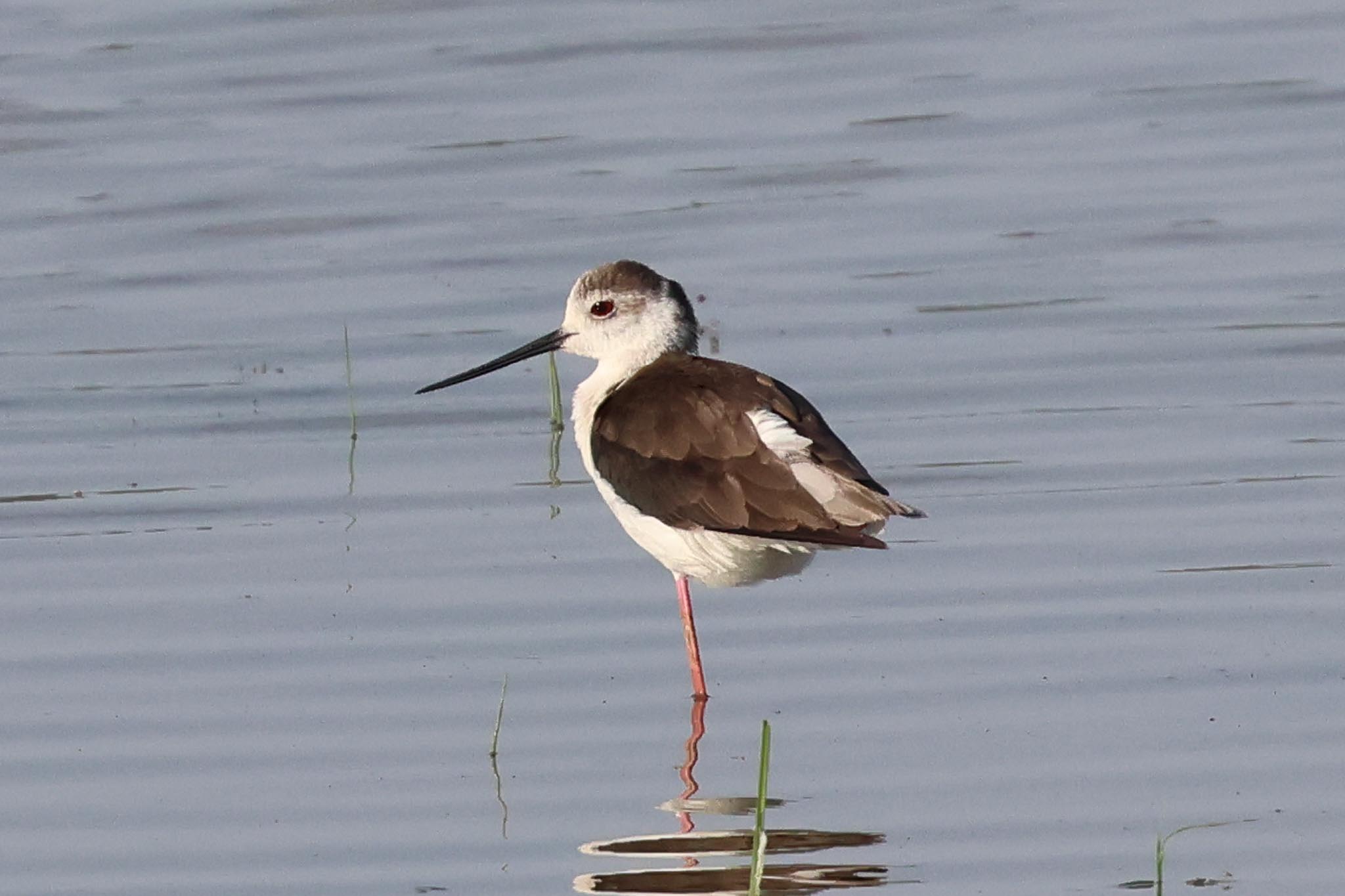
There were birds everywhere now and we didn’t quite know which way to look first. A pair of Ruddy Shelduck were in the water in front of us, along with three shelducklings, and a Spoonbill and a Black-winged Stilt were feeding on the near edge. Further back, there were lots of Mute Swans and a few Greylags, Great Crested Grebes, Coots and a few Common Pochard.
Bee-eaters hawked for insects over our heads now, along with several Sand Martins. Two Little Bitterns flew across and landed low in one of the clumps of reeds out in the lake, but unfortunately didn’t linger long enough for everyone to see. Three more Whiskered Terns flew in and briefly paused to dip feed in front of us and two Pygmy Cormorants flew across further back.
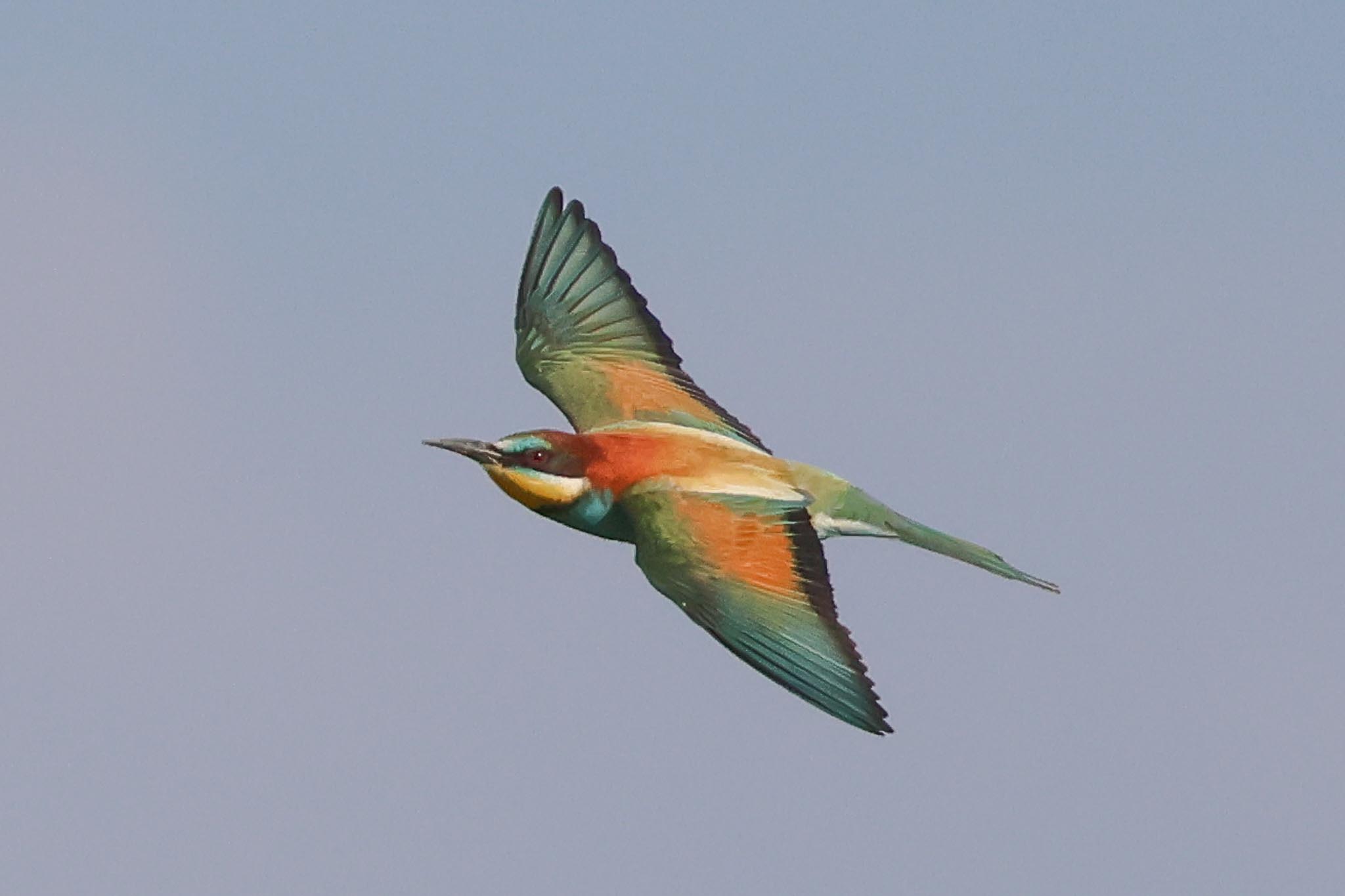
We still had over an hour to our base for the night, so we had to tear ourselves away. There were more Jackdaws, of the eastern race soemmeringii, in the villages now as we drove on through the Dobrogea and it was It was 8pm by the time we arrived in Tulcea and boarded our floating hotel where we would spend the next five nights. A few Caspian Gulls dropped onto the river beyond for a quick bathe. After a welcome cherry schnapps, and allocating of rooms, we headed back up to the dining room where we ate a delicious dinner of traditional soup, followed by grilled zander and local pastries for dessert, all against the backdrop of the setting sun over the Danube. Then it was time for bed, after a long and tiring day travelling.
Wednesday 31st May
After a wonderful breakfast of cereals and local yoghurt, ham, cheese and fried eggs, we boarded the smaller boat which would transport us around the Delta and, after waiting for a couple of large cargo boats to pass, we set off downstream along the main Danube channel. After recent rains, the river was high and fast flowing, something we would notice throughout the Delta this morning. There were a couple of Caspian Gulls flying around over the river, and several Common Terns along the shore and we stopped to look at a Little Owl sunning itself on the gable end of a house on the far bank.
It always seems strange to see Goldeneye this far south at this time of year, but there is a small isolated breeding population to the north of the Black Sea and two or three came up off the river ahead of us. Cuckoos swept through the riverside poplars, where a Golden Oriole fluted from somewhere in the trees and the first Hobby of the day was perched on a nearby pylon.
We turned off the main branch of the Danube onto the smaller Mila 36 side channel and cut the engine, drifting for a while so we could listen to all the bird song. A constant succession of Kingfishers flew in and out from the banks and seemingly endless Cuckoos called or flew through the trees. At first we could hear Chaffinches, Chiffchaffs, Blackcaps and Common Nightingales all singing. Several Collared Flycatchers were calling from the trees and we had a brief glimpse of one in flight. Our first Eastern Olivaceous Warblers were singing too, a sound which would accompany us for much of the day, even if they were always hard to see, and a couple of Common Redstarts perched up more obligingly on dead branches on the tops of the trees.
Turning onto another channel, we could see a smart male Collared Flycatcher perched out on a dead branch ahead of us, although it flew off before we could get closer, and then an Icterine Warbler singing from a similar perch which waited until we could get almost alongside. There were two or three Thrush Nightingales singing now, their song subtly different from their Common cousins, with more clicking and grating phrases.
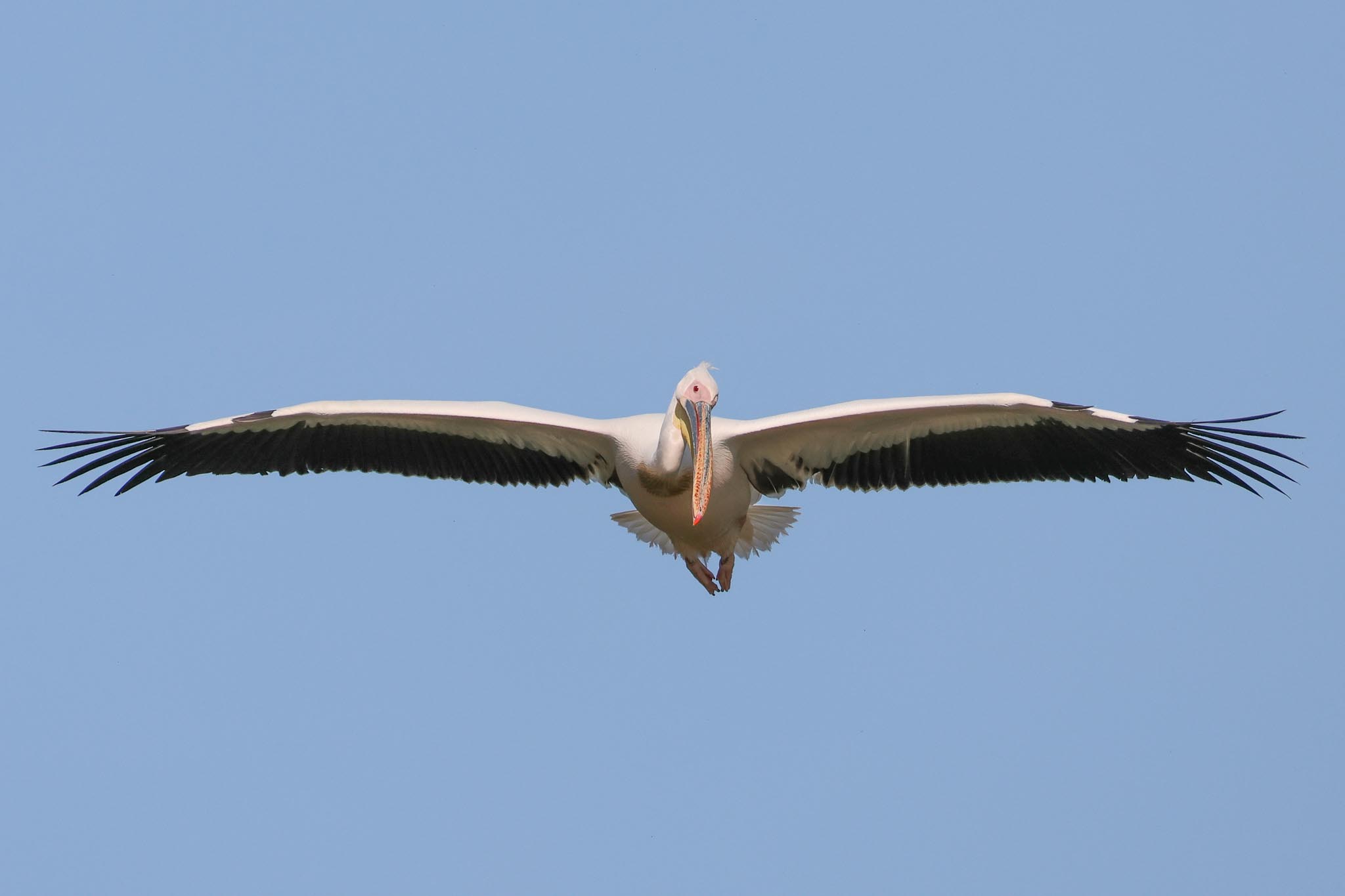
Our first Night Herons flapped up out of the riverside vegetation as we approached, a couple of Pygmy Cormorants flew high over us and a White Pelican, which had probably been flushed by another boat ahead, flew straight towards us and past at low level. One of the group in the front of the boat spotted a majestic adult White-tailed Eagle perched in a tree above the channel, which let us drift almost right up to it before it eventually took off.
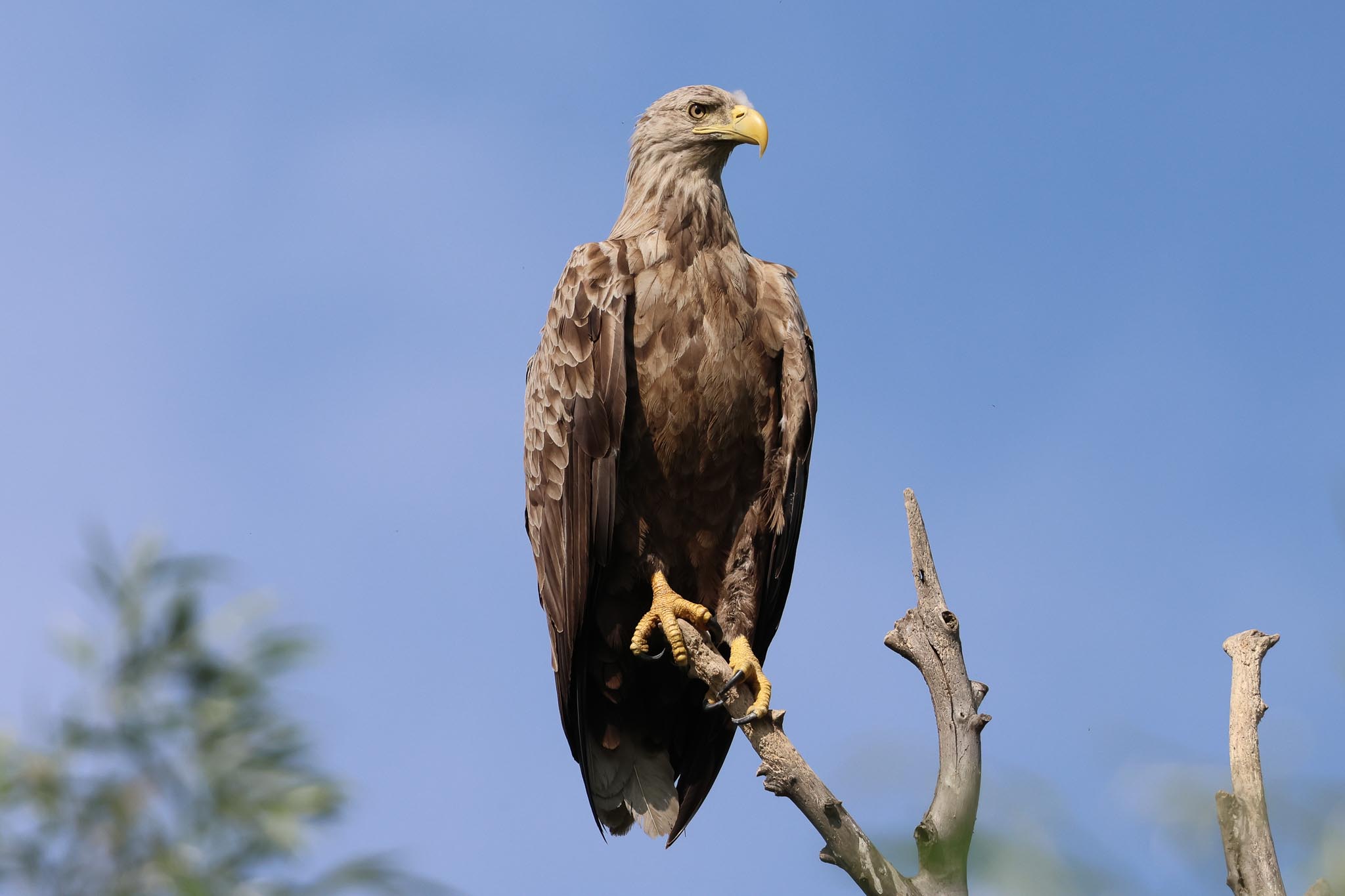
We turned through a gap in the reeds into a small lake, where we found a couple of Red-necked Grebes, looking very red-necked in their smart breeding plumage. There were several Great Crested Grebes too and a large raft of Common Pochard flew up ahead of us and circled round. We could hear frogs calling and see lots of heads poking out of the water in the middle. A pair of Whiskered Terns were hawking round over the lake and as we turned to go back out, one of them was standing on a nest in a small patch of weed on the surface.
Turning into a second small lake, we found another pair of Red-necked Grebes with a couple of stripy headed chicks and a striking male Red-crested Pochard with rather bleached-blonde highlights. A pair of Ferruginous Ducks disappeared off through the trees, and another White-tailed Eagle flew in over the reeds at the back and swept low down to the water, scattering everything ahead of it.
Turning onto a wider channel, there were several bronze adult Glossy Ibis feeding in the open rushes at the bottom of the bank and a succession of photogenic Squacco Herons. A Garganey flew up and off across the channel. A Roller was perched in a low bush and flew off as we passed, flashing bright turquoise and purple. At the next lake, we paused to admire a Spoonbill on its nest, below a tree packed full of nesting Cormorants. There were birds everywhere this morning, so many we didn’t know where to look at times.
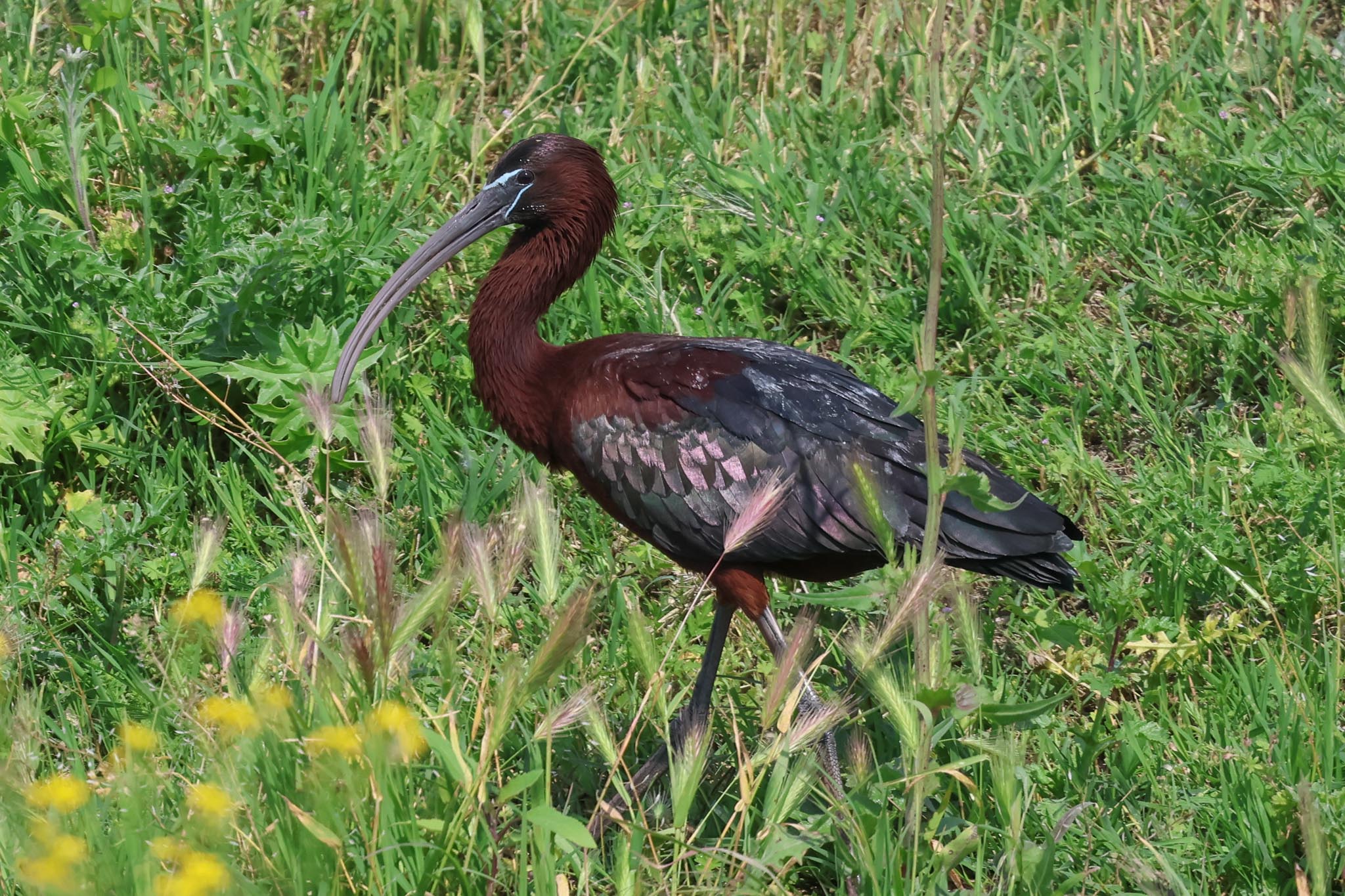
While we supped our morning coffee, we continued on along the channels. We had already heard the croaking song of several Great Reed Warblers, and now we stopped to watch one singing from the dead branches on the edge of a willow bush. It was good for raptors here, yet another White-tailed Eagle perched in the tree above as we sailed below and several Hobbys dashing through the trees. We had just passed Lake Nebunu, when two Lesser Spotted Eagles drifted over and our first Honey Buzzard flew high overhead too.
We stopped to look at a classic adult Caspian Gull, which was standing obligingly on the bare spoil heaped on the bank from a recent dredging of the channel, along with a crowd of Black-headed Gulls. A flock of four pelicans circling over the reeds nearby included our first Dalmatian Pelican accompanying three White Pelicans – nice to see them alongside each other in flight.
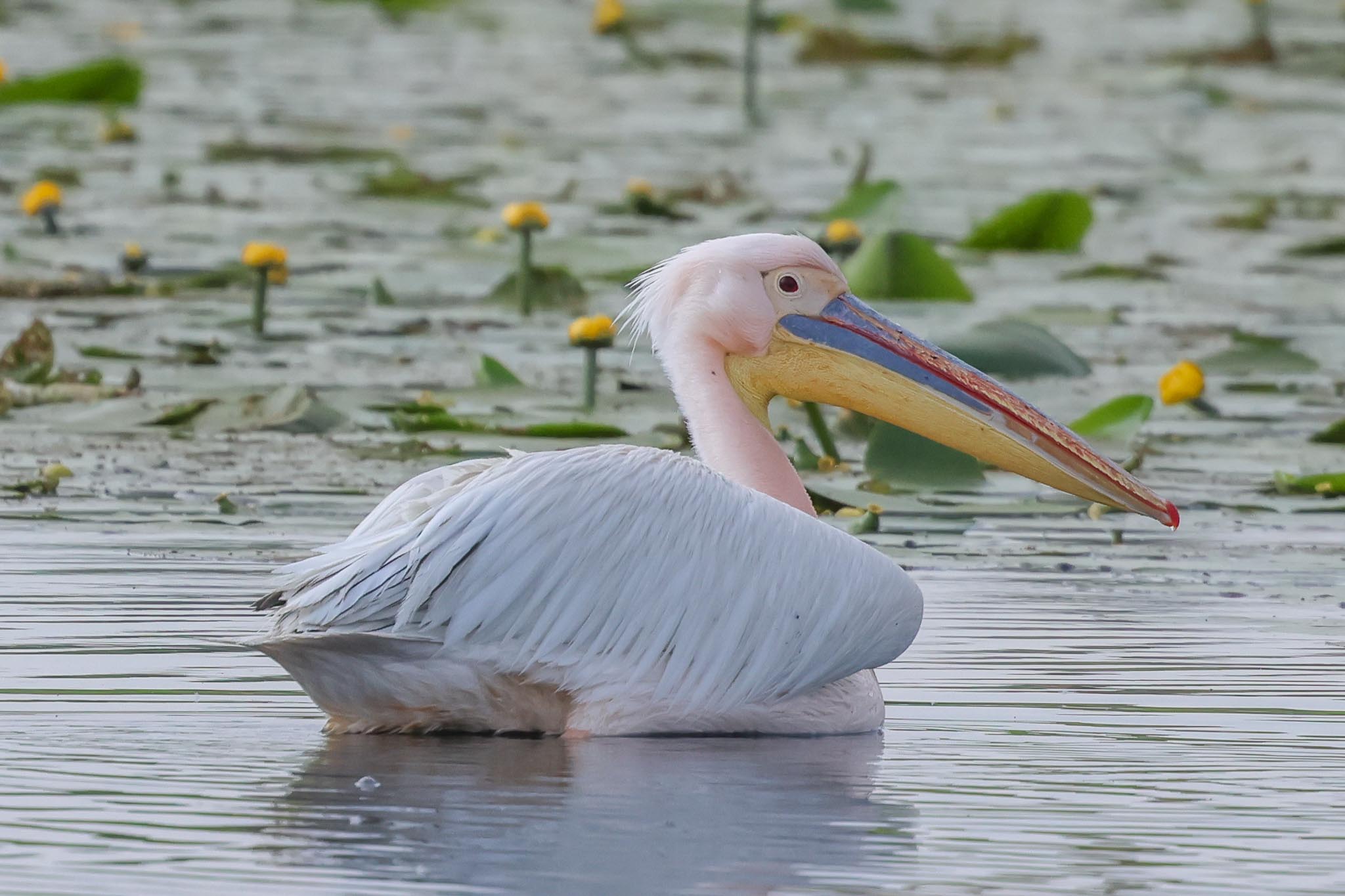
Turning into Lake Furtuna, one of the larger lakes, there was a fresh breeze building. There were lots of Mute Swans and some distant pelicans but as we motored across towards the other side, we noticed a large gull with a black hood come up off the water some way ahead. An adult Pallas’s Gull, it flew towards us, and then banked away – a scarce breeder here and always a smart bird to see (even for non gull enthusiasts!). Everyone was admiring a couple of White Pelicans perched on a log, with a Pygmy Cormorant for company which they totally dwarfed, when Florin picked up two Black-necked Grebes on the water off to our left.
Heading back into the channels on the other side of the lake, we noticed a Stock Dove perched up in one of the willows. They like to nest in old Black Woodpecker holes, so perhaps there might be one around? We hadn’t got very much further when one of the group shouted and there was a male Black Woodpecker low on the trunk of a willow right alongside us. A great view, it tried to hide around the back of the trunk, before eventually flying off back behind us.
We were getting back towards civilization, closer to the main channel again now, and we came across an open area cleared for grazing. With the high water level currently, the grass was flooded along the edge and full of Glossy Ibis, egrets and a single Spoonbill. The scattered trees here were full of Rollers and we had some great views of them now, perched in the branches, swooping round, and even one in and out of a nest hole. A little further on, a Bee-eater swept down to a hole in the sandy bank beside us. Our first Red-footed Falcon, a female over the grassland beyond, was unfortunately heading off into the distance by the time we came out from behind some trees and could get a clear look over.
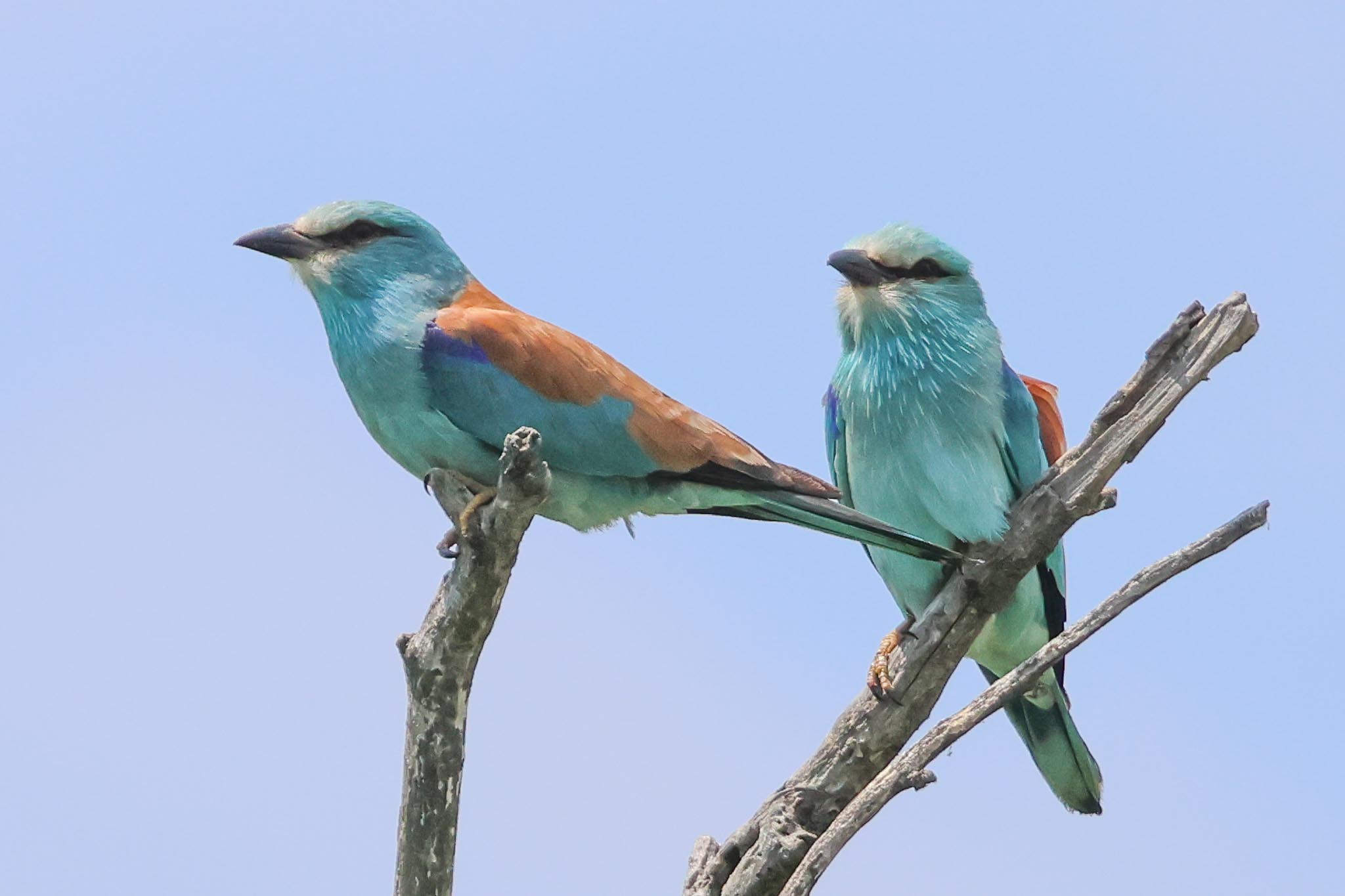
We arrived at the main, wide Sulina channel and we had to wait for a big cargo ship and then a massive cruise ship to both pass before we could pull out. It was just a short distance along the channel before we found our floating hotel, which had been brought out to meet us here. It was time for lunch – soup, then stuffed vine leaves, followed by cake – and while we were eating the floating hotel was towed on further, giving us a wonderful changing view while we ate. There were several White Storks on their nests on the telegraph posts in the village as we passed and lunch was briefly disturbed when two Honey Buzzards and a Black Kite were spotted drifting over the other side. After lunch, we had an hour or so to rest, or admire the view as it passed by. Along the open banks of the Crisan channel, there were lots of herons, egrets and Glossy Ibis and a Lesser Grey Shrike was perched briefly on a tamarisk on the bank nearby as we passed.
At 4pm it was time for another outing on the smaller boat, so we transferred across and set off, heading back the way we had just come and then turning off onto Litcov channel. It was very busy, with a succession of speedboats racing past us leaving behind a wake through which we rocked and splashing up onto the banks. Another White-tailed Eagle was perched in a tree above the channel, with two Hooded Crows in attendance, which pursued it when it eventually decided we were too close and took off. Further up, a Lesser Spotted Woodpecker flew out of the willows and across the channel right over the roof of the boat, which made it trickier to see.
We turned onto a smaller reedy channel which led us out into a big lake. There were lots of Whiskered Terns in one corner, and as we motored over for a closer look, we picked up a single Black Tern hawking with some more Whiskereds at the opposite end of the lake. We sailed in between the islands of lilypads and had great views of the Whiskered Terns now, flying round, landing and collecting nest material.
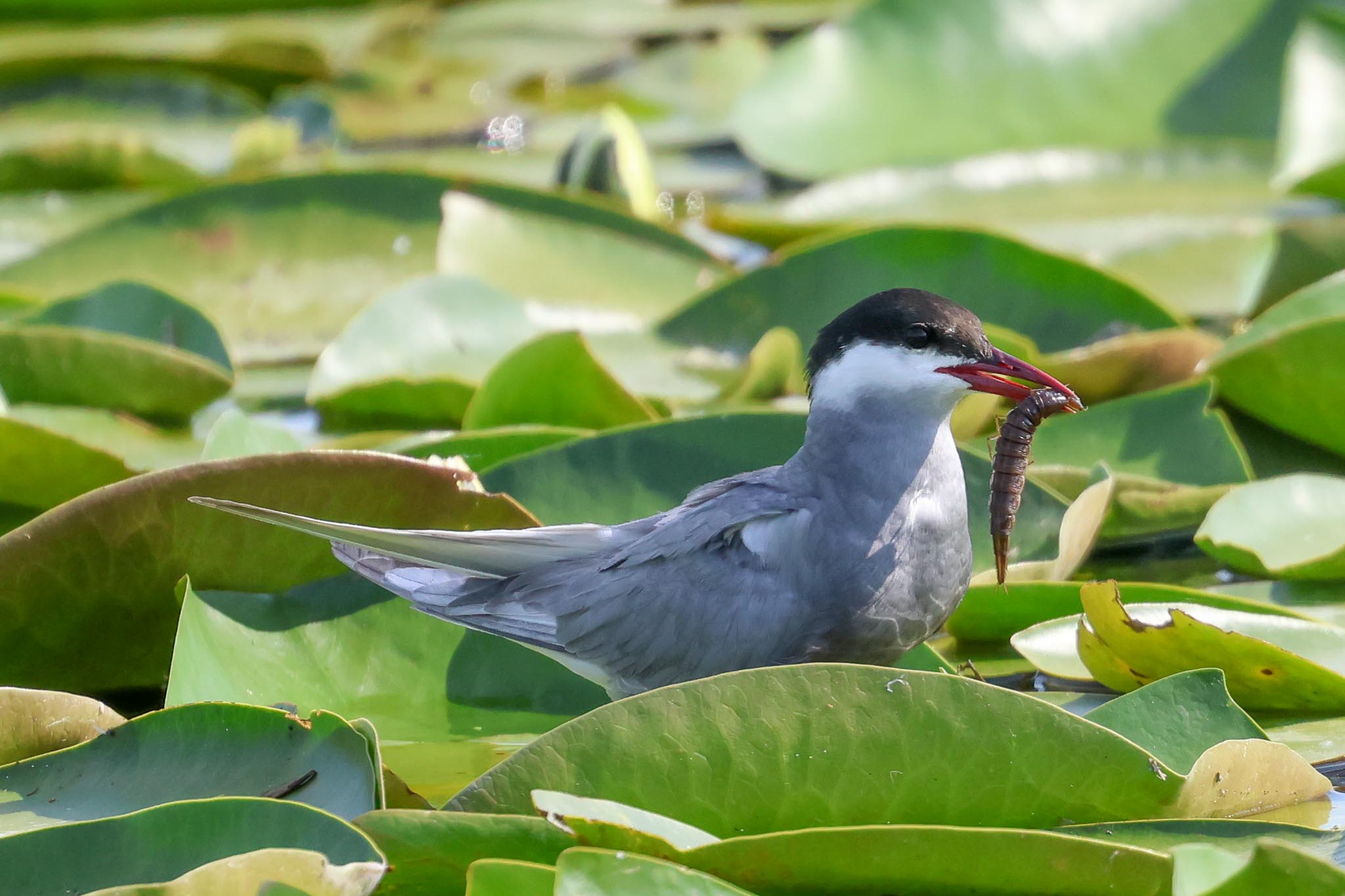
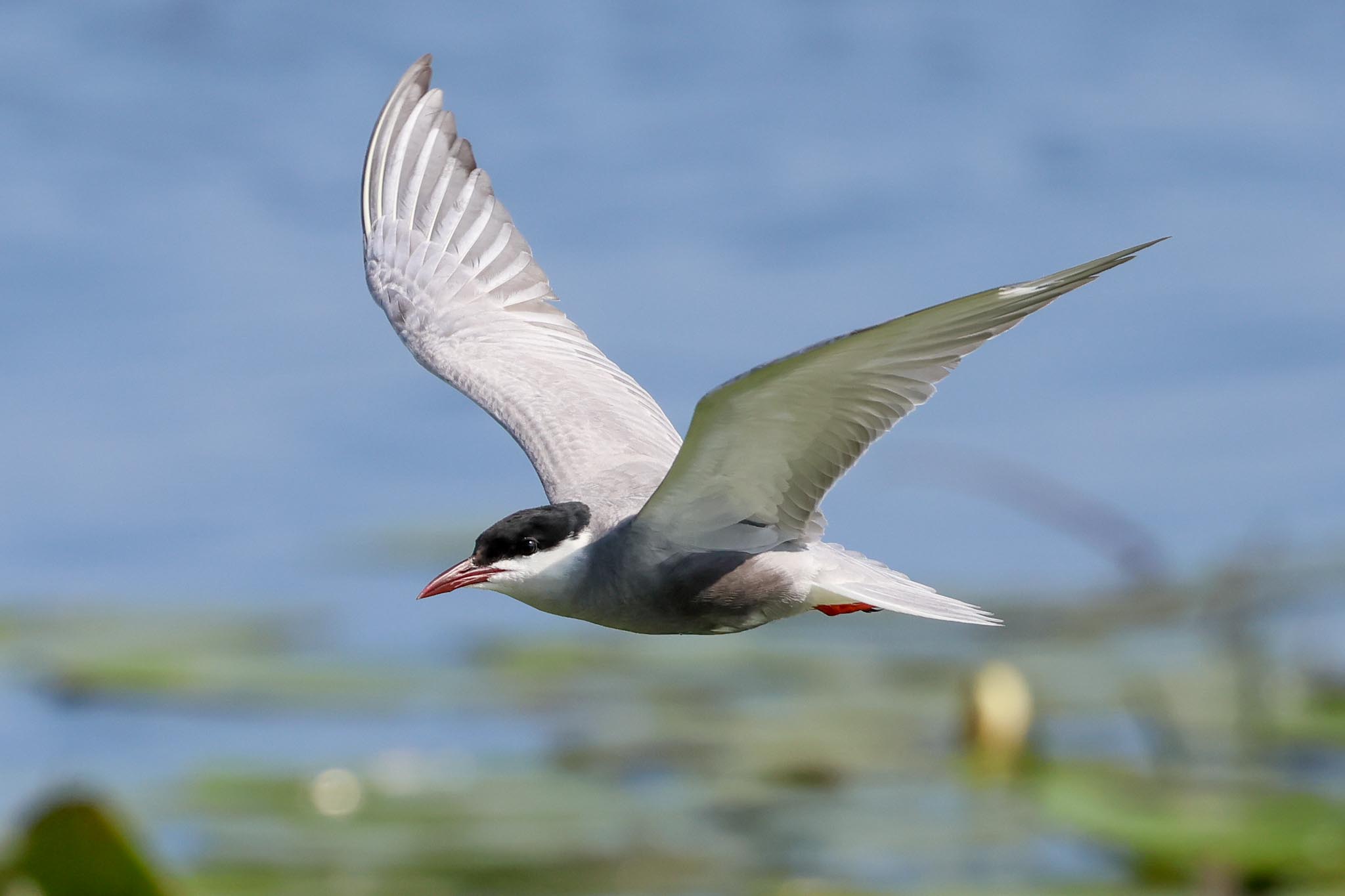
As we made our way back over the lake towards the exit, the Black Tern flew past again, this time a little closer. A pair of Ferruginous Ducks flew over and as we cut in through the reeds a Little Bittern flashed over the channel ahead of us, too quick for anyone but those in the front to see. Along the next channel, a Penduline Tit was calling from the willows and several Golden Orioles kept sweeping in and out of the trees ahead of us – as is typical, they proved all but impossible to see once they landed back in the trees, although we did get a couple of glimpses at one point.
We stopped to look in over the vegetation at a smaller lake by the side of the channel, where another Red-necked Grebe was swimming and a Reed Bunting was perched in the reeds at the back. The Reed Buntings here are of the distinctive larger-billed reiseri subspecies, though it was rather hard to make out any such detail from here.
Continuing on, we found ourselves back out on the main Crisan channel. As we chugged slowly back towards where we had parted company with the floating hotel, several Yellow Wagtails flew up from around the cows which were feeding on the bank and one perched up nicely on a small willow bush. We could see now that it was of the ‘dombrovskii’ form, an intergrade between Black-headed and Blue-headed Yellow Wagtails which is particularly found in Romania, with a dark blackish head and a clear white supercilium which is lacking in pure Black-headed Wagtail. A male Ferruginous Duck feeding in the open rushes along the edge finally stayed long enough for us to get a good look at it before it flew. Fire bellied Toads were calling along the edge here too.
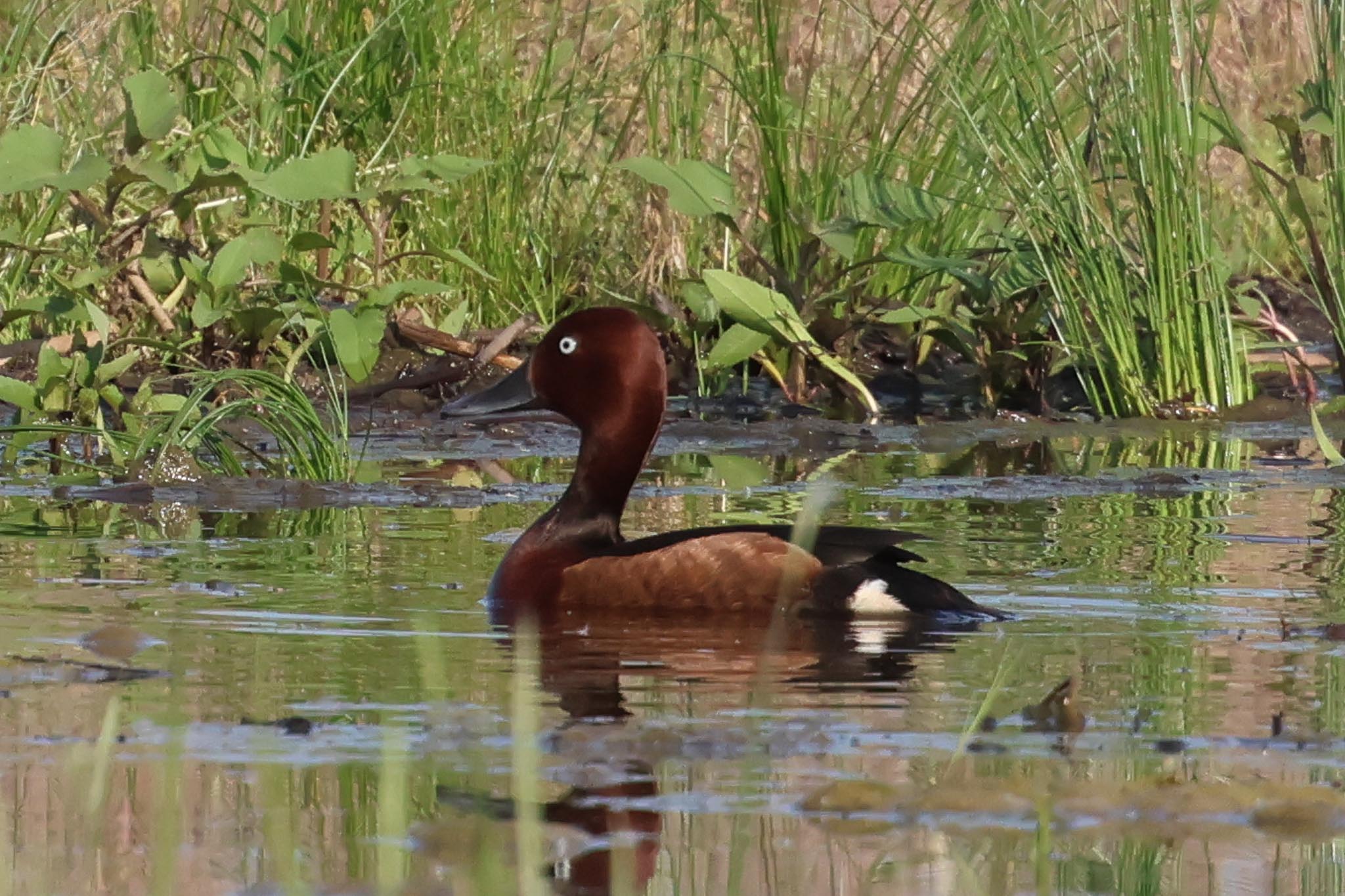
We could see the floating hotel ahead of us now, but we turned off again, the other way now, and took a short loop in towards Lake Iacob. A Grey-headed Woodpecker called from the willows over the channel ahead of us and as we sailed underneath we could see it hiding in some bare branches above before it flew out and across the channel in front of us. We heard a Lesser Spotted Woodpecker calling too, but it remained rather more elusive. At the entrance to the lake, we heard Bearded Tits calling and pulled up alongside, waiting quietly until eventually several dark-lored juveniles came through into the edge of reeds right by us. Pulling out into the lake, we sailed over to admire two White Pelicans and two Dalmatian Pelicans together on a small ‘island’, nice to compare them side by side not in flight.
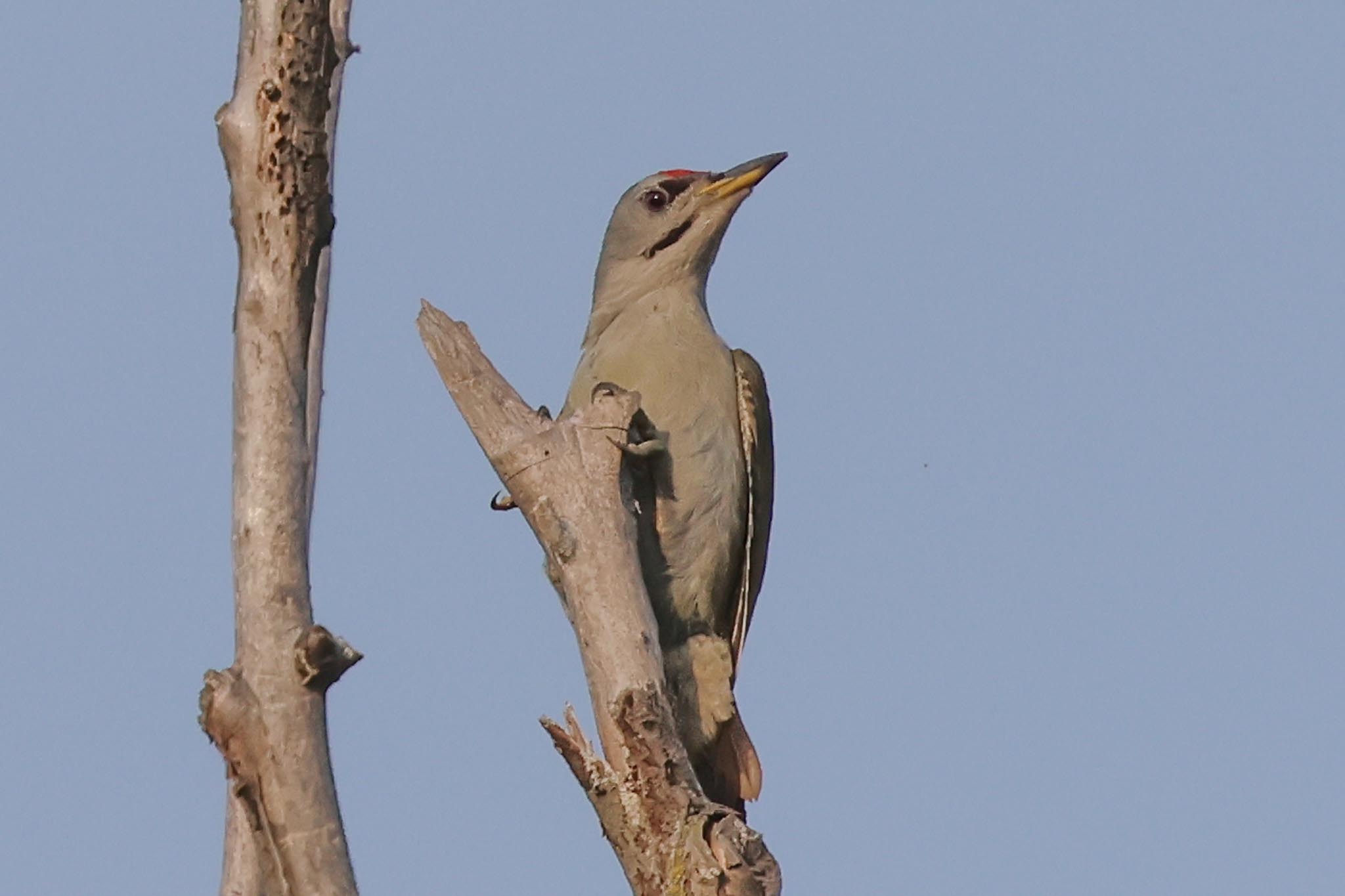
We looped back out of the lake and back down to the Crisan channel. As we neared the floating hotel, the Grey-headed Woodpecker was calling now in the trees right next to it, and as we approached it flew out and landed in a dead tree right next to the top deck. Good views from the small boat, but by the time we had docked and climbed up to the top the woodpecker had flown across the river.
We stood on the deck for a while and admired the view over the marshes beyond. Cetti’s Warbler, Eastern Olivaceous Warbler and Lesser Whitethroat were all singing from the willows beside us, and a Penduline Tit was calling. A succession of Night Herons and Purple Herons flew past and two Black Kites drifted overhead. Three Black-winged Stilts flew across in the distance over the river. In the middle of nowhere, with no one else around us, what a magnificent spot to spend the night!
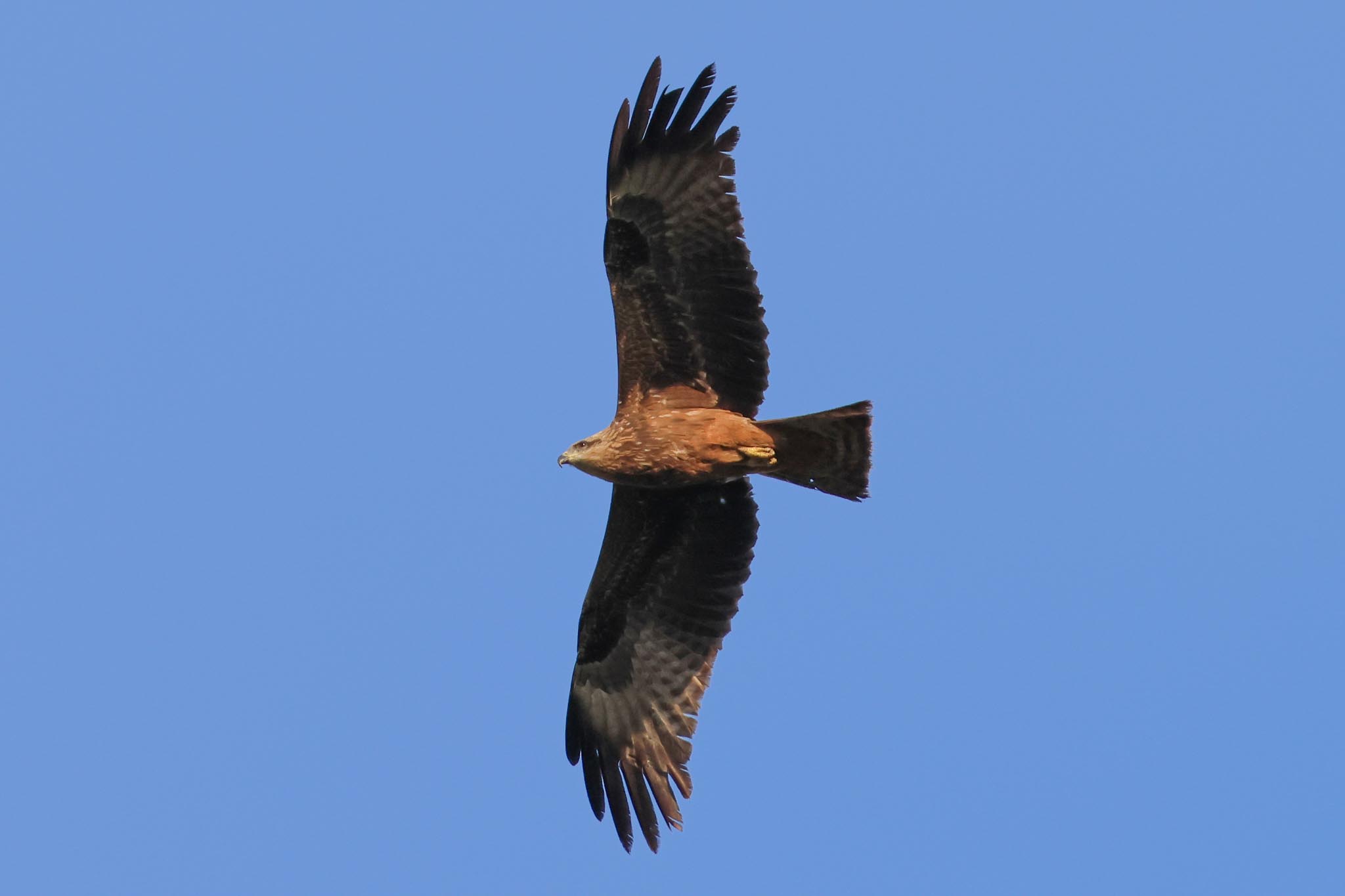
It was time to head in for dinner, another delicious three course meal cooked for us on board. We felt like we had earned it after all the hard work sitting on the small boat birding today! Then time to turn in – it had been an amazing first day in the Danube Delta.
Thursday 1st June
We awoke to the sounds of Bittern booming, Savi’s Warbler reeling in the distance and the Grey-headed Woodpecker calling in the willows again this morning. For the early risers, there was another chance to enjoy the views, with the Lesser Whitethroat and Eastern Olivaceous Warbler singing in the trees next to us.
After a leisurely breakfast, we set off in the small boat again at 8.30am, down along the Crisan channel. A Great Reed Warbler was singing from the outside of one of the willows on the bank as we passed and two Dalmatian Pelicans were on the water ahead of us.
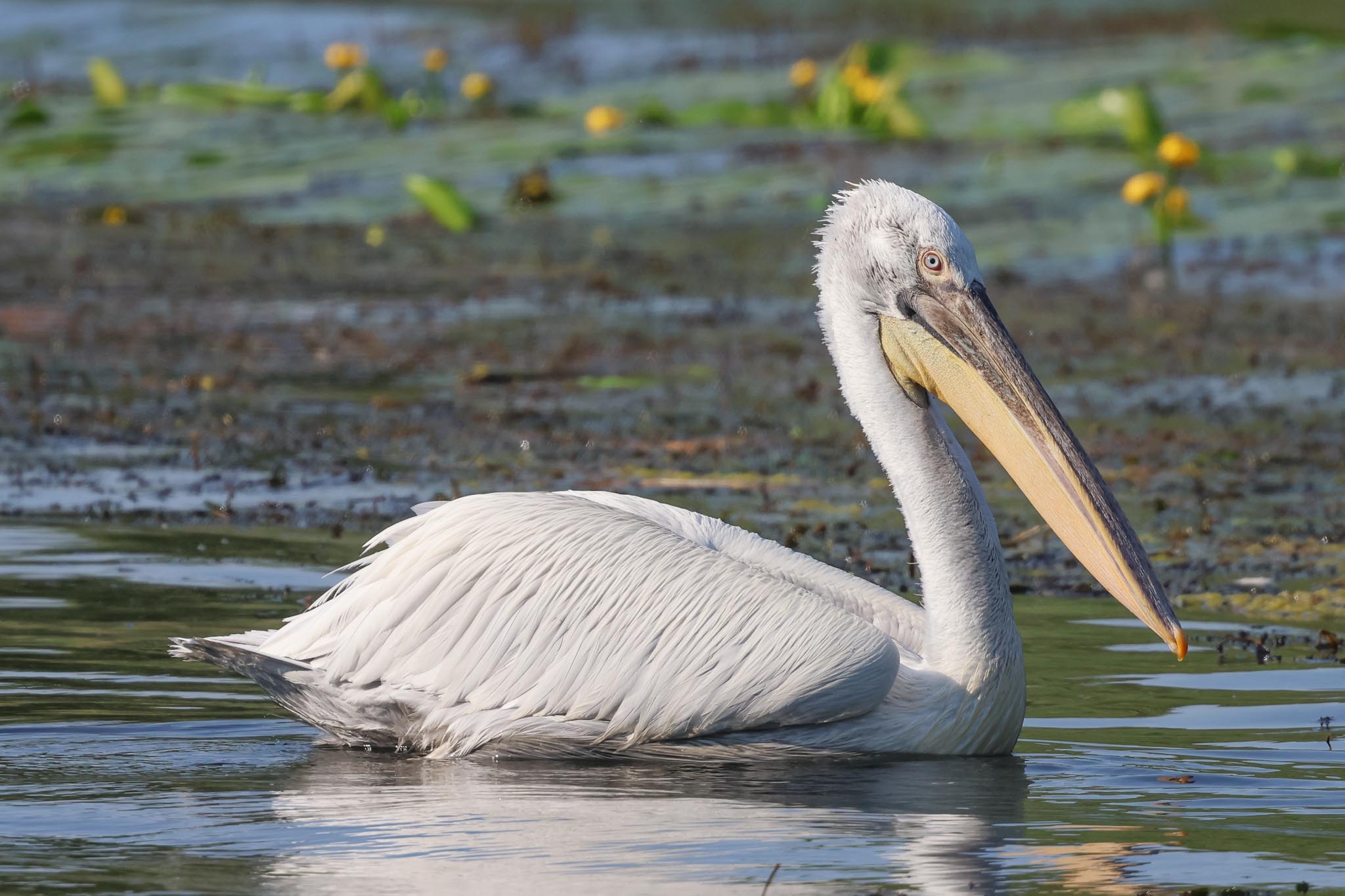
There were lots of Squaccos Herons feeding on the floating vegetation lining the banks and a Green Sandpiper flew over. Further on, there were five White Pelicans and several Pygmy Cormorants feeding in the shallows by a junction in the channel.
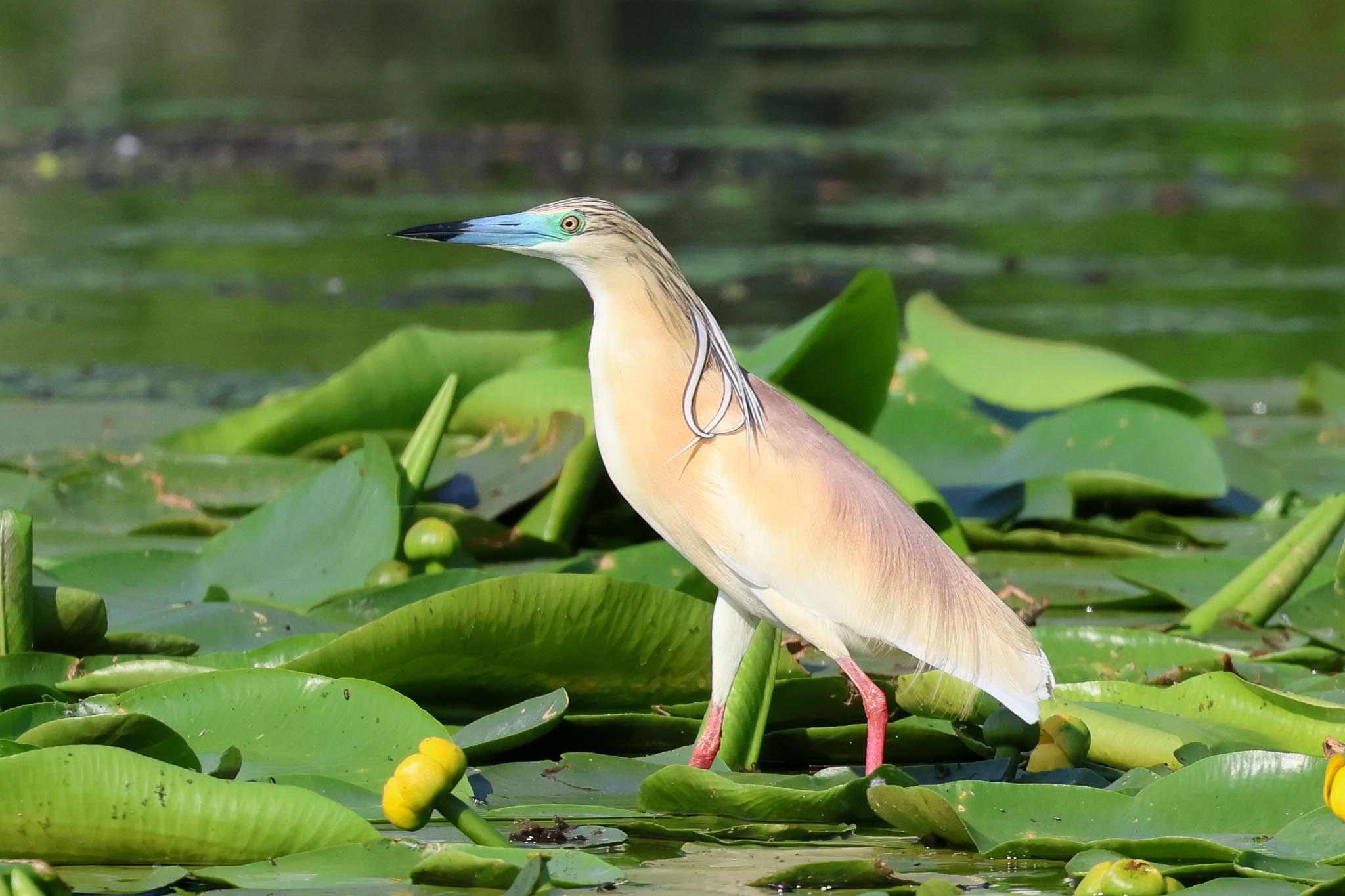
Just beyond, the captain beached the prow of the boat on the bank and we walked down the gangplank onto the land. This area used to be a fish farm before the revolution and is now managed as a nature reserve. As soon as we got up on the bank, we could hear Bearded Tits calling and looked out at the reeds beyond to see a swarm of juveniles climbing up the reed stems. There were at least twenty of them, and eventually a male appeared too, with blue-grey head and black moustache. A Golden Oriole was fluting from the willows off to our right and a Savi’s Warbler was reeling from further back in the reeds. A Bittern started booming behind us and then a second followed suit out in front – stereo Bitterns!
As we walked down along the bank, a Great Reed Warbler was perched in the top of the reeds across the channel below us, so we could get it in the scope now we were on dry land. Another Savi’s Warbler started up and it too was perched up in the reeds and we enjoyed great scope views of that too, with a second Savi’s Warbler then nearby.
There were lots of insects which flew up from the grassy bank as we walked along. Dragonflies included White-tailed and Black-tailed Skimmers, a Scarlet Dragonfly and a couple of White-legged Damselflies, with Eastern Dappled White and Small White butterflies and a Large Skipper nectaring on a marsh orchid. There were various moths, beetles and a rather spectacular large robberfly too.
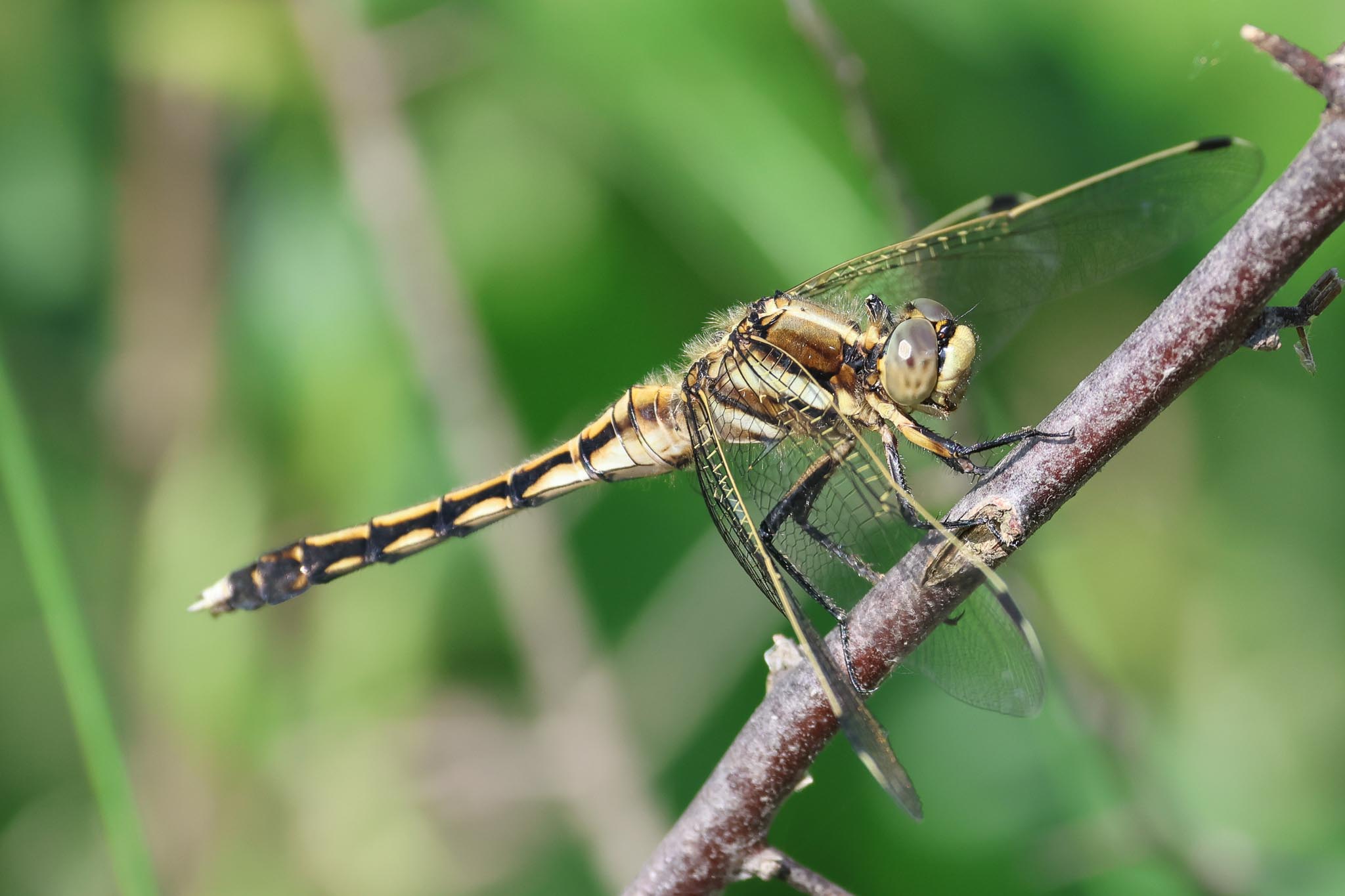
We could hear a Penduline Tit calling in the willows by the channel and eventually one came out giving us great views, with the second staying deeper in the tree. Further up, when we heard another Penduline Tit calling on the reedbed side of the bank, we could go round to look at the far side of the willow and found the Penduline Tit’s amazingly constructed nest hanging down from a thin branch over the reeds.
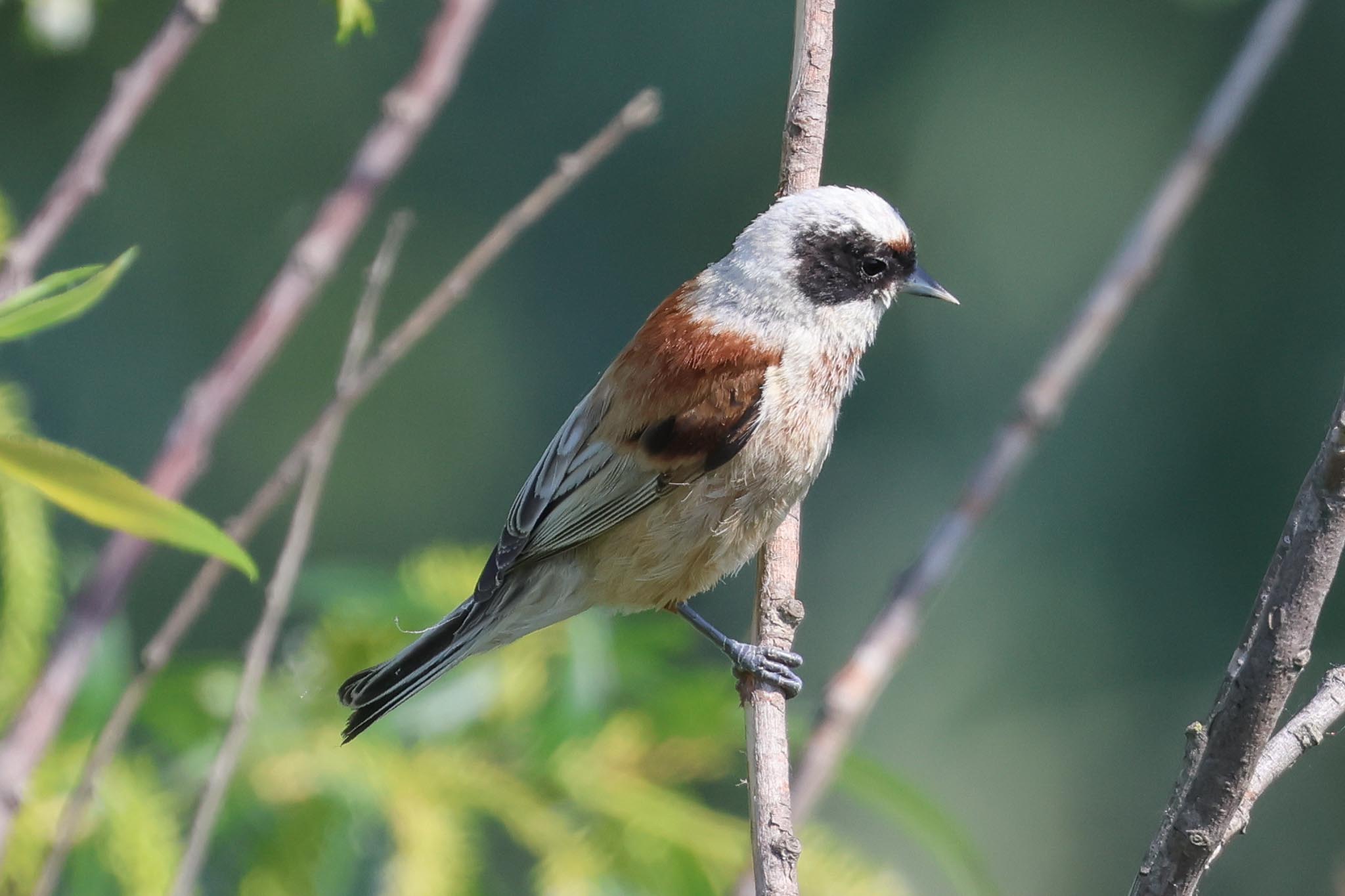
A Little Crake started calling from the edge of the reedbed below us now, but with dense vegetation at the base of the bank, there was no chance of us being able to see it here. Interesting to hear it though. There was a large pool in the reeds beyond here and looking out we could see a pair of Red-necked Grebes with a couple of stripy-headed juveniles riding on one of their parents’ backs, and several Great Crested Grebes beyond. A drake Red-crested Pochard and a pair of Garganey flew off past us.
We made our way slowly up along the bank but it was getting hot and open to the sun here. A couple of Lesser Whitethroats were skulking in one of the trees on the bank. Thankfully, our boat had gone on ahead after we disembarked and met us here now, so we didn’t have to walk all the way back where we had just come.
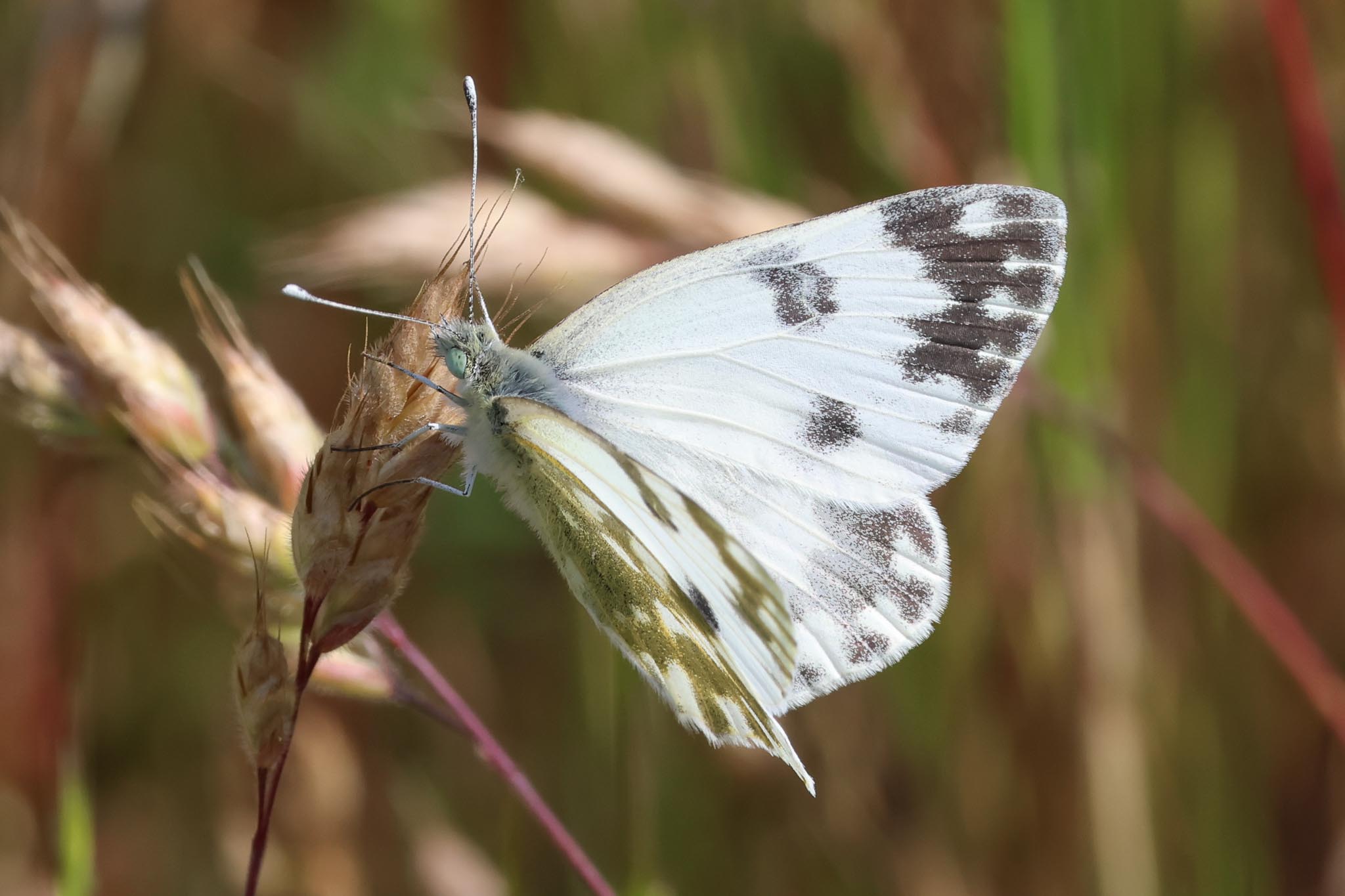
As we sailed on, the channel here was very narrow, with reeds close in either side, and more Bearded Tits, Penduline Tit and a European Reed Warbler flew out ahead of us motored slowly through. Then when we got back out onto a slightly wider channel, out of the overhanging vegetation, it was time for coffee. We made our way round and back out onto the Crisan channel, turning down towards Caraorman village, where a Hoopoe flew across in front of us.
There were lots of boats down at the jetty by the village – it was a public holiday and people were coming here from Bucharest to visit the village and eat the local fish soup. We stopped to have a look at the pools in the grass beyond the jetty, where there were lots of Black-winged Stilts, some on the nest, a few Lapwings and a single Avocet. Several Bee-eaters were flycatching from the wires behind the pools and we got a distant Roller in the scope. There were several White Stork nests on telegraph posts on the edge of the village, the nearest with the heads of three young showing above the rim.
While all the Romanian tourists headed straight for the village, we headed off in the other direction and made our way through the crumbling remains of the former Soviet-era glass factory. A Crested Lark was calling from somewhere off to our left and a male Northern Wheatear was perched in the shade of a bush growing out of the top of one of the on walls, where we could get it in the scope. A female flew round below, then the male dropped down onto a pile of concrete blocks in the middle of the ground below. A Hoopoe flew in and landed on the top of the wall, where the Wheatear had been earlier, allowing us to finally get one in the scope for those who had missed the ones flying earlier.
We continued on and out onto the grass beyond to look at the pools. A Spoonbill was feeding in a small flooded area close by and stopped to watch us as we walked past. A pair of Shelduck dropped in, the first we had seen on this trip, and several Black-winged Stilts flew back and forth between the pools calling.
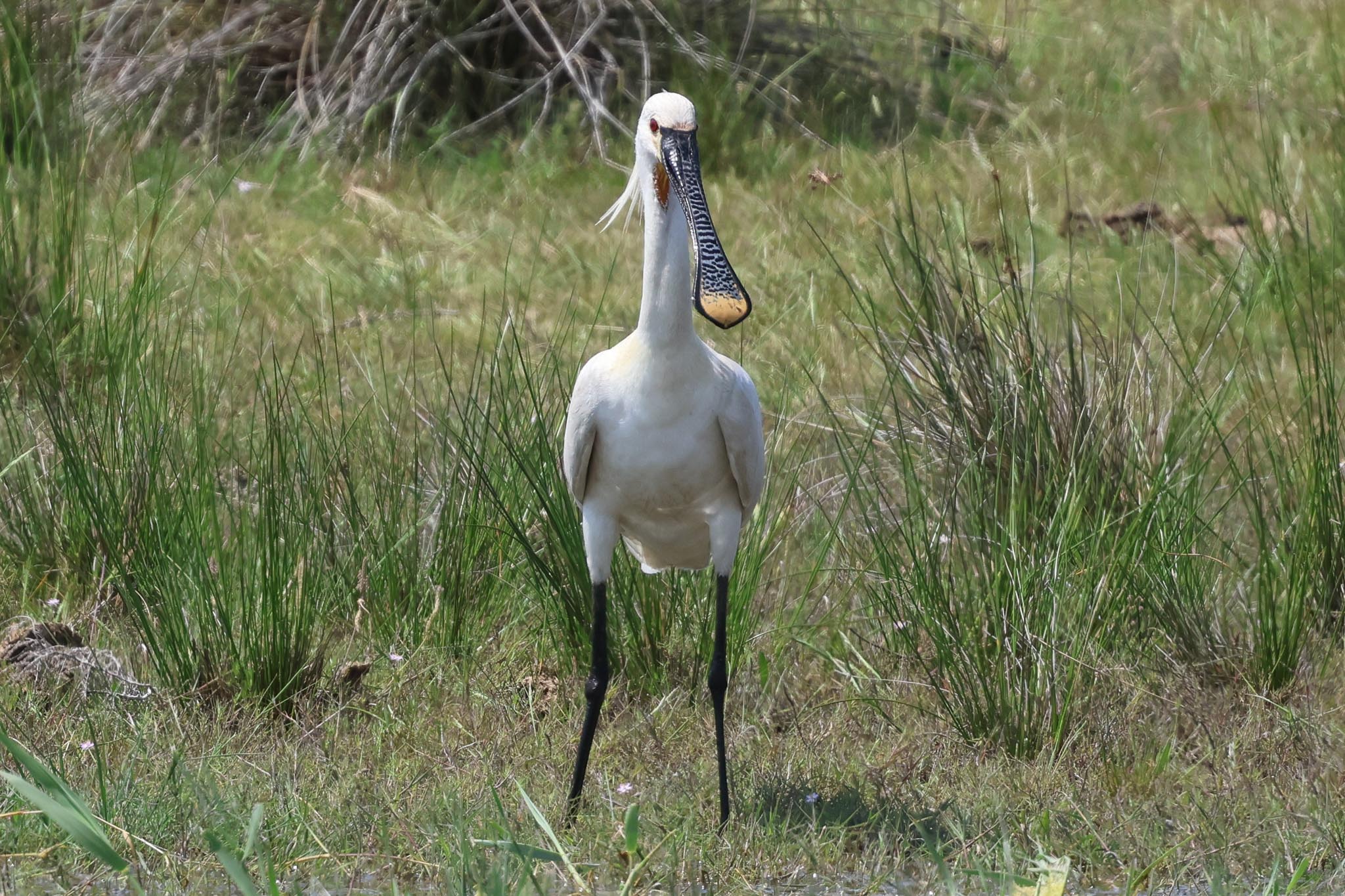
We climbed up onto the bank in order to see down into the pool beyond, but there didn’t seem to be much on here at first. A single Grey Plover was on the far edge with two more Black-winged Stilts and there were a few Caspian Gulls, Black-headed Gulls and a couple of Common Terns. Several Bee-eaters were flying round some low sandy cliffs in the bank, where they had been digging their nesting burrows. Continuing on a little further along the bank, we found three summer plumage Little Stints on the edge of the pool too.
On to the next corner, we stopped to scan more pools beyond, where there were more Black-winged Stilts and Avocets and two distant Black-tailed Godwits here too. We could see at least five Collared Pratincoles but they were very distant, right at the back of the pool. Nice to see but we were hoping we might get better views tomorrow.
It was hot out here on the bank now, so we decided to walk back to the boat. As we motored back up Crisan channel, another Collared Pratincole flew over ahead of us and disappeared away over the fields beyond. Three Hoopoes flew along the bank alongside us, occasionally landing in a bush before moving on as we approached. It was lunchtime by the time we got back to the floating hotel, so after a quick break to freshen up, we sat down to another delicious three course meal. After our walk today, we felt more like we had earned it!
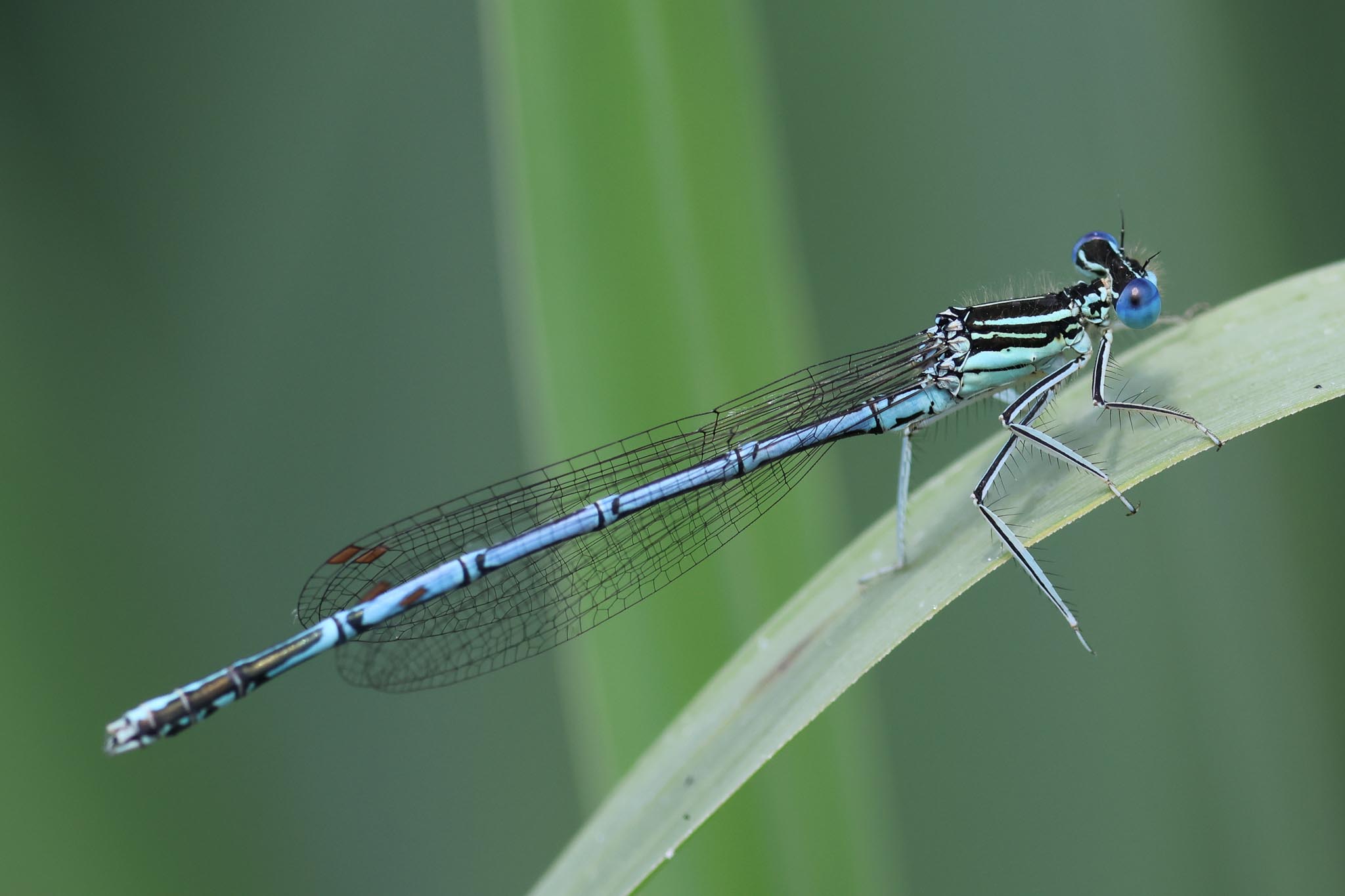
No time for a siesta today, as we would be heading north on the floating hotel this afternoon. First, we headed out again after lunch for a short ride on the small boat to explore the floating reedbeds nearby. It was the heat of early afternoon and there were not many birds along the channel, before we turned in to a small lake and Florin explained to us a little about the interesting biology of the floating reedbeds. Then it was back the way we had come to the floating hotel, which was then towed off on the way to our new destination for tonight.
As we made our way back up the Crisan channel, the Lesser Grey Shrike was back where we had seen it the other day, on the base of a pylon now, and everyone got to see it this time. There were lots of herons, egrets of various sizes and Glossy Ibis feeding on the wet meadows by the channel and another ‘dombrowskii’ Yellow Wagtail on the sandy bank. A Little Ringed Plover flew past and landed on the shore.
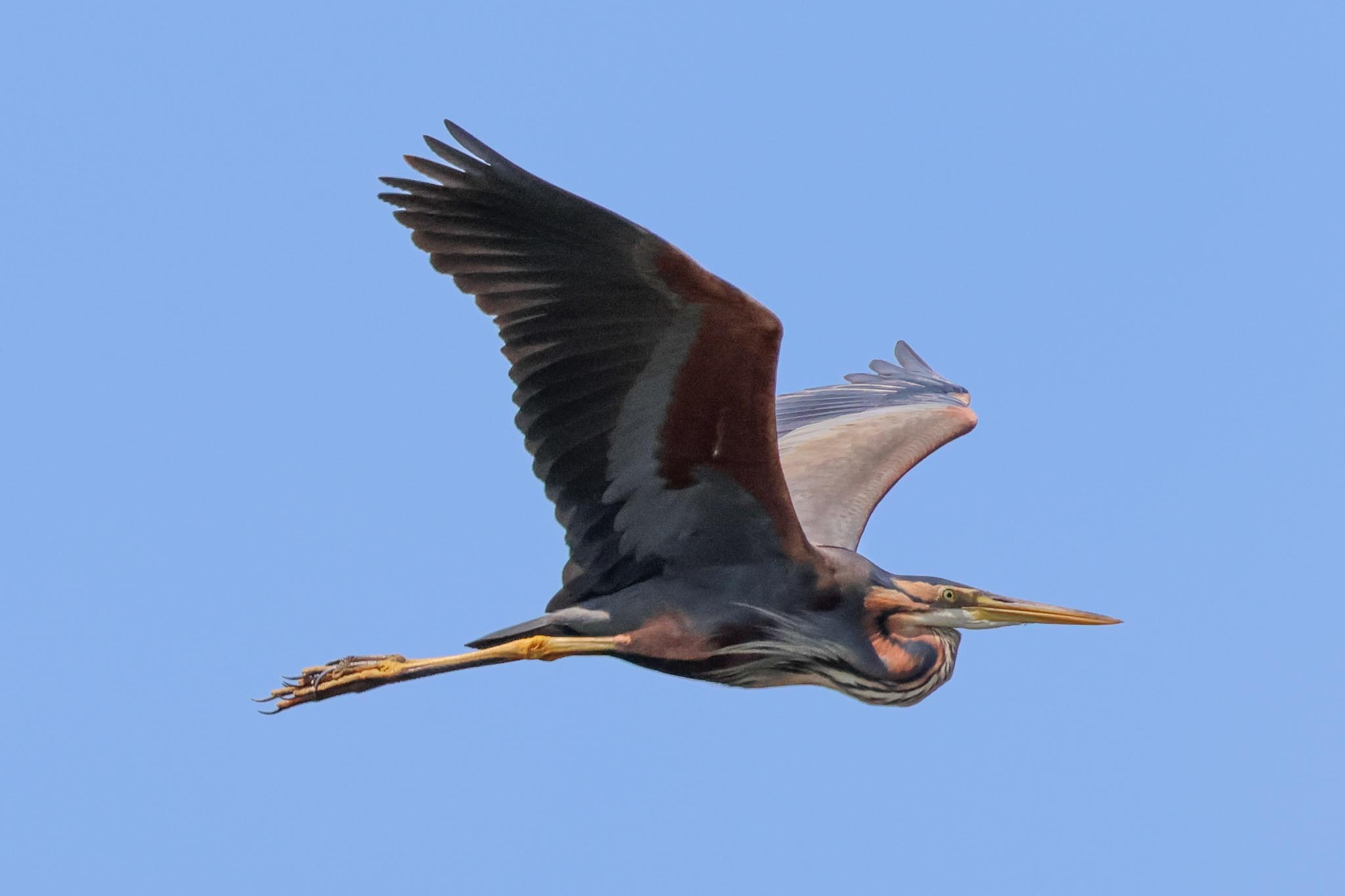
With more trees lining the channel further up, there were fewer birds and soon we were back in civilisation, with houses along the banks as we approached the main Sulina channel again and Crisan village. We were just out of the village and chatting in the dining room when Florin spotted a Golden Jackal on the far bank. We raced out to the rest of the group who were on the deck and managed to get everyone on it before we passed. Little did we realise, it would not be the only one we saw.
The convoy turned onto the old Danube branch of the river, where a number of Caspian Gulls were patrolling along the edge of reeds, occasionally dropping down to the water to pick at something. Scanning ahead, we picked up a Pallas’s Gull too but it was still some distance in front of us and flew away over the reeds before we got to it.
The area to the east of here is the largest reedbed in Europe, stretching all the way to the coast. From up on the top deck we had an amazing view looking out over mile upon mile of continuous reeds, only interrupted by the occasional group of trees. But looking over the bank the other side of the old river, we could see a huge area of farmland with massive irrigation booms, a strange juxtaposition in the middle of such an important wetland and biosphere reserve, and the area which is ostensibly supposed to be fish ponds. What impact could all the irrigation and pesticide and herbicide use be having on such a sensitive surrounding area?
We continued a short way further on, and then tied up here for the night. Another fantastic location – we could hear Savi’s Warbler reeling, several Great Reed Warblers, with some perched in the reeds out from us, and a European Reed Warbler singing below us. Several Cuckoos were calling, a Bittern started booming and a Penduline Tit was calling from a line of willows nearby. A male Marsh Harrier patrolled over the reeds in front of us. It was time for dinner, and as we sat down to eat we could watch the sun setting over the river from the windows.
Friday 2nd June
The sun rose over the reedbed and we were still surrounded by all the same birds singing, as we were last night. Quite a dawn chorus! After breakfast, we set off on the small boat again and we quickly turned off the old Danube and up the channel towards Letea. There were Rollers in the willows along the sides and a Hoopoe perched up more obligingly as we passed. We were early enough to beat the tourist boats and a seemingly endless succession of Purple Herons came up from the reeds, along with numerous Pygmy Cormorants and a couple of Dalmatian Pelicans up off the water.
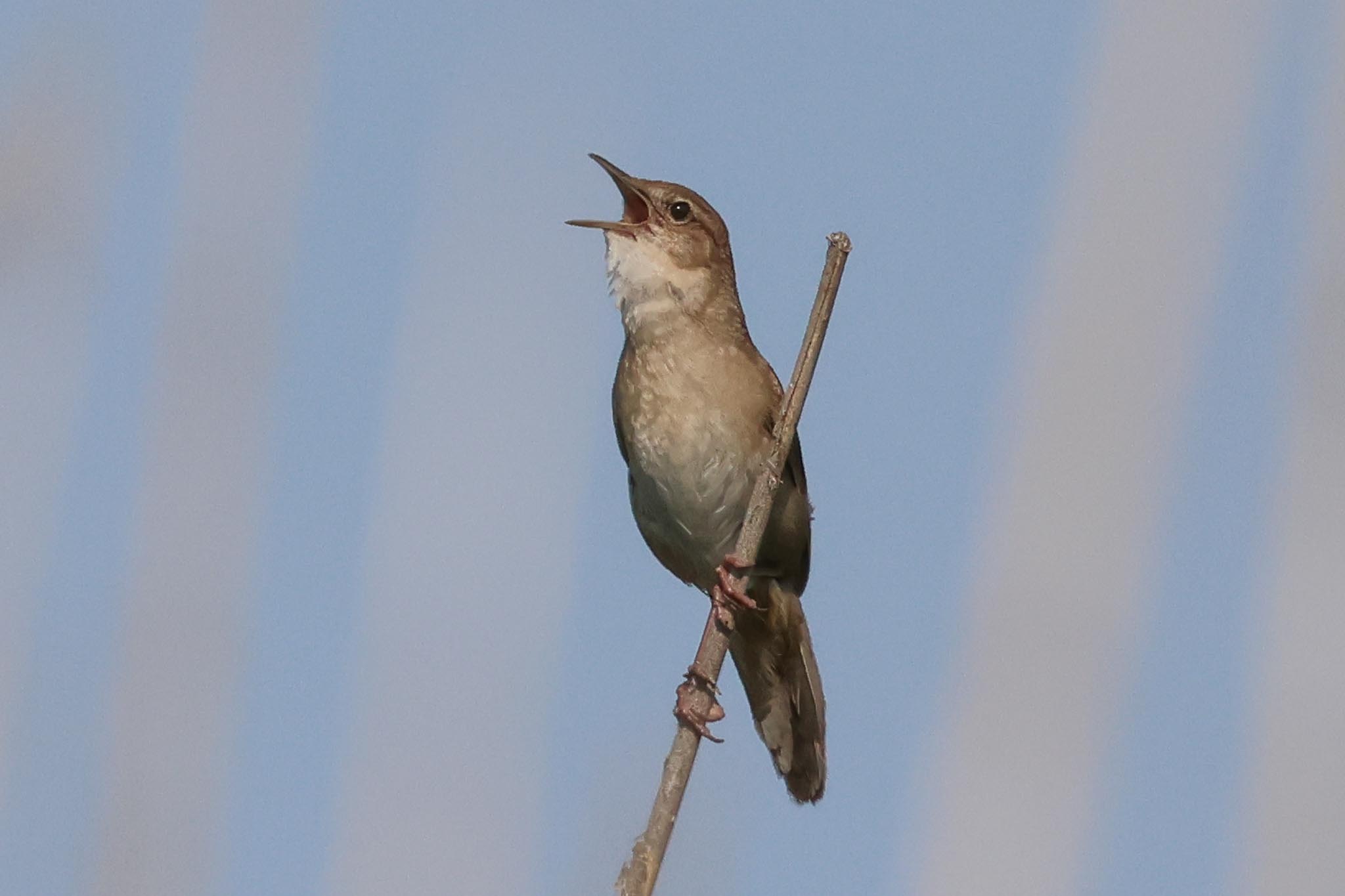
There were lots of warblers singing, particularly good numbers of Savi’s Warblers reeling here, and we stopped to look at one obligingly perched on the top of a tall dead reed stem close to the channel. We had a nice view of a drake Garganey too, as it flew up from the water and back past the boat.
We were almost into Letea when the captain shouted and killed the engine. A Golden Jackal was on the bank right next to the channel! Great views just a few metres away, as it turned to watch us drifting past.
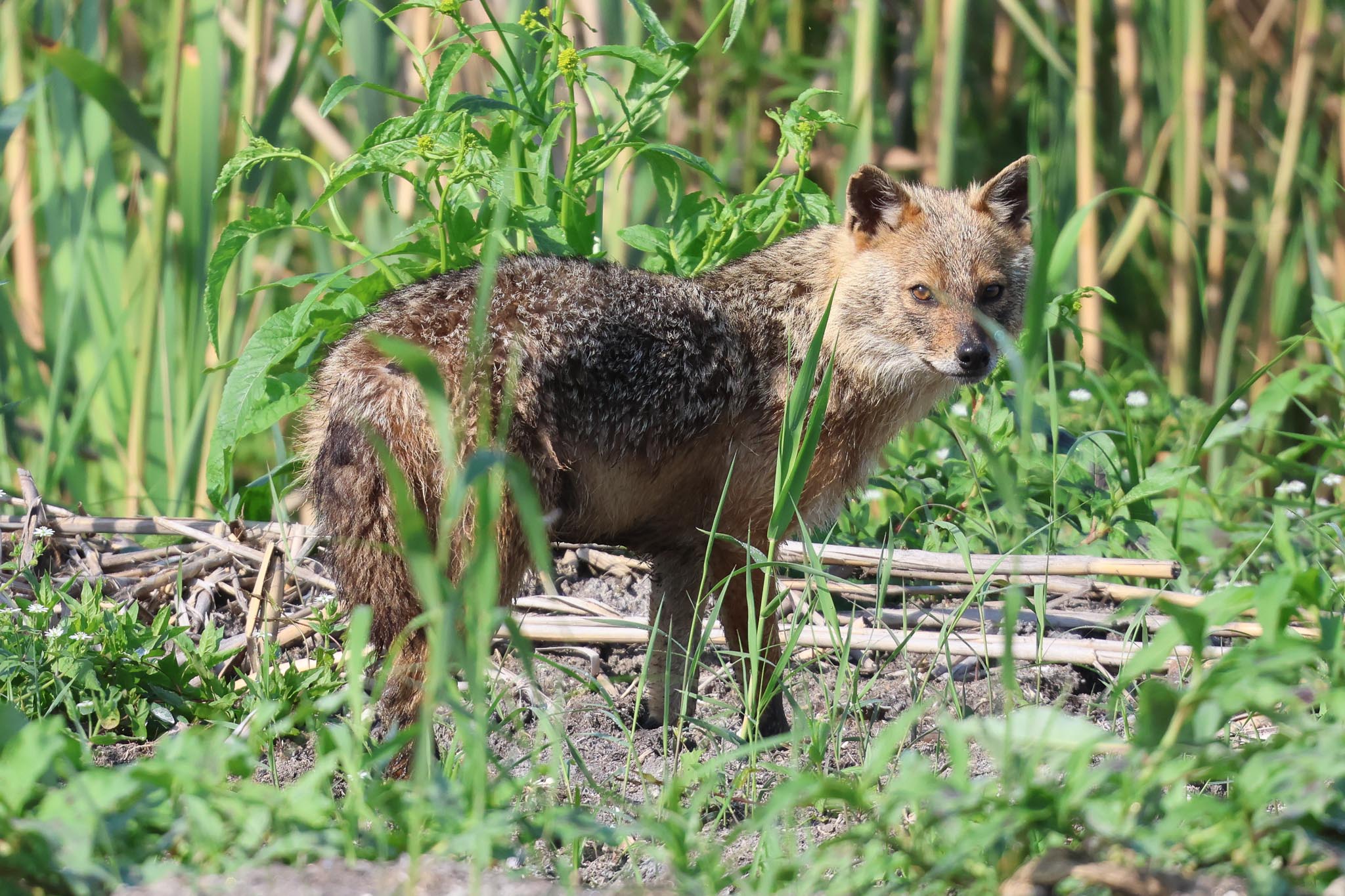
The boat dropped us off just before Letea, on the bank on the edge of the village. There were lots of Sand Martins around the bank on the opposite side of the channel and lots of herons and egrets feeding on the flooded grass below the bank on our side, along with several Garganey. As we set off along the bank, we looked over towards the village and could see two Red-footed Falcons distantly on the wires, and lots of Bee-eaters.
A Yellow Wagtail was singing from the a low bush in the rushes below the bank, so we got it in the scope. A ‘dombrowskii’ again, but nice to see one not from a moving boat, and another male singing a bit further up. A male Red-footed Falcon flew past and started hovering out over the flooded grassland. Scanning the shallow pools out in the grass, we could see lots of Black-winged Stilts, a couple of Black-tailed Godwits, lots of Collared Pratincoles and a single Little Ringed Plover, but they were all rather distant. Two White-winged Black Terns flew past but were only seen by the laggards who had stopped to look at the pratincoles in the scope.
The saltpans the other side of the bank were mostly dry but still held some water in small pools. An adult Pallas’s Gull was loafing with some Caspian Gulls on one of them, a nice size comparison, we got it in the scope before it took off and flew past us. A pair of Ruddy Shelduck were arguing with a pair of Common Shelducks down on the near edge, the latter protecting their brood of small shelducklings.
A couple of distant Kentish Plover were very well camouflaged out on the dry mud beyond but two Little Ringed Plovers were much closer and easier to see. A small group of rusty summer Little Stints were feeding around the edge of the water and another fifteen flew in from further back to join them – even though it was towards the end of the spring migration season, there were still a few waders stopping off here. A lone Ruff was limping and was presumably unable to make the journey north.
There were more Collared Pratincoles on the ground here and they started to fly up and hawk for insects right around our heads. Great views! When they landed, we could get them in the scope for a better look – after seeing several more distant ones, it was nice to see some of these very graceful birds closer up.
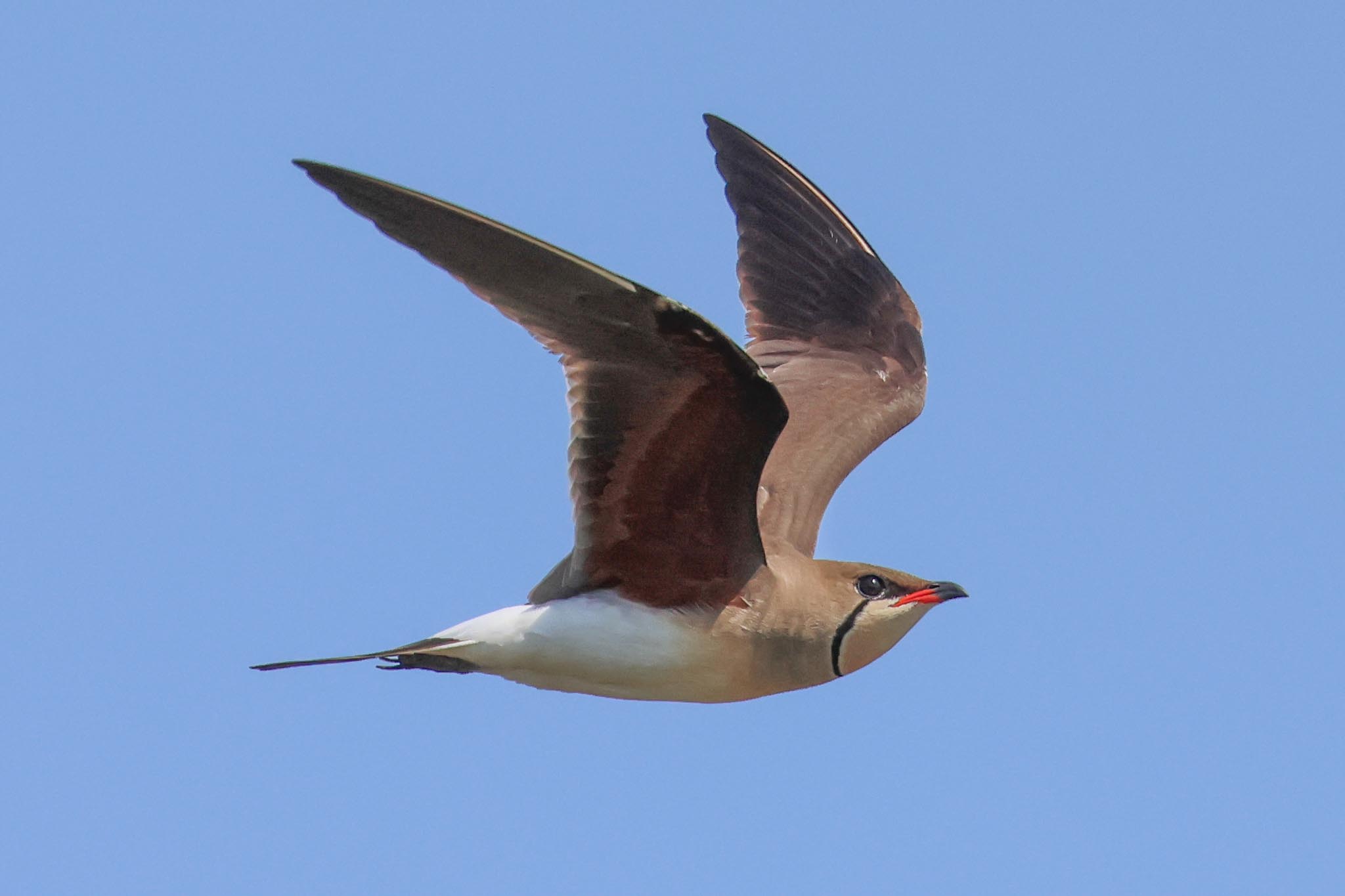
Continuing on, another pool in the flooded grassland further along held several Mute Swans, Garganey and Cormorants loafing on a grassy island, and two Greenshank in the water next to them, another addition to the wader list. It was getting hot now and we cut across the corner of the last of the saltpans to another bank where we found some shade under a tree.
A distant Raven circled up over the forest beyond and a Crested Lark called and dropped down onto the bank further up. A bus load of Romanian tourists drove up and two got out to swim in the rather dirty pond next to the tree – apparently the water is meant to have healing properties, even though it didn’t look very inviting to us. We didn’t have to wait long before our transport came out to meet us, a ‘Mad Max’ fusion, the front of a 4×4, welded to the back of a truck, with covered benches on the trailer. Whatever it looked like, it was very nice not to have to walk back in the heat of the morning.
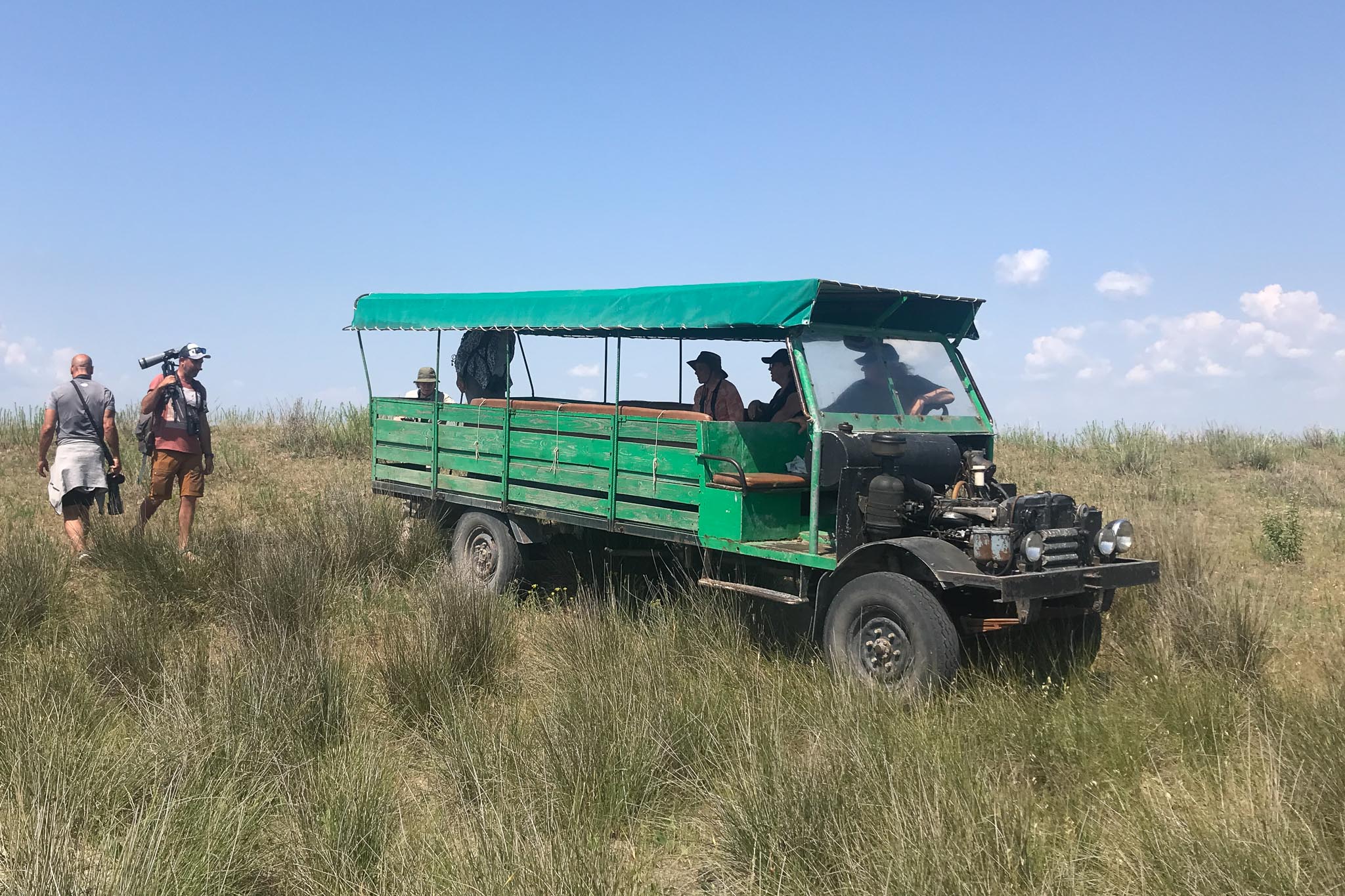
The ‘Mad Max’ bus took us back to the village of Letea, passing lots of Bee-eaters on the wires, and a fresh hole dug right by the track. Some of the group opted to walk through the village to the quay, and we were dropped off at the church, stopping to admire the traditional thatched houses. There were lots of Tree Sparrows in the gardens and we had a brief glimpse of a Barred Warbler, but it disappeared behind an abandoned house before everyone could see it and we couldn’t relocate it round the other side.
Further along, a pair of Wheatears were calling from the roof of another tumbledown house, a male Black Redstart flitted around the fences collecting food and a Black-veined White butterfly landed on a nearby tree.
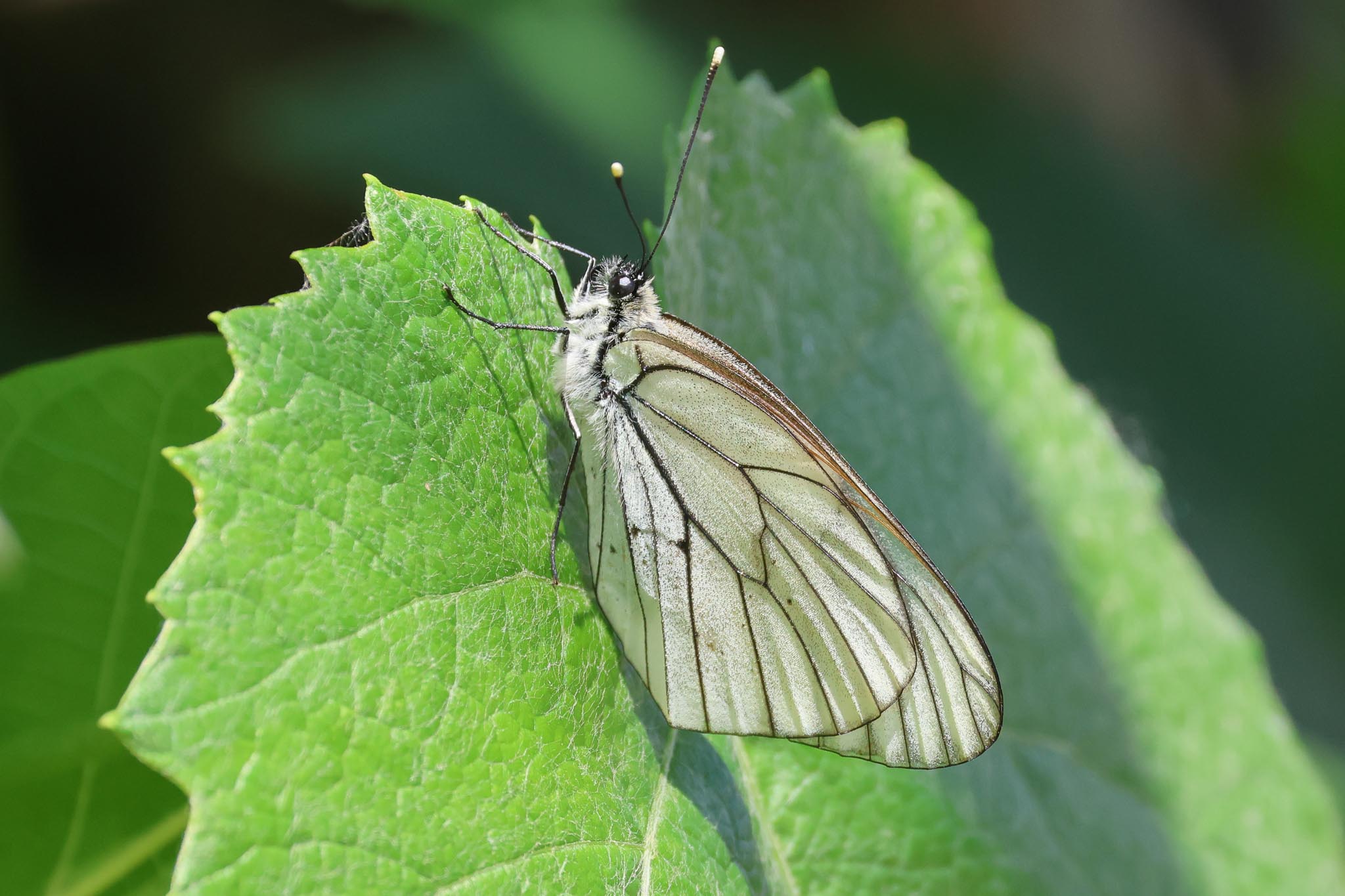
Turning down towards the quay, a succession of horses and carts loaded with Romanian tourists passed us, heading off to Letea forest. There were lots of boats tied up on the side of the channel here now and our boat was waiting for us. As we sat in the shade and supped our morning coffee, a Sedge Warbler was singing from the top of the reeds opposite, another new bird for the trip list.
As we made our way back down the channel along which we had come earlier, an endless succession of speedboats sped past, their wash crashing into the banks. Needless to say, there was no sign of the Golden Jackal now and almost no herons feeding by the side of the channel. A Golden Oriole flew in to a willow on one side and then out again as we approached and across the water in front of us. A pair of Hobbys were alarm calling from some bushes – we couldn’t see what was upsetting them, but we could see the nest they were presumably looking to use in one of the willows.
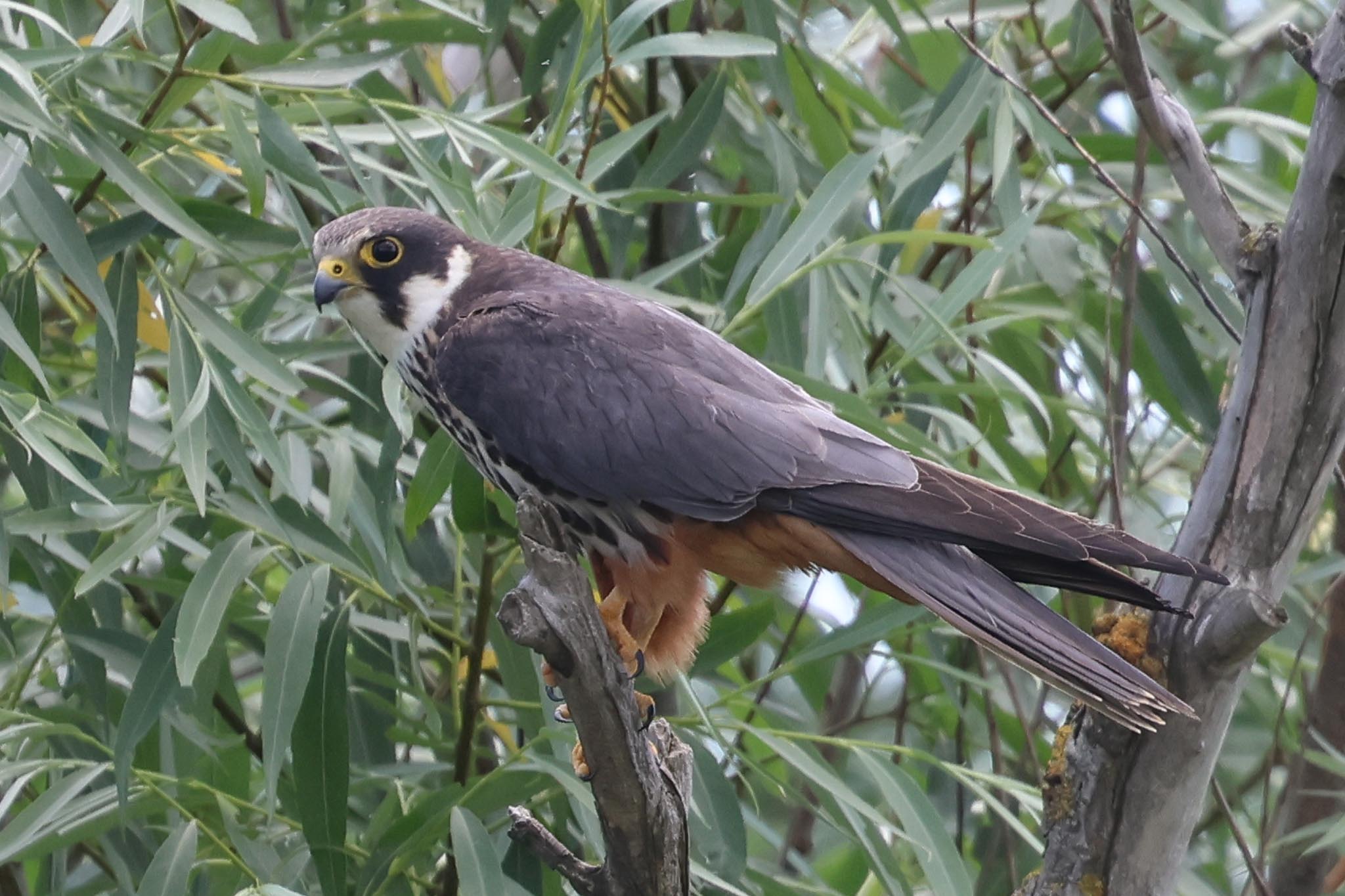
We took a small side channel, where a male Ferruginous Duck was on the water and swam off ahead of us, but further progress was blocked by floating reedbeds which had drifted across, so we turned back to the main channel. A Little Bittern flew across close in front of us, in view much longer so everyone could see it this time.
We got back to the floating hotel where we had left it, just in time for another sumptuous three-course lunch. Afterwards, we had a little time to relax as we were towed on along the old Danube Channel. There were lots of Caspian Gulls feeding along the edge of the reeds on the other side of the channel as we passed, and two more Pallas’s Gulls with them.
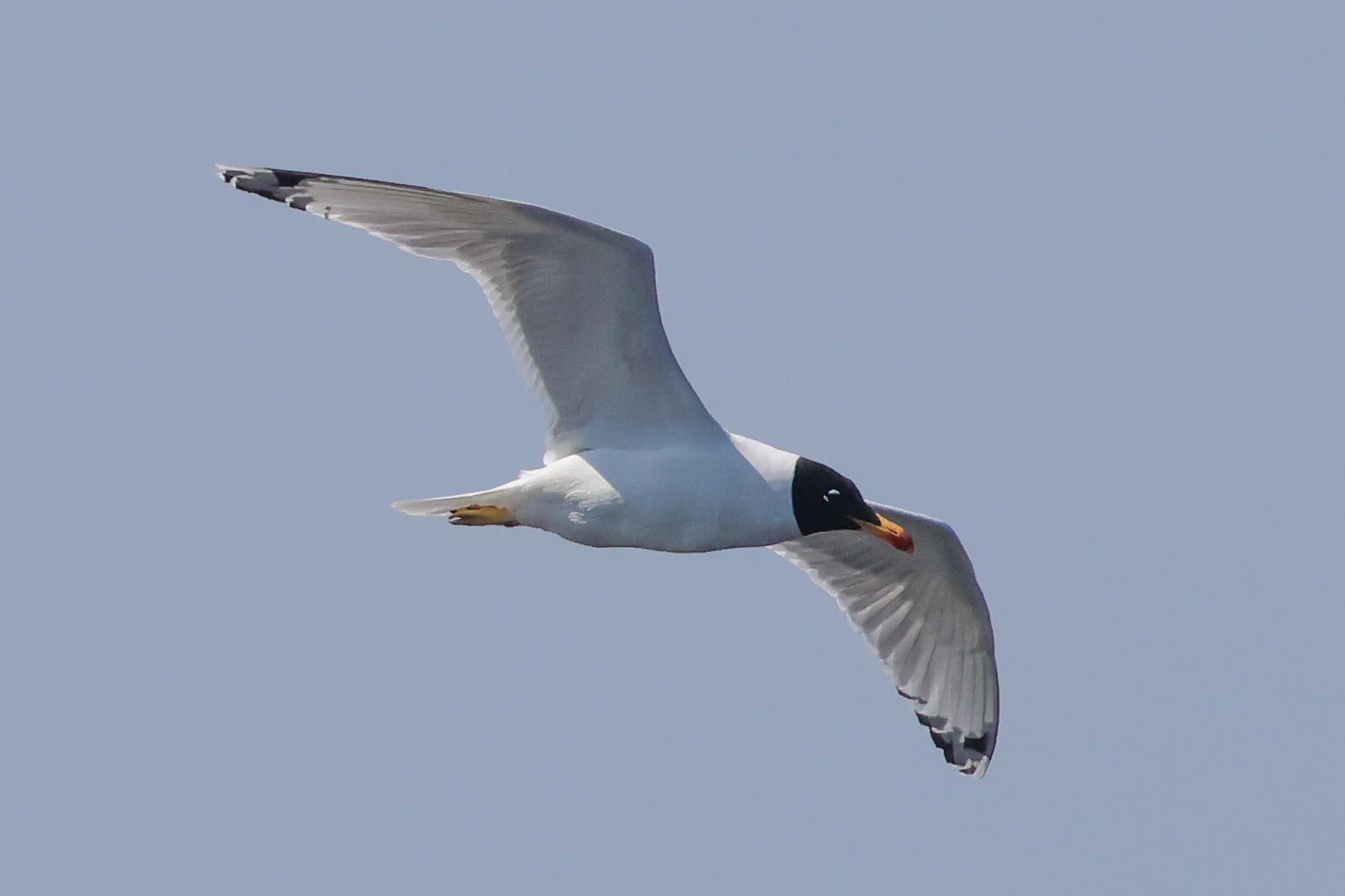
Then mid-afternoon, we transferred back over to the small boat again and turned off onto the smaller Bogdaproste channel. There were lots of Redstarts singing from the willows along the banks and a Roller perched on a branch above us as we passed. This channel was busy with tourist boats, so we turned off through the reeds into a small quiet pool. A pair of Red-necked Grebes were nest building in the water lilies and drifting in with the engine cut we had great close views of them now.
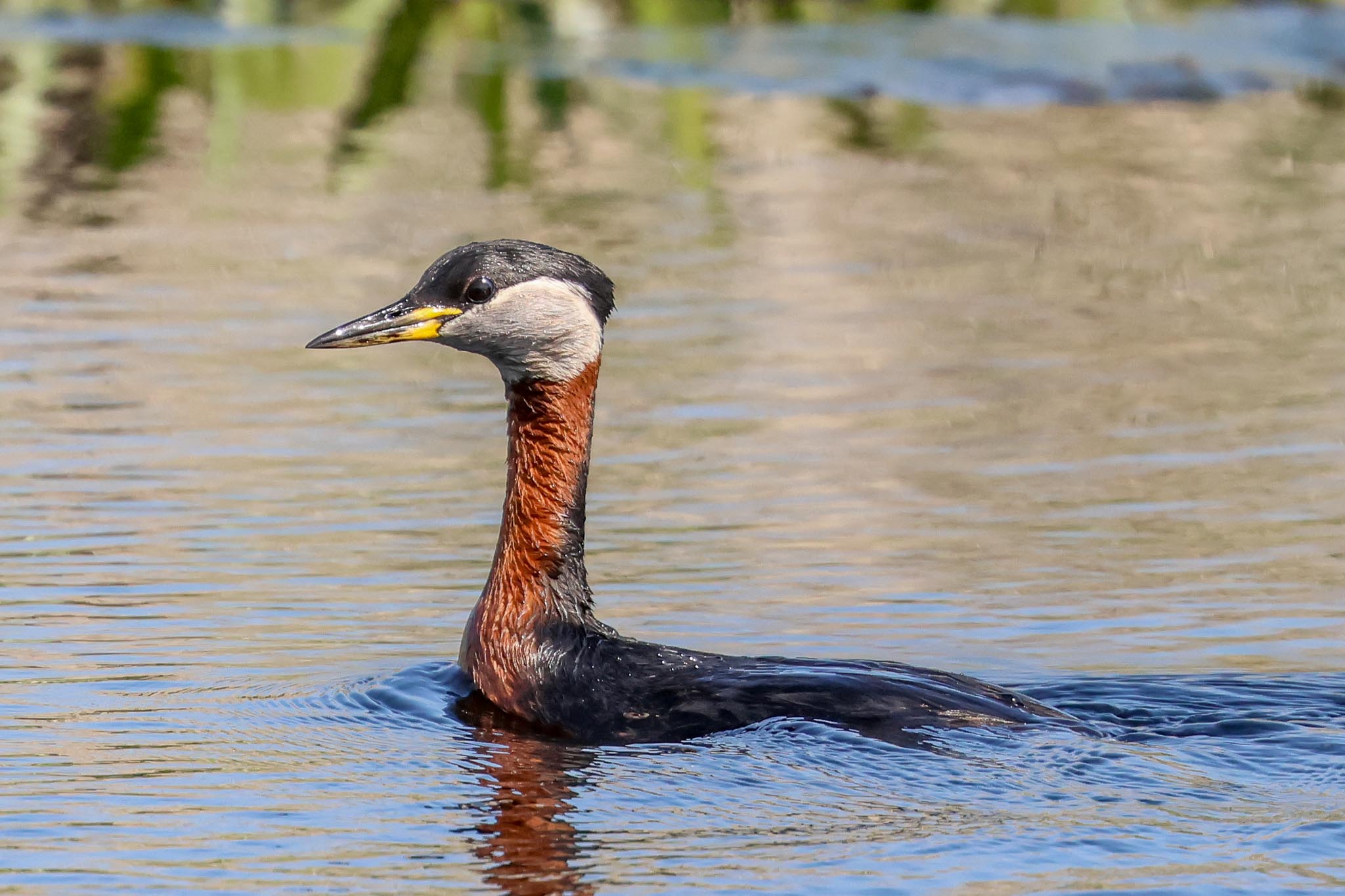
A Little Crake was calling from the reeds to one side, but despite stopping and scanning carefully, we couldn’t see it – they are always very elusive at this time of the year and the high water levels give them more places to hide and fewer places out in the open.
Back out onto the channel, we motored on to a succession of larger lakes. There were a couple of Dalmatian Pelicans and lots of Great Crested Grebes on the water on Lake Bogdaproste and a pair of Caspian Gulls on a log which allowed us to approach very close on the boat. Another Pallas’s Gull flew over the far end.
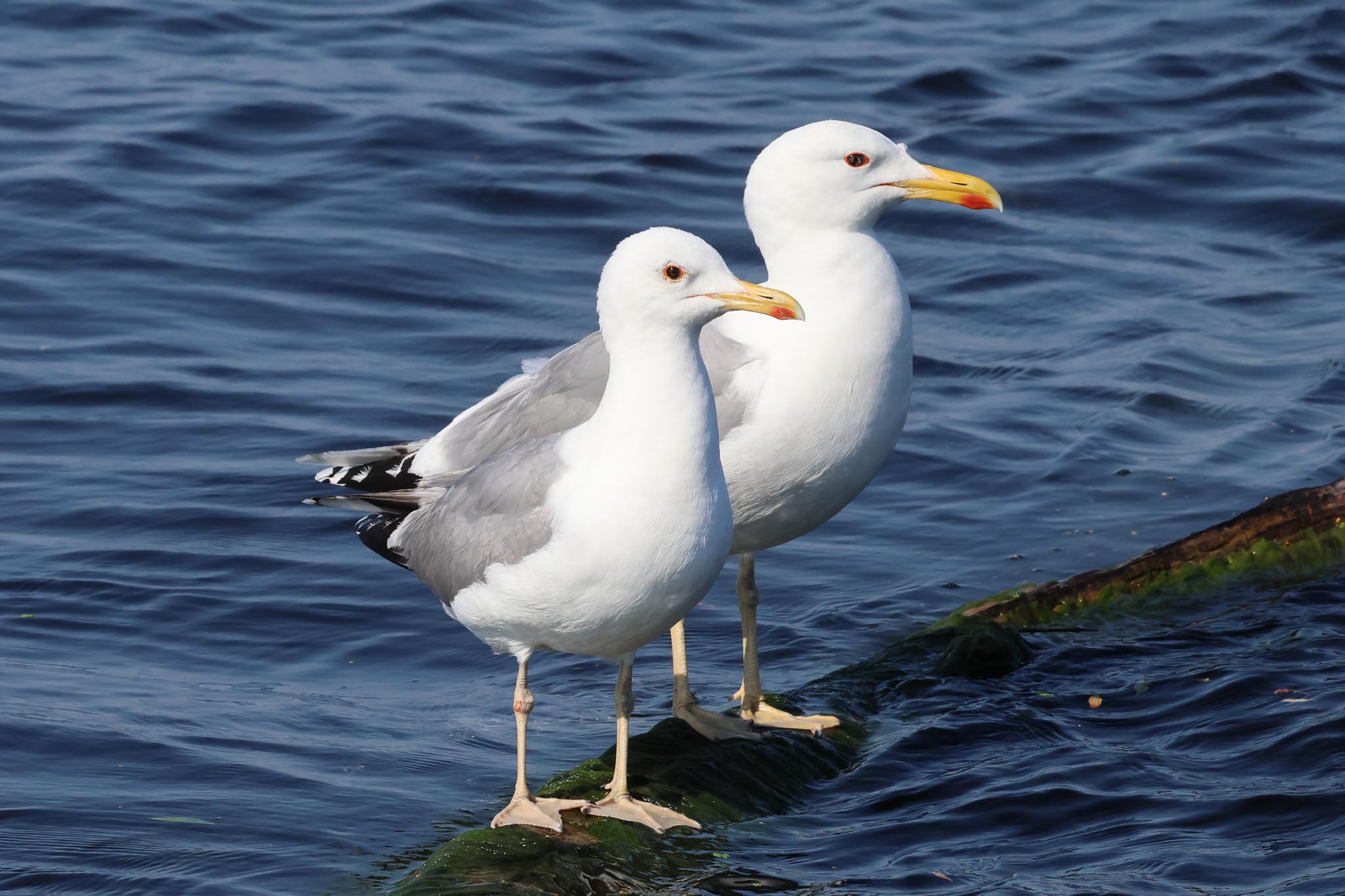
At Lake Trei Iezere, there was a large colony of Cormorants in the trees on one side, but not many Whiskered Terns this year on the floating vegetation at the far end. As we circled back round, a single Black Tern was dip feeding out in the middle. The next smaller lake was full of a great display of water lilies, and as we came out into a larger one beyond, we found a larger flock of feeding Black Terns and Florin picked up two White-winged Black Terns flying in to join them. Smart birds, and good for everyone to get a chance to catch up with them this time, but they moved quickly round behind us.
We had to go back round through Lake Trei Iezere, where the single Black Tern was still feeding, and now we found a White-tailed Eagle in the trees on the far side mobbed by Hooded Crows. It took off as we got closer towards it, and a Hobby joined in the mobbing as it flew away.
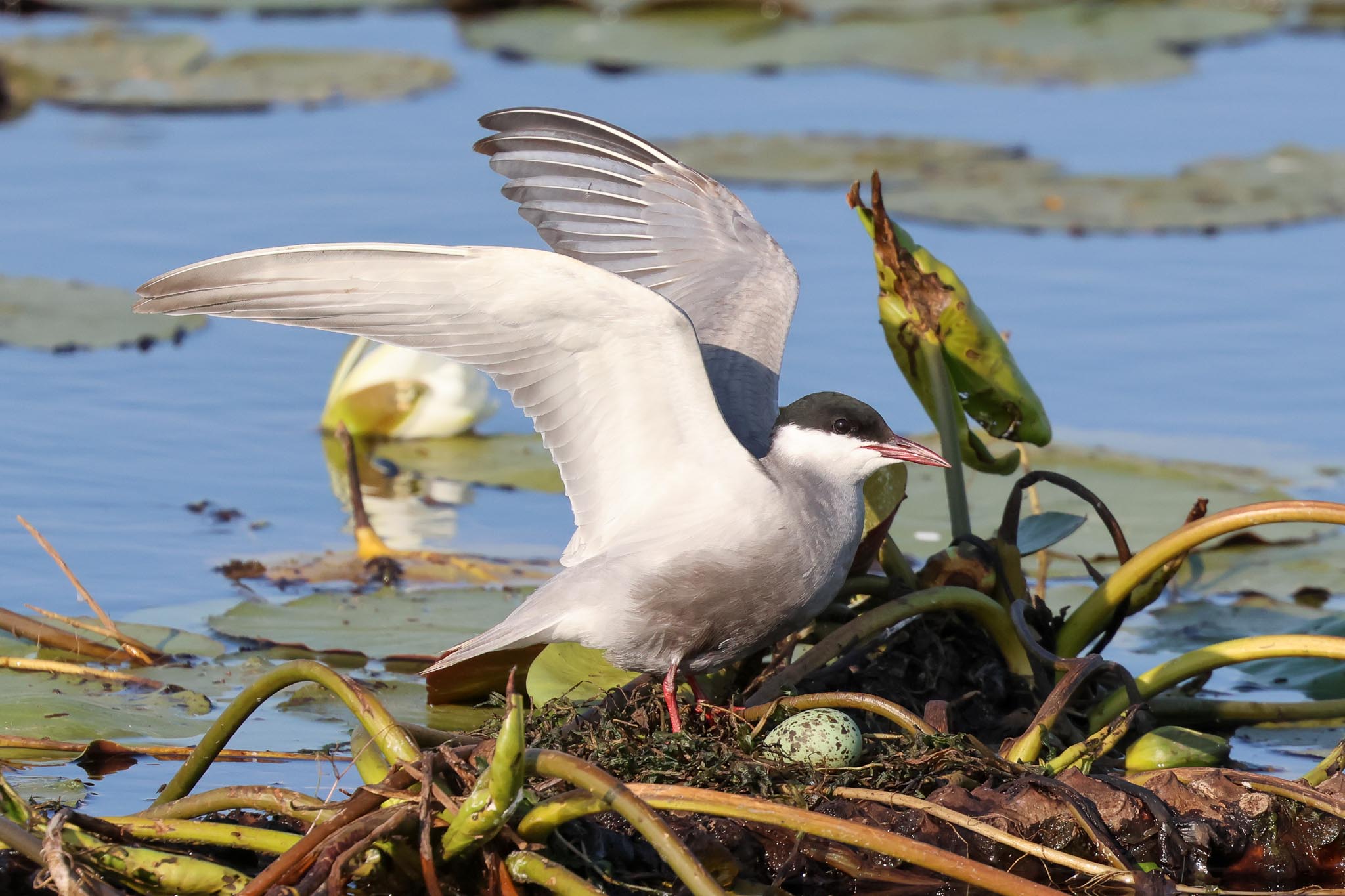
On deeper into the reeds and finally at the next lake we found a large colony of nesting Whiskered Terns with a few Black Terns in with them. A magical experience drifting in amongst them, with the terns flying all around the boat calling, several on nests with eggs already, others still gathering nest material or food for their mates.
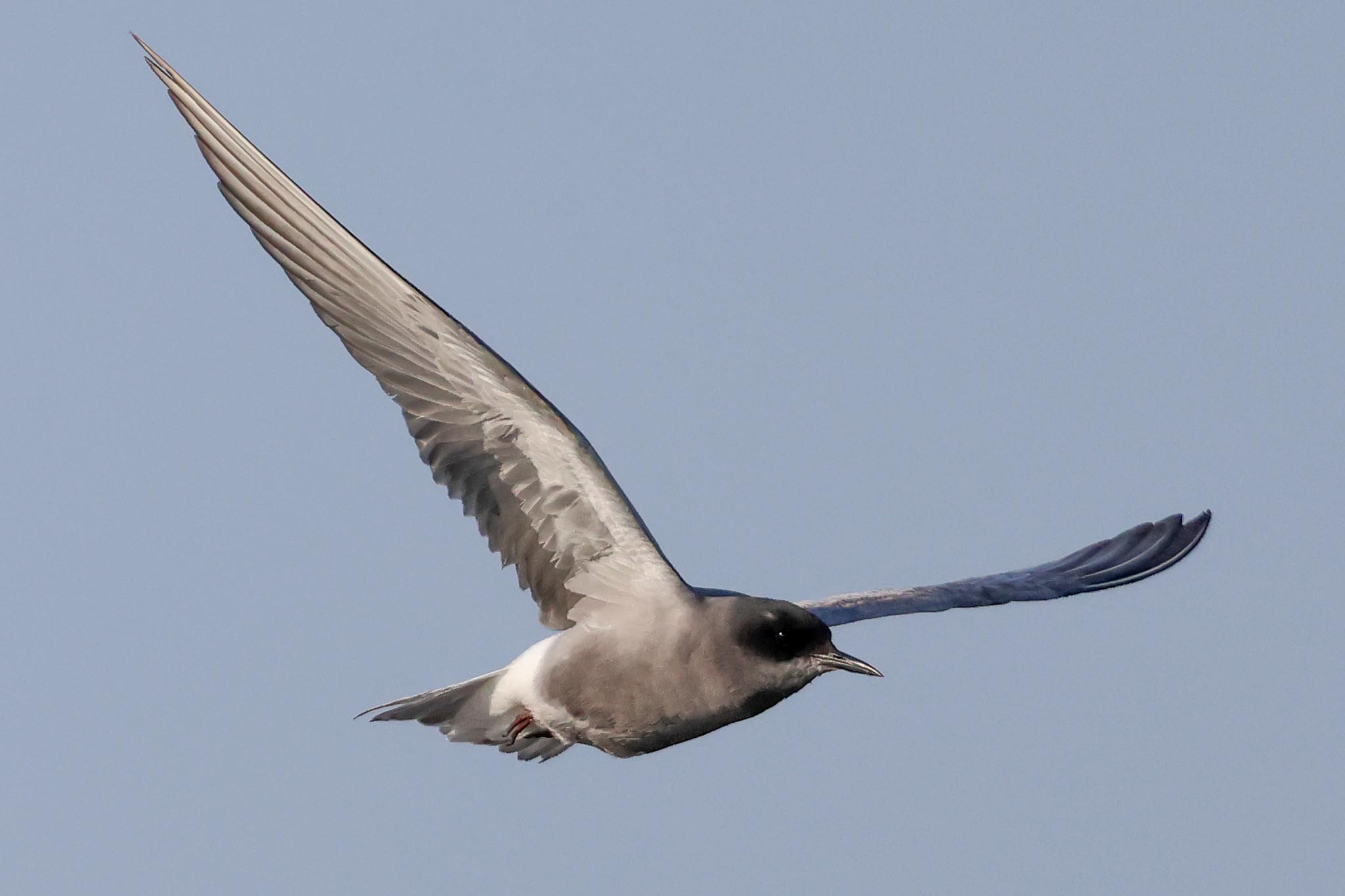
There were a few smart Black-necked Grebes on the water between the rafts of lilypads here too.
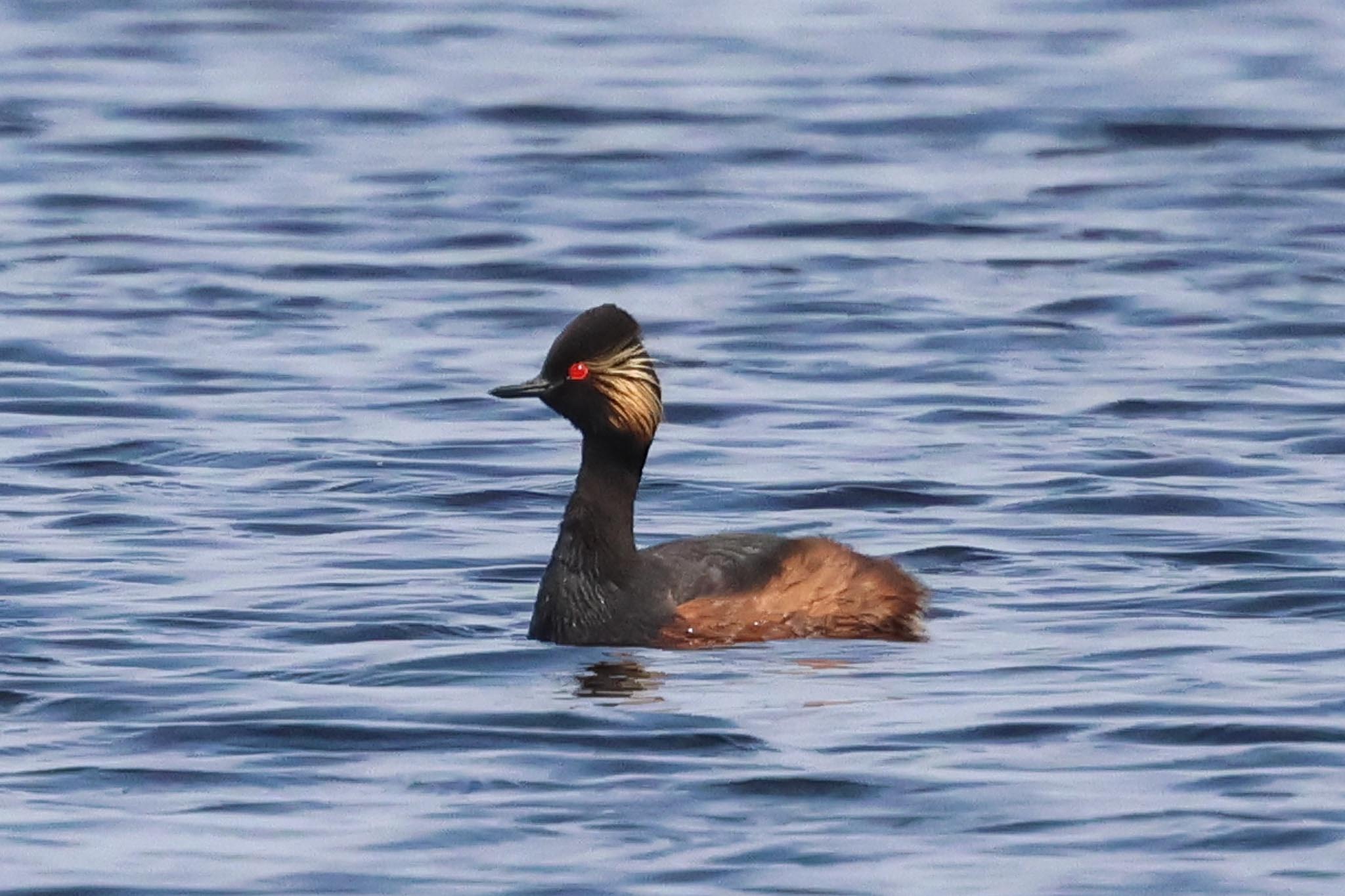
As we motored back to the floating hotel, another White-tailed Eagle flew past and a large flock of White Pelicans came over low, presumably heading back to roost. The hotel was moored in another amazing location, and we had a little time before dinner to enjoy the fabulous view out in the middle of nowhere, watching the last of the tourist boats heading back up the channel before the last of civilisation disappeared and we could sit back and just enjoy the sounds of nature all around.
A small group of White Pelicans was perched on a tangle of logs with a single Dalmatian Pelican, a selection of terns flew up and down the channel beside us, Whiskered, Black and Common Terns, flocks of assorted herons and ibises flew past, three male Cuckoos were calling in the willows beside boat and a Bittern was booming from the reeds the other side again. Everyone agreed, the best overnight spot yet, they just keep getting better! And then another delicious dinner was served in the dining room – Russian salad, the local dish tochitura and crème caramel for pudding – while we watched the setting sun. Heaven!
Saturday 3rd June
It had clouded over by morning, and there were moody skies to west. It looked to be raining in the distance but was still sunny over the reeds behind us. We awoke to a cacophony of frogs, the Bittern still booming, Savi’s Warbler reeling again, and a Great Reed Warbler croaking from the reeds. A Garden Warbler sang briefly from the willows beside us.
There were still lots of birds to see here, just from the deck of the hotel. As well as everything we had enjoyed last night, a family of Greylag Geese were feeding in the edge of the reeds, the birds here are of the eastern race rubirostris, and we got them in the scope so we could see their pink bills. A White-tailed Eagle flew past, closely pursued by a male Marsh Harrier and a Hooded Crow, and a second White-tailed Eagle landed on the tangle of logs in the river nearby, where the pelicans had been last night. We got it in the scope, great views, we could see its enormous talons, but we got a bit too distracted, and turned to see that breakfast was already on the table.
After breakfast, we set out on the small boat again. The eagle had remained perched on the log all that time, so we motored up for a closer look before it took off, then we turned around and headed off the other way along the channel. Loads of Squacco Herons were lining the channel now like fishermen on their pegs and squadrons of Glossy Ibis flying overhead, heading out for the day to feed. We stopped to look at a small pool on a bend in the channel, where two Red-necked Grebes were asleep but woke up briefly as we pulled up, and a pair of Great Crested Grebes were on their nest in lilypads, with a well-grown still stripy juvenile on the water nearby.
As we continued on, a Grey-headed Woodpecker flew across in front of us but disappeared into the willows. We picked up an Otter in the water some way ahead of us, but it dived almost immediately and didn’t resurface in view. We drifted up with the engine idling, but there was no further sign. A little further on, we could hear a Little Bittern barking in the reeds, so we stopped to see if we could find it. A Great Bittern started booming nearby too, but both were well hidden deep in the reeds and remained stubbornly out of view. As we set off again, a Caspian Tern flew in high but continued straight over the channel and disappeared off over the trees the other side.
We sailed into another small lake and drifted up to the lilypads where another Whiskered Tern colony was in full swing. Great to just sit for a few minutes and watch all the activity again. A Hooded Crow kept trying to come in, and kept getting chased off by a cloud of terns, presumably looking to steal their eggs – it seemed a hard way to make a living. A couple of Black-necked Grebes were on the water here too, but were typically more nervous and swam off well ahead of us, diving and resurfacing beyond the lilypads.
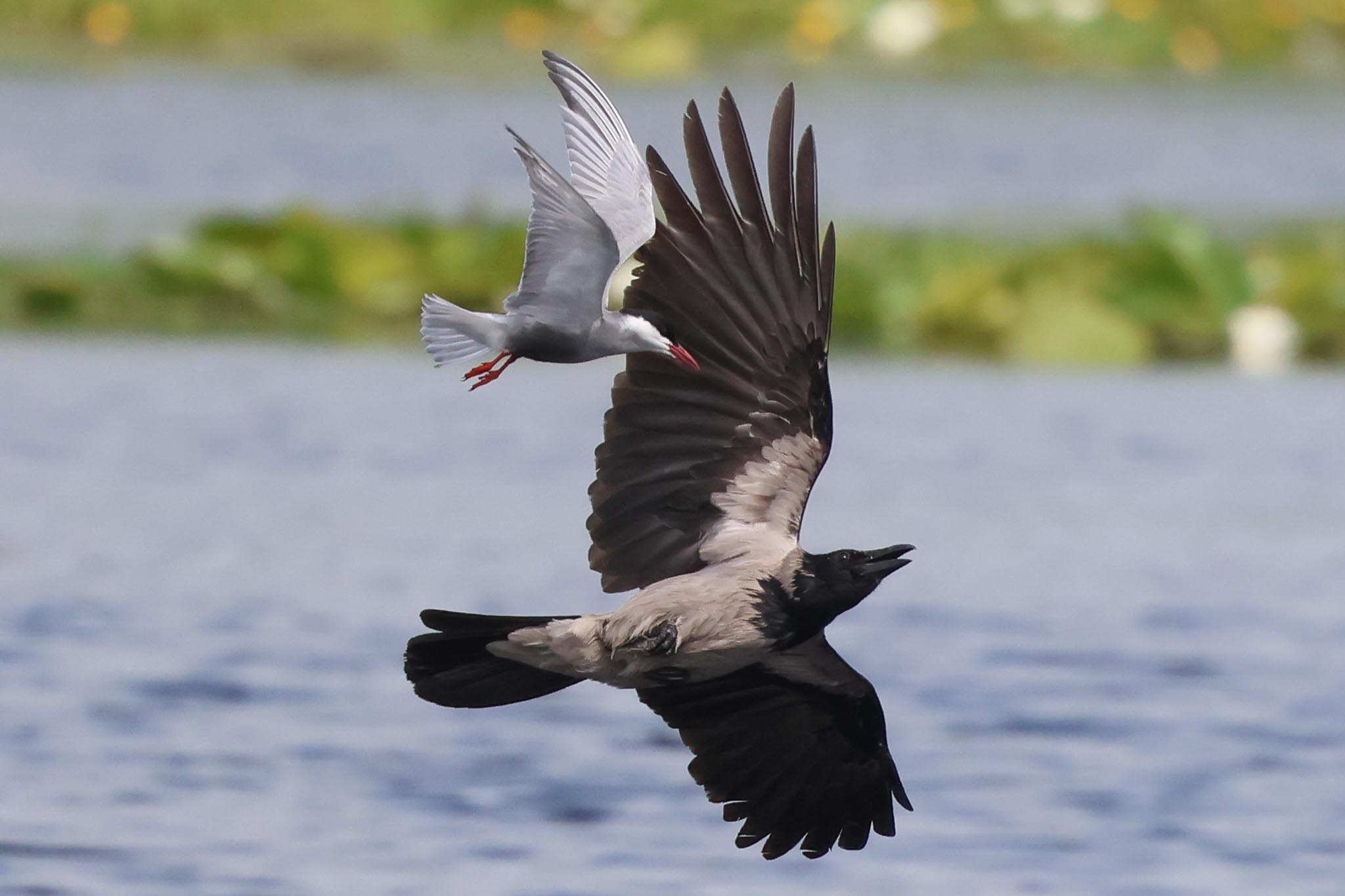
Out onto the channel beyond, which was lined by willows, and we flushed a succession of Night Herons ahead of us out of the trees, but not one would stay for a photo. A Pygmy Cormorant resting on a snag in mid channel was more accommodating and for once let us get quite close this time before it eventually flew off. At the far end of the channel, we found a tree down across the water. The captain managed to get us through, but then decided to try to clear it. Another smaller boat laden with tourists stopped to help and tied on our tow rope. The first time we snapped off a large section which we dragged out and released in the middle of the nearby fast flowing channel, then back again and after several attempts we eventually managed to manoeuvre the main trunk out of the way too.
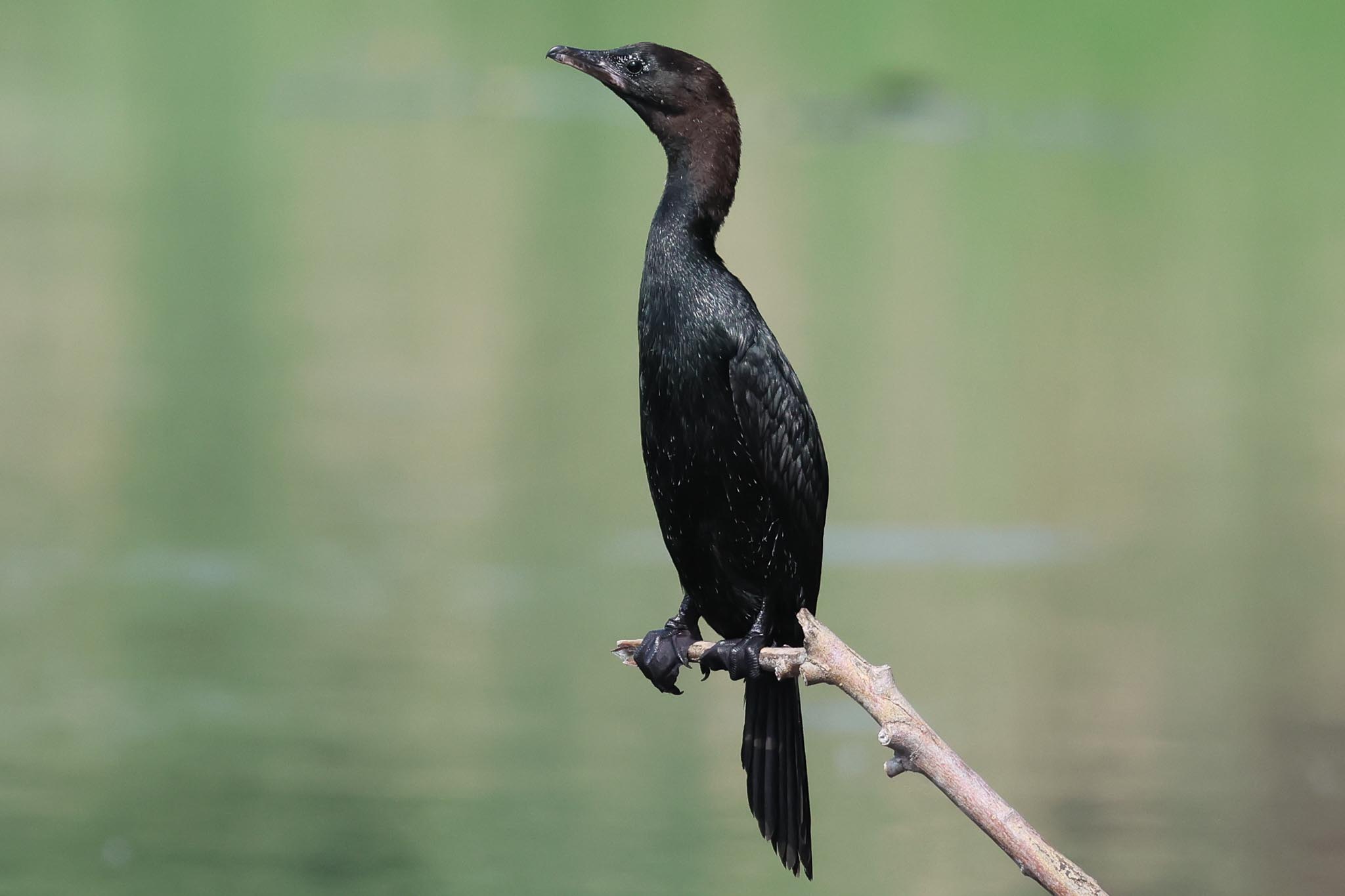
We had all worked up a thirst sitting and watching all the hard work, so when we got out onto the bigger channel the other side, it was time for coffee! Another Grey-headed Woodpecker flew across as we motored on and sipped our coffee and the first Kingfisher we had seen for a couple of days was perched on a branch by the bank as we passed close by.
As we turned the corner, we found ourselves back on the edge of a more open agricultural area now, with fields over the bank on our right. We passed some large crumbling soviet era farm buildings and a Cuckoo flew ahead of us and landed on a small bare bush on the bank, the first which had actually perched in camera range!
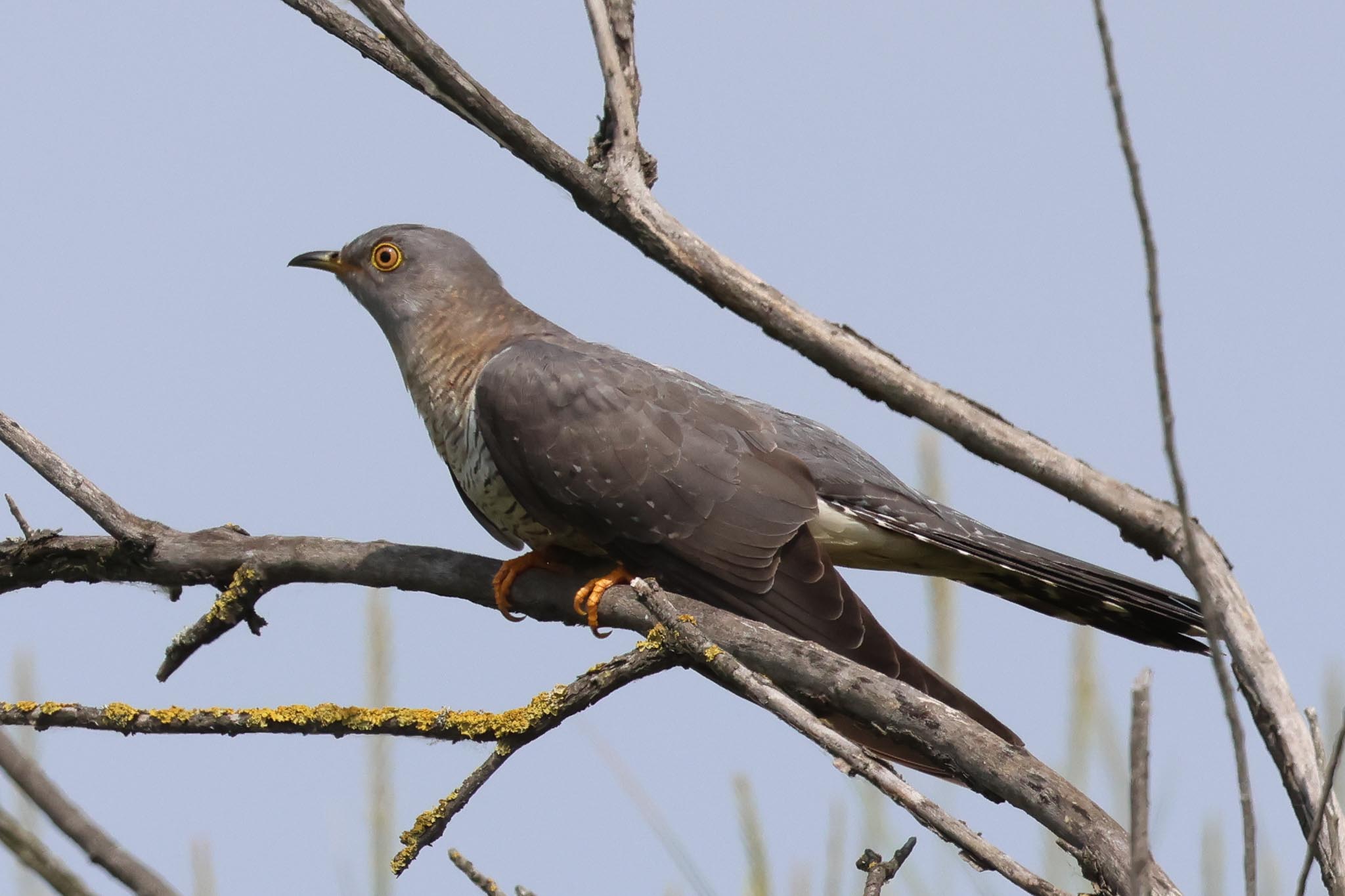
A little further on, Florin suddenly signalled the captain to stop the boat. He had heard Rose-coloured Starlings calling on the bank, so we backed up and found them feeding in a mulberry bush on the ripe fruit. We could only see four or so and they were mainly in the back of the bush, so we decided to land on the bank a bit further up and walk back to see if we could get them in the scope. By the time we had landed, there was no sign of them, but thankfully after just a couple of minutes they flew back in from over the channel.
There were at least twenty of them and they swept past us and in to a second bush further back. Here we went round the mulberry bush (!) and got them in the scope, but after just a few seconds they took off again. This time they flew straight towards us and landed back in the first mulberry right above our heads. We had some great, if brief views before they moved to the back of the bush and then flew away again, back over the channel. Rose-coloured Starlings are birds of the steppes of Central Asia but in some years they irrupt westwards, sometimes in huge numbers and many can breed in Romania. An irruption is currently underway, but as they are not breeding yet they can be very hard to find – we had been lucky.
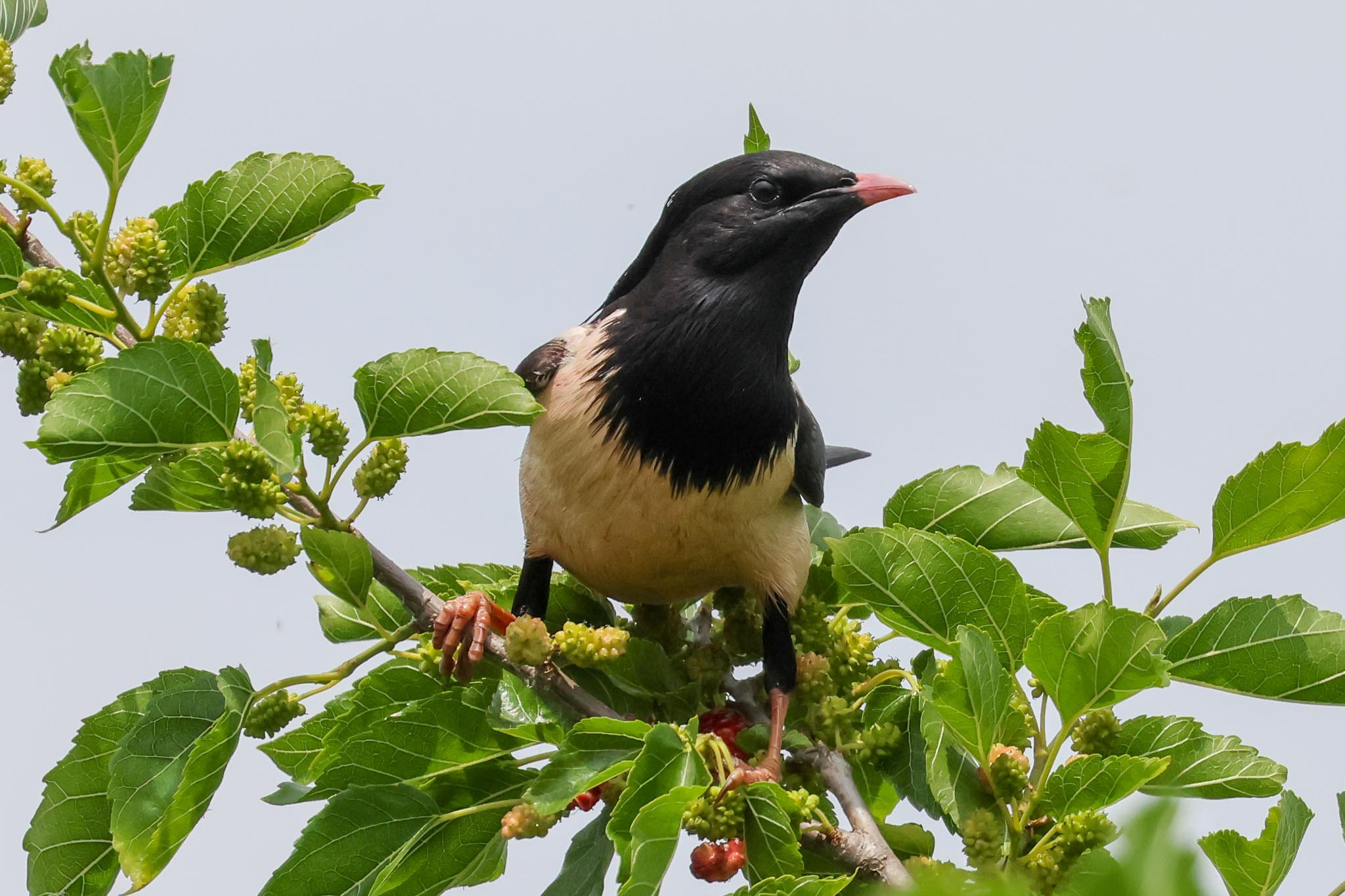
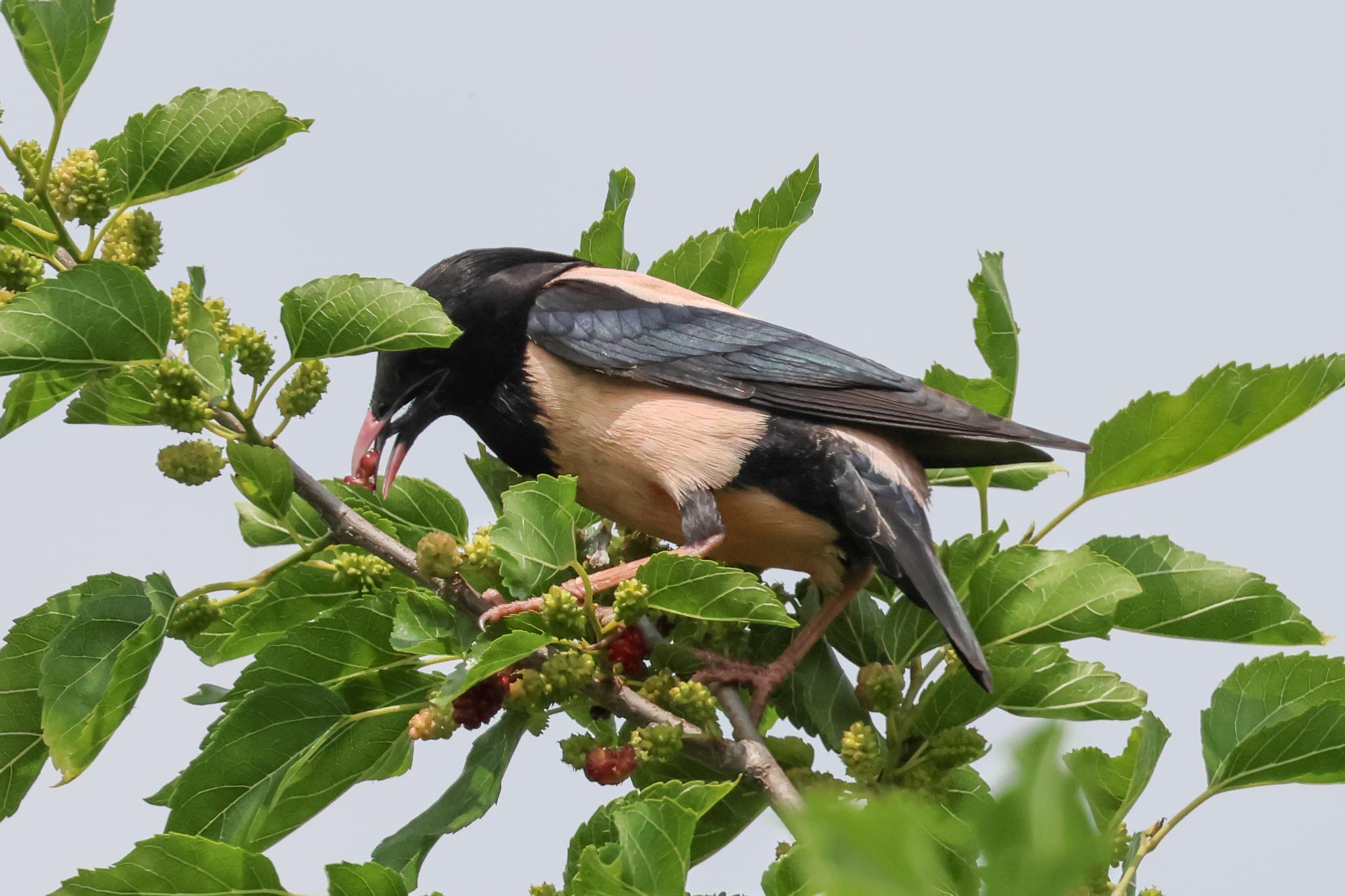
A Hoopoe flew past as we walked back to the boat, and as we sailed on along the channel, a Freyer’s Purple Emperor butterfly flew across and in to one of the willows on the bank, followed by a male Golden Oriole which also disappeared into the trees, where we could hear it cat-calling. A female Red-footed Falcon was hovering over the fields beyond with a Kestrel and three more Red-footed Falcons flew over high above us calling.
We hadn’t seen many Little Bitterns over the last couple of days, but now two males flew across the channel in quick succession. It didn’t look like a particularly good area for them, the channel wide and lined with bushes, and unfortunately both flew straight over the bank and dropped down towards the agricultural area the other side. We still hadn’t managed to find one perched in the open. A Lesser Spotted Eagle drifted high overhead. We stopped to admire several European Pond Terrapins on the logs snagged around a willow which was growing in the side of the channel.
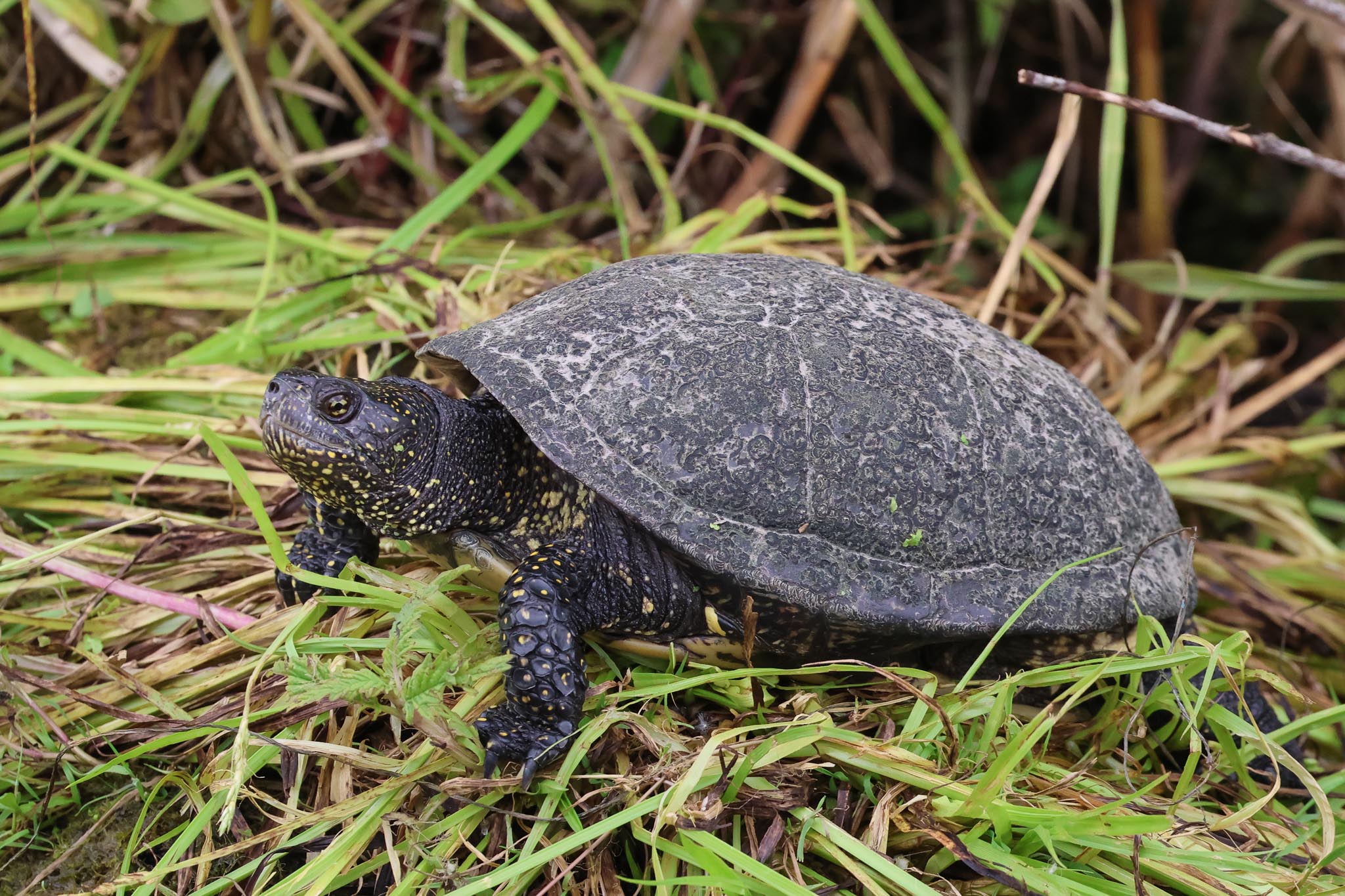
Some darker clouds drifted over and it started to spit with rain now, but thankfully it never really got going and quickly passed over us. We stopped to scan some flooded fields, which were full of Black-headed Gulls, egrets, Glossy Ibis and Lapwings and we found two Oystercatchers, a new one for the trip list, and a single Black-tailed Godwit with them. A little further up, we found a single Green Sandpiper too.
We were on our way back to meet the floating hotel now, so we cut down through a series of channels where lots of burnt willows lined the banks and we could hear several Redstarts singing from the trees. A Muskrat appeared briefly in the water ahead of us but dived and did not resurface in view. The floating hotel was waiting for us on one of the wider channels, just in time for lunch. The tug boat attached itself to the front of the floating hotel and we were towed along – we ate with the views across the reedbeds of the Delta passing by in the windows all around us.
Our last lunch on board the floating hotel, another wonderful soup with meatballs, with a dish of cooked vegetables and followed by another delicious cake. We had been lucky this morning, that it had stayed largely dry, as it started to rain more heavily now. There were lots of White-tailed Eagles here – several times, lunch was briefly interrupted to admire one perched on the top of a tree by the channel or a nest nearby. After lunch, the rain had stopped and we retired to the top deck where we were almost eye level with the eagles. We lost count of how many we saw in the end.
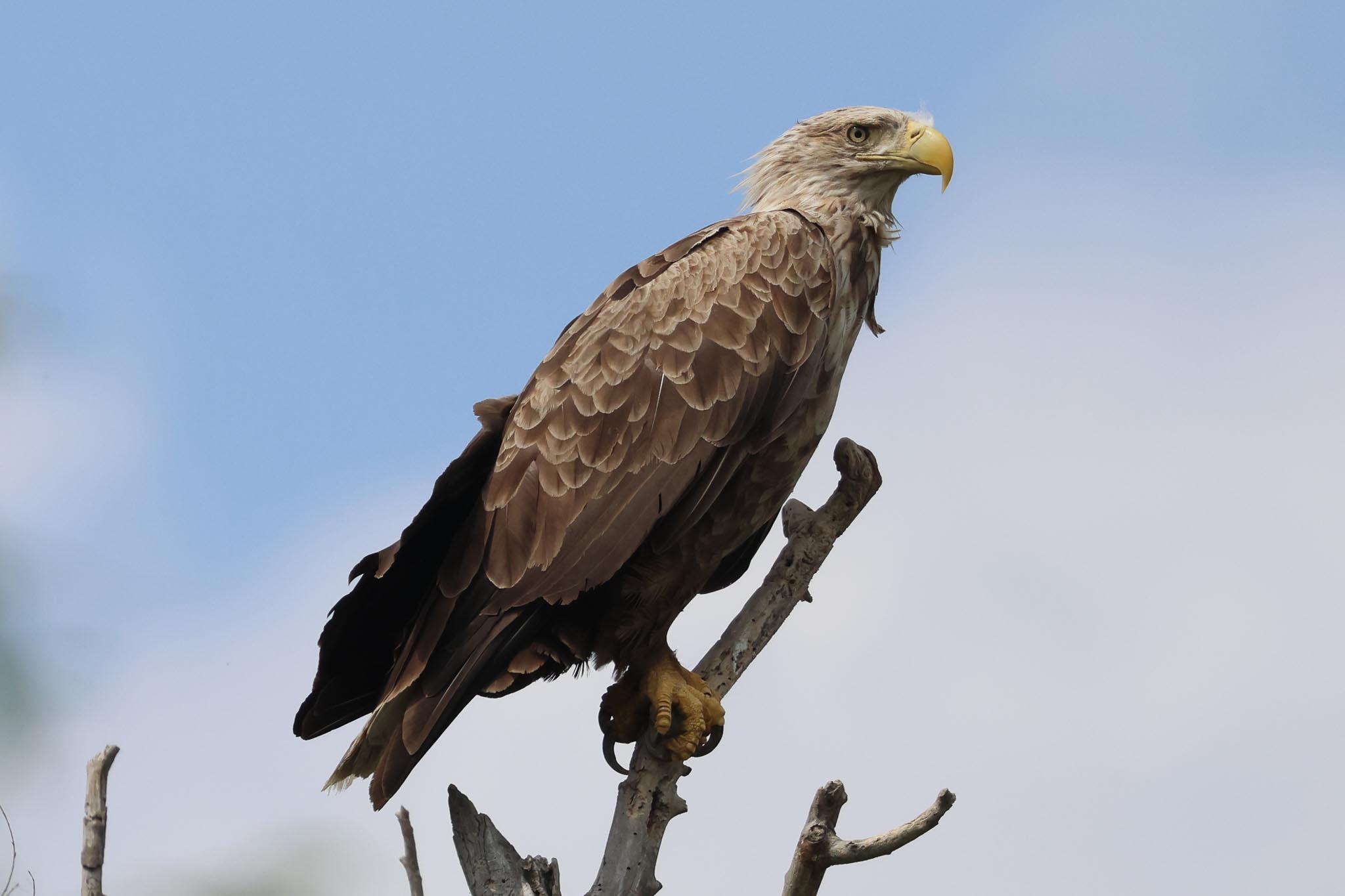
Back into the more area of the western part of the Delta, we started to hear several Thrush Nightingales and Icterine Warblers singing from the trees again, although it was a bit breezy and middle of the afternoon now, so there was not as much activity as when we came out this way on our first morning in the Delta. When the sun came out for a while, we picked up a few Freyer’s Purple Emperor butterflies fluttering around the white willows lining the banks. There were lots of Kingfishers along the banks again too.
It was very relaxing to sit on the top deck and watch the world go by. Eventually, the tug boat swapped from pulling the floating hotel to pushing it as we approached the main Sulina channel and we got back to Tulcea in time for our last dinner on board, with a delicious cake brought out by the cook to finish accompanied with a glass of local prosecco.
Sunday 4th June
After breakfast this morning, we said our thanks and goodbyes to the staff on the floating hotel and the boatmen who had all looked after us so well. Our bags would be transferred to the hotel where we would be staying for the next few nights, so we took just what we needed for the day and boarded the minibus which Florin had brought down to the quayside. We set off out of Tulcea and into the countryside.
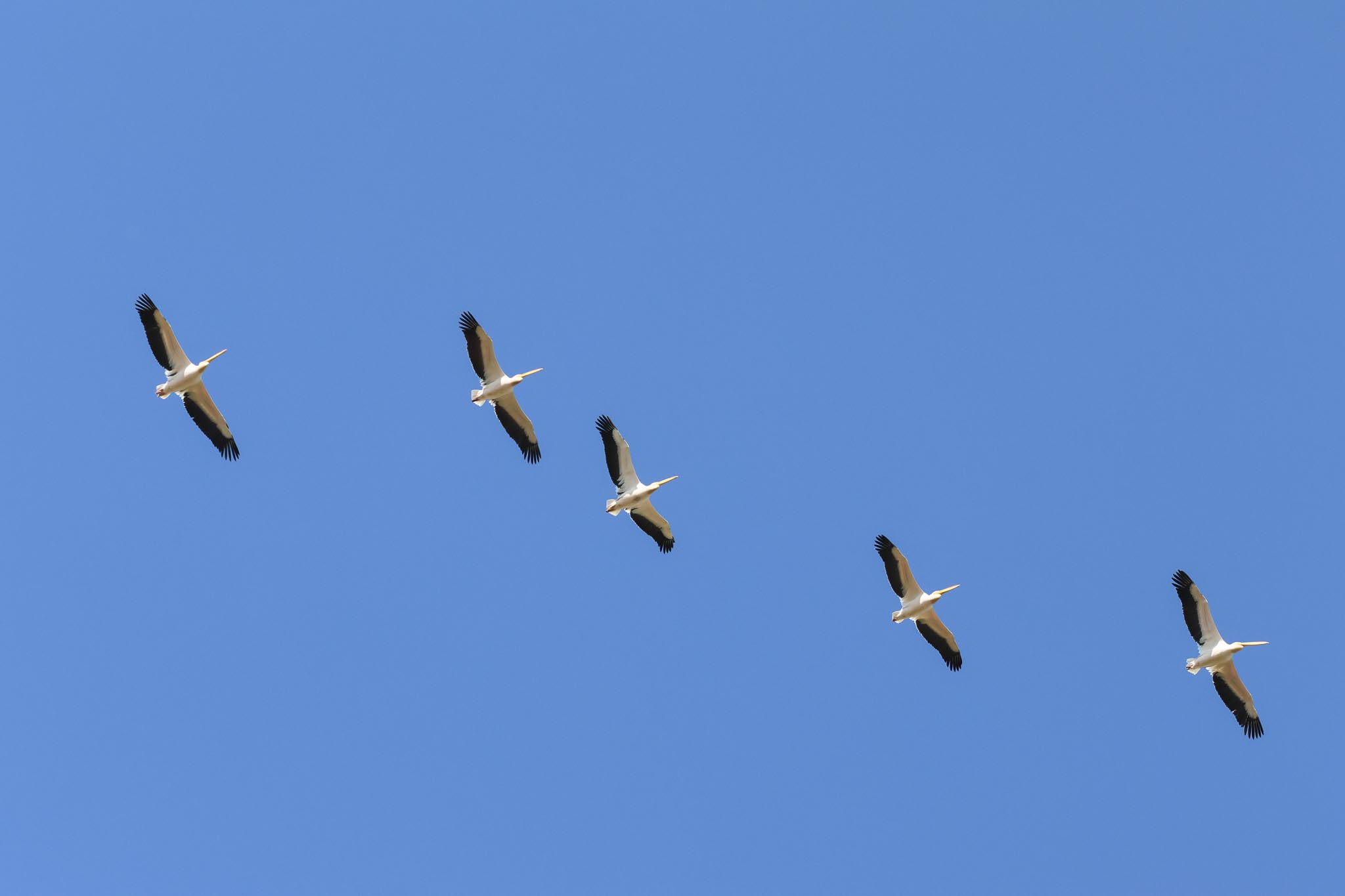
Our first destination for the morning was the hillside at Denis Tepe and along the access track, a Lesser Grey Shrike flew across in front and landed briefly on the bushes nearby before flying up onto some nearby wires. We stopped and got out and realised there were two or three Lesser Grey Shrikes here, one perching obligingly on a nearby pylon where we could get it in the scope. There were Spanish Sparrows chirruping in the trees above our heads and we watched several going in and out of their nests. It was rather windy today, but some birds were enjoying the conditions – two Long-legged Buzzards drifted over and a small squadron of White Pelicans soared above us.
Continuing on and out into the open, we stopped at the bottom of the hillside. Lots of Isabelline Wheatears were out in the grass and further along the track, families with fledged young, and we picked up a Northern Wheatear right at the top of the ridge. A Crested Lark kept returning to sing from a small mound in front of us, where we got an excellent look at it in the scope, a Short-toed Lark which was singing high above us eventually landed on the track and there were one or two Skylarks here too. A Tawny Pipit was lurking in the longer grass on the low bank beside the track but then flew out and landed on a rock in the open where we had a much better view.
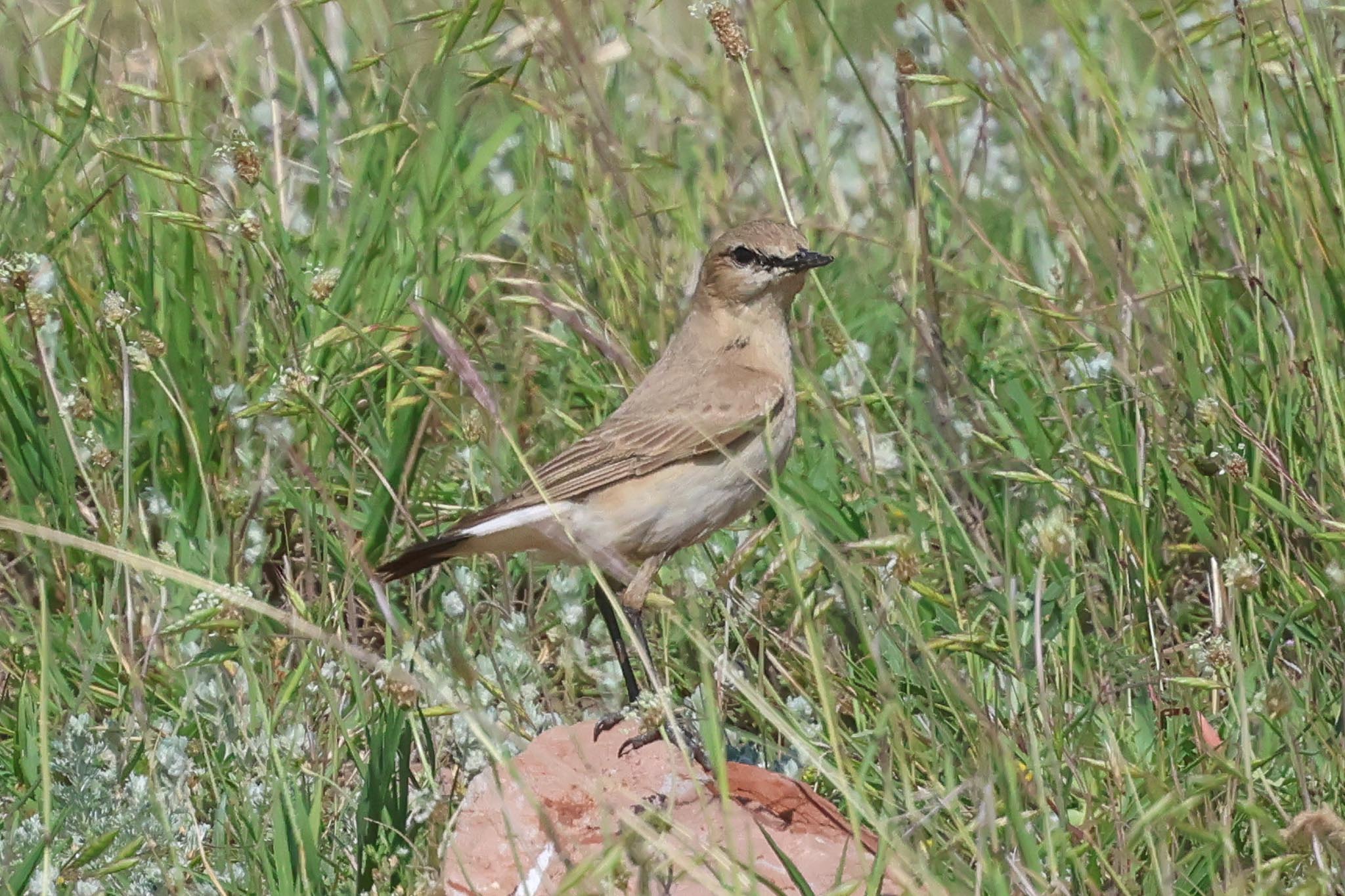
Another Long-legged Buzzard drifted overhead, mobbed by a Kestrel, and a Red-footed Falcon flew over. Several Bee-eaters swooped around the hillside and a Hoopoe flew across with food in its bill, presumably with hungry young to feed the other side. There were a few butterflies here despite the wind, our first Cardinal and a couple of Eastern Bath White. A Suslik, or European Ground Squirrel, stood up in the grass briefly.
It was amazing how much we could see here without venturing more than a few metres from the minibus, but eventually we had to tear ourselves away, and we drove on to Babadag Forest. We managed to park (a Romanian had helpfully parked their car right in the entrance to the parking area) and took a small path up the hill through the trees. There were lots of flowers, including several orchids, particularly Pyramidal Orchids in full bloom now, and Florin stopped to point out some of the flora typical of the Pontic-Caspian steppe. There were lots of butterflies, including more Cardinals, Niobe and Glanville Fritillaries, various moths flew up from our feet and lizards scuttled off through the grass, including European Green Lizard and Balkan Wall Lizard.
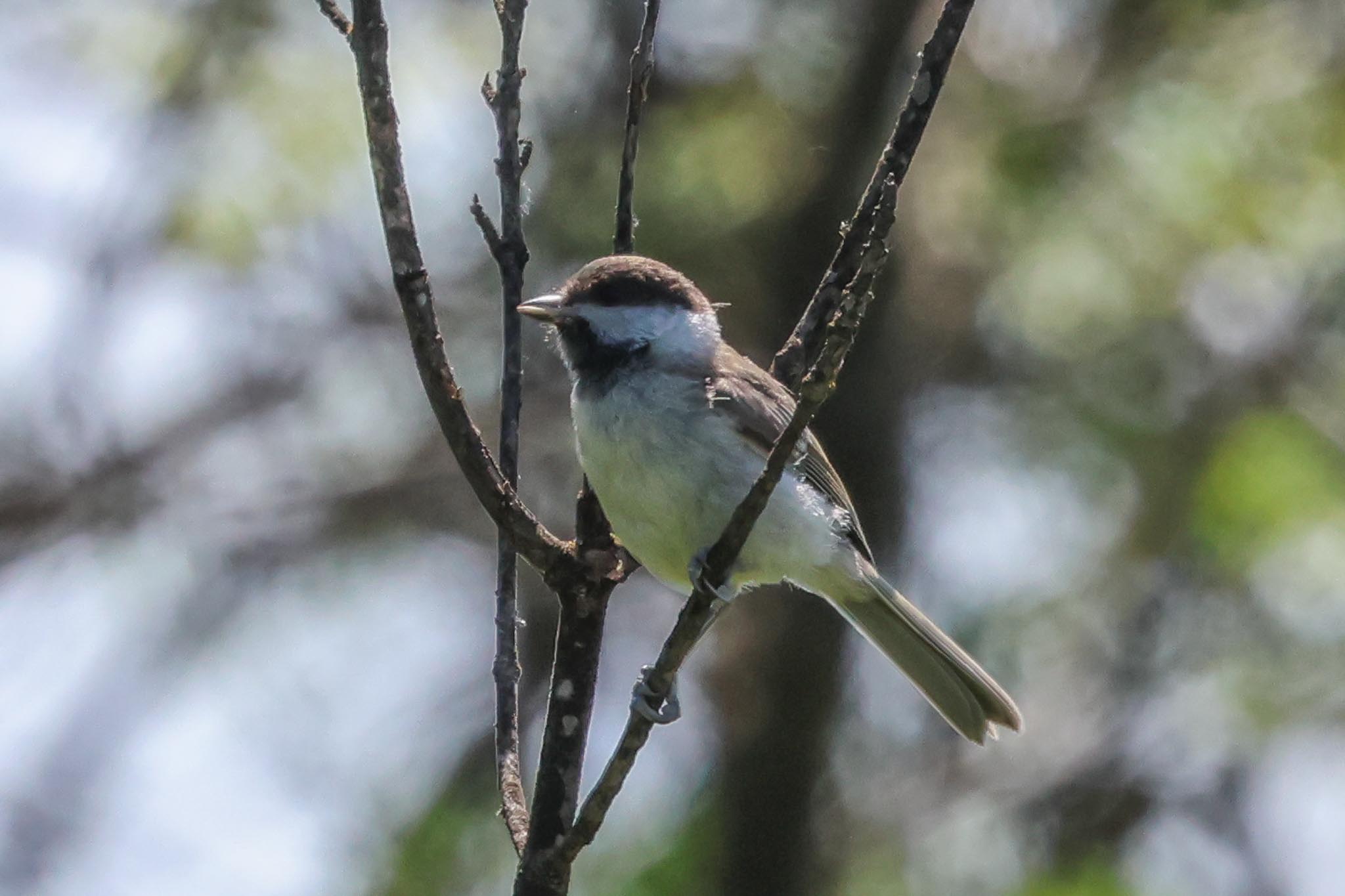
We could hear Ortolan Buntings singing in the trees as we walked up but couldn’t see them at first and they went quiet before we got to them. Then we heard a Sombre Tit calling and helpfully it flew in and landed in the trees next to us, giving us some very nice views of this often very elusive species. A little further on, we heard another Ortolan singing and following the sound this time we managed to track it down in the higher branches of an oak.
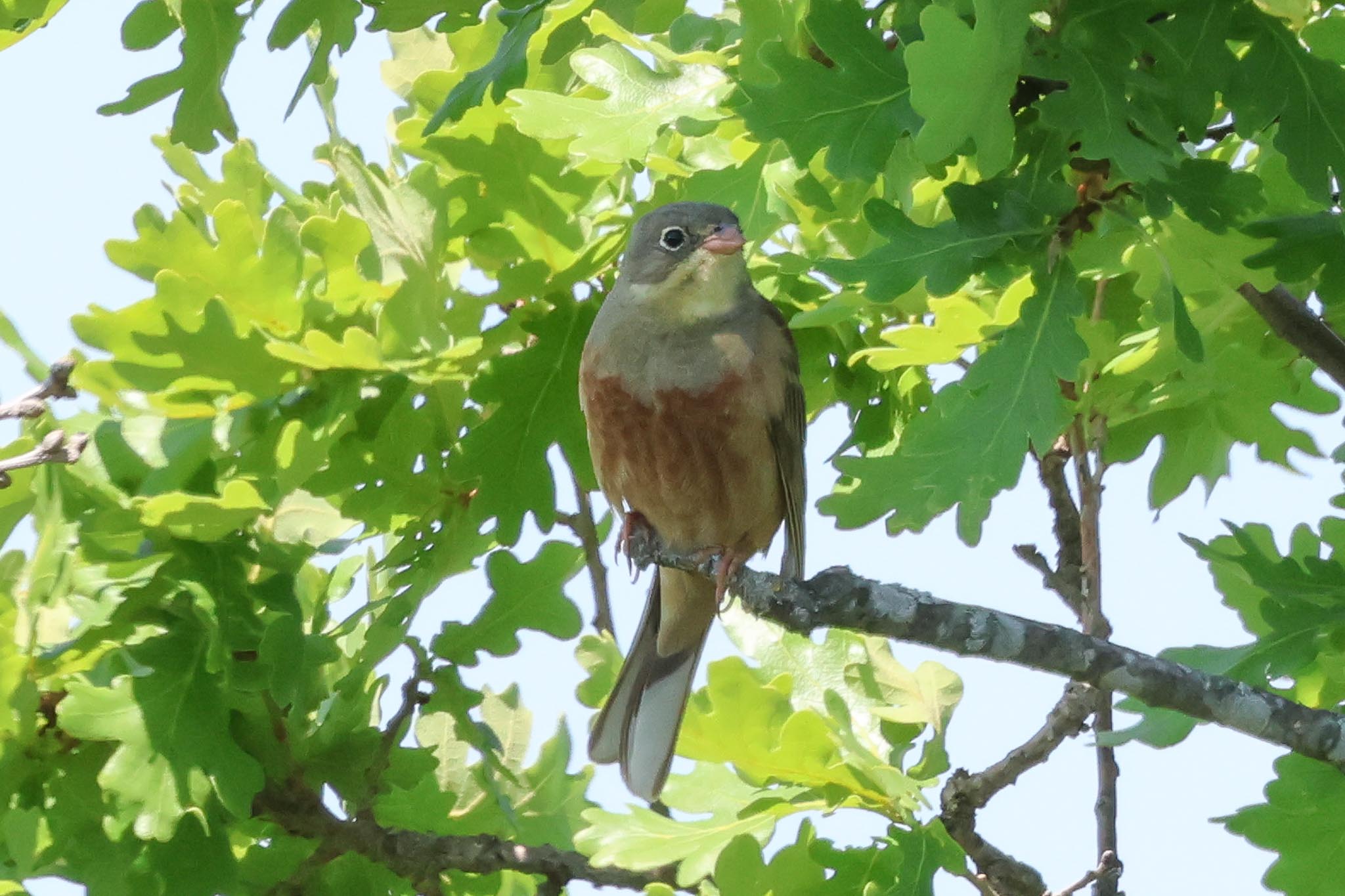
Back down to the road, we got back in the minibus again and drove round to a nearby monastery where we found a spot in the shade of some trees for lunch. We had a wonderful picnic here, with the bread and home-made zacusca a particular favourite! Even over lunch, there were more birds – a smart male Red-backed Shrike was hunting around the bushes, a female Levant Sparrowhawk drifted over and a Red-rumped Swallow and two Hawfinches flew past while we were eating.
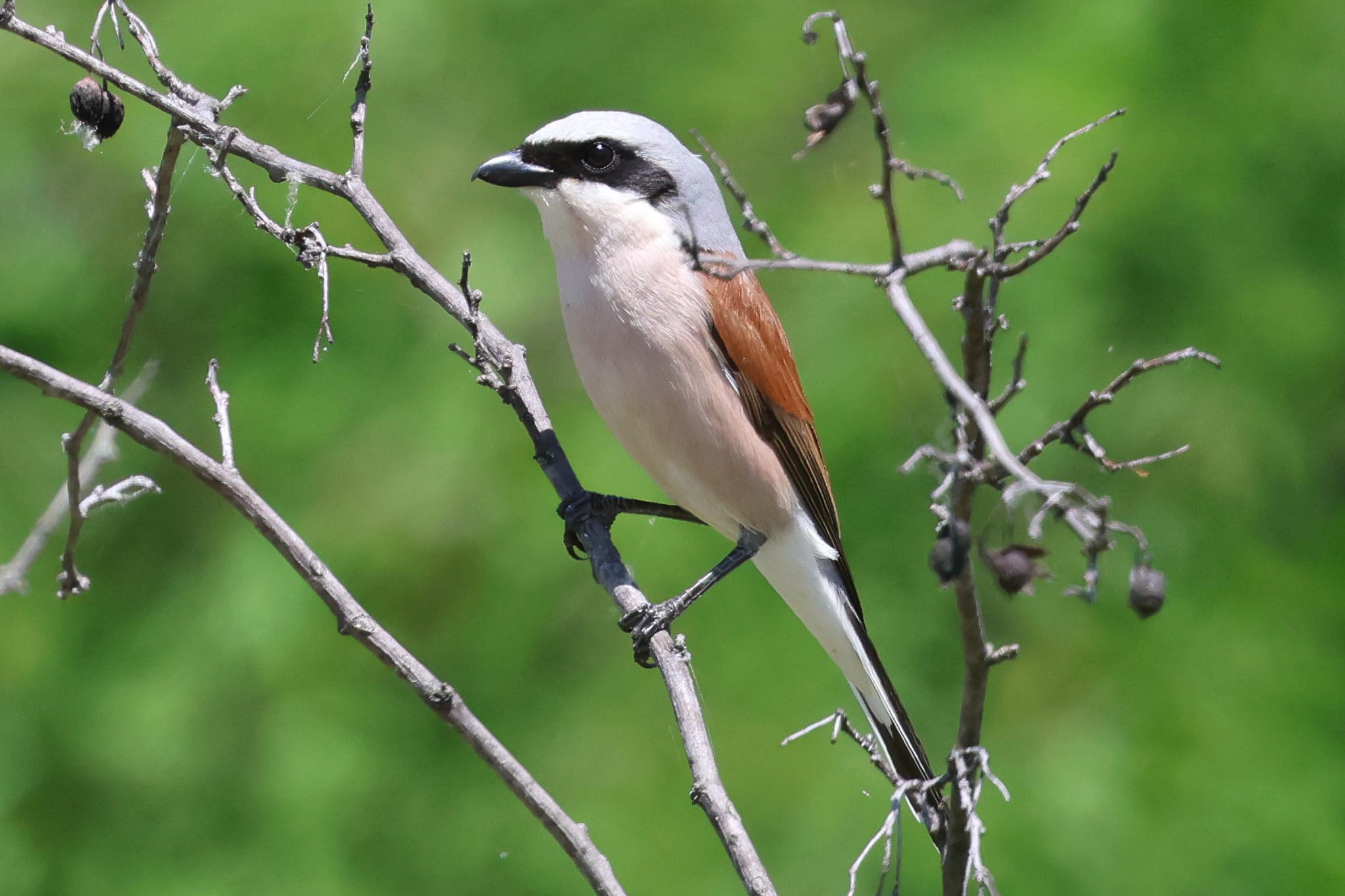
We were heading down to Vadu for the afternoon, but on the way we stopped at a petrol station for a comfort break. There were lots of Susliks on the grass on the edge of the forecourt and they are unusually confiding here – they are used to a constant succession of people – so we stopped to watch them. Much the best views we have had here.
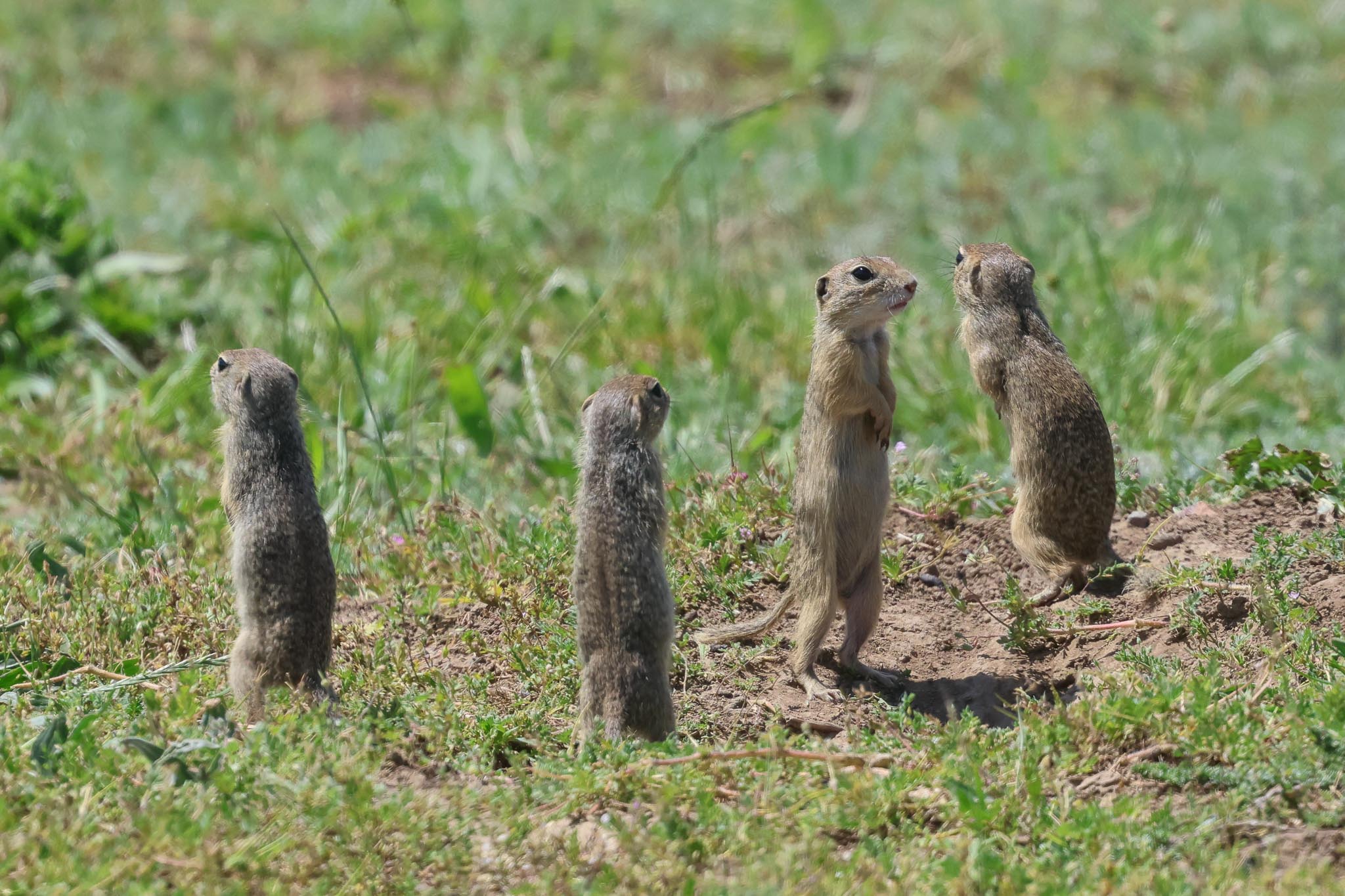
A dark Booted Eagle was hunting over the fields behind, a Wheatear landed on the back fence, and two Hoopoes flew back and forth. Continuing on, another Booted Eagle, this time a pale morph, drifted over the fields by the roads and there were lots of Marsh Harriers too. A Collared Pratincole shot across the road in front of us and back.
We turned onto a track across an area of grassy steppe, where there were more Susliks and several Isabelline Wheatears. There were lots of Bee-eaters around a sandy bank and perched on the old fence posts around a small cemetery and a Hoopoe feeding in the grass nearby. Two Long-legged Buzzards drifted over.
The track continued on beyond the steppe and out into cultivated fields. Lots of Yellow Wagtails had gathered round a puddle in the middle of the track, including several obvious intergrades but also our first pure-looking Black-headed Wagtail. A Golden Jackal ran across the track and when we stopped to look, a Calandra Lark landed on the track where the Jackal had been. We stopped and got out and got the Calandra Lark in the scope. Two more Calandra were singing above, and looking up we could see their black underwings. Continuing on, a Short-toed Lark landed on the verge and we pulled up to watch it running between the lines of a neighbouring maize field and then two more Jackals ran across the track.
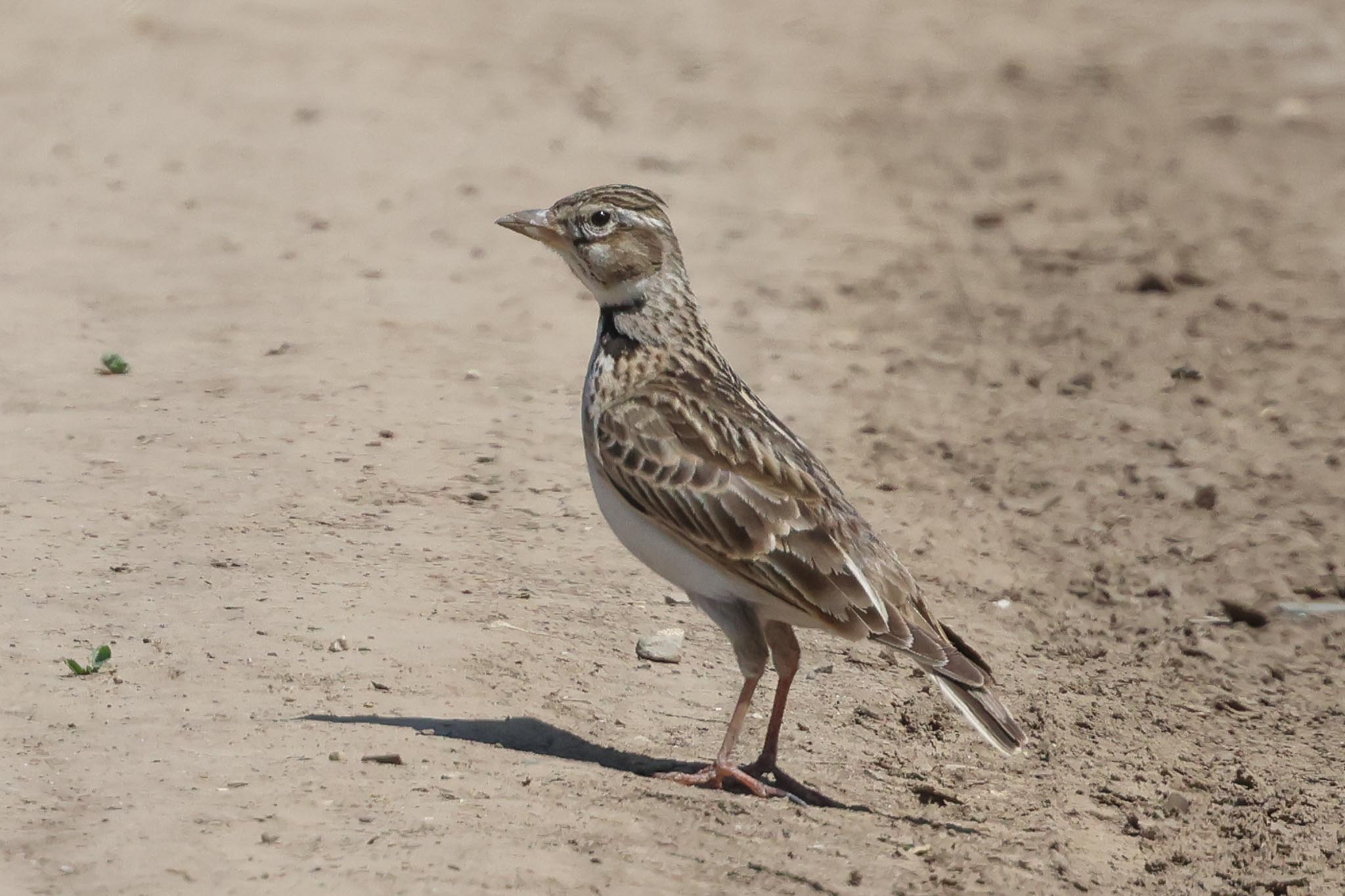
We stopped to check an area of bushes where a Barred Warbler had apparently been singing recently, but there was unfortunately no sign of it now. We could hear an Eastern Olivaceous Warbler, a Common Whitethroat and a Common Nightingale singing briefly. Another Long-legged Buzzard flew over pursued by a 1st summer male Red-footed Falcon, and then another Red-footed Falcon, this time an adult male, landed in a tree further back so we could get it in the scope. A Silver-studded Blue butterfly and a Forester moth were feeding on the flowers on the side of the track.
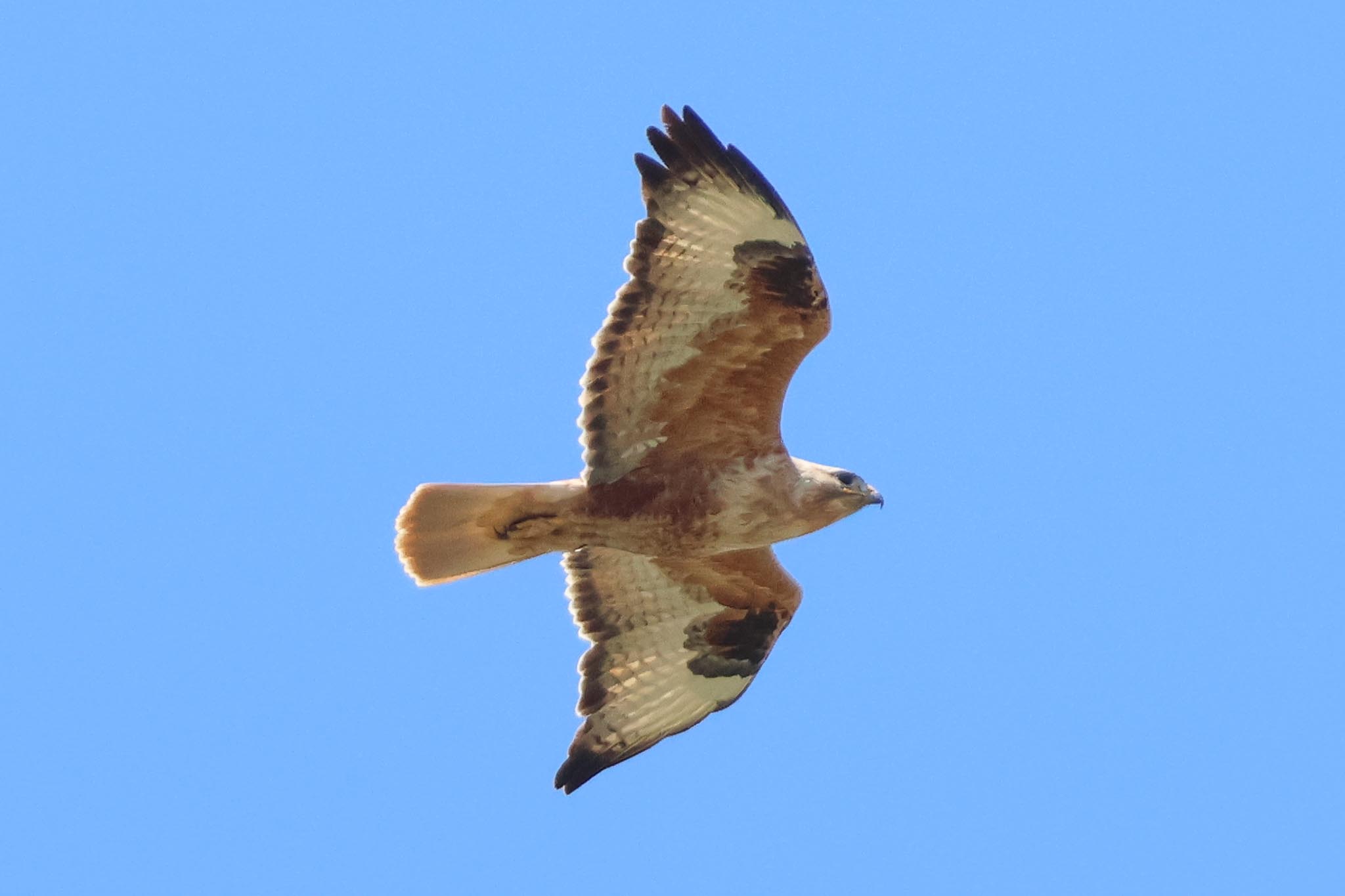
On to Vadu, and it was definitely the Day of the Jackal today! Another Golden Jackal was sleeping on the edge of the reeds behind a small pool just beyond the village, so we stopped for a closer look. We were not even sure if it was alive at first, so we gradually walked closer and it was only as we got to the edge of the pool that it woke up, looked at us, and sloped off into the reeds. Once we had walked back to the road, it reappeared out of the reeds with reinforcements – there were now two Jackals together staring at us from the edge of the reeds.
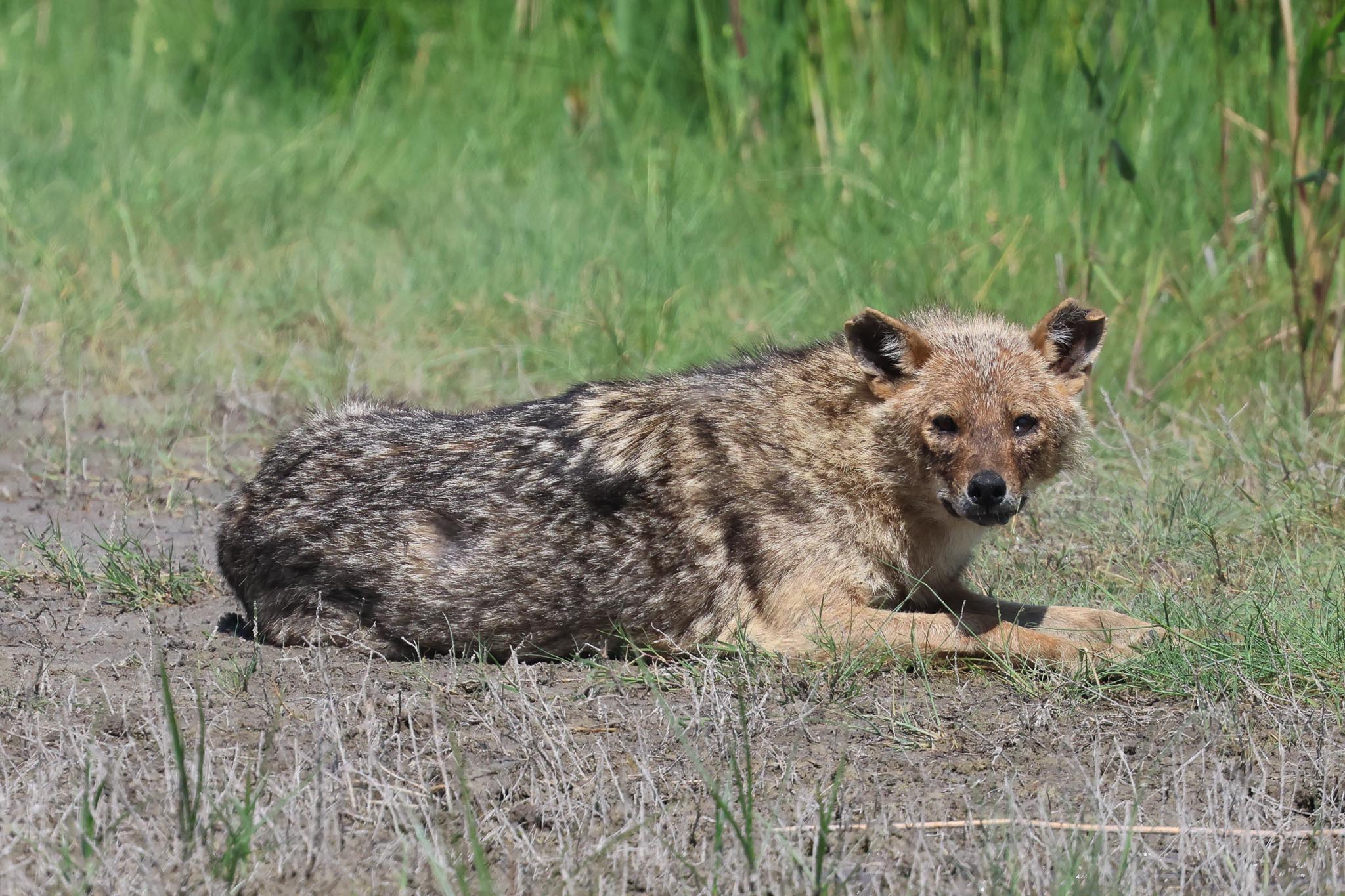
A Common Redshank dropped in on the pool, a Black-headed Wagtail was singing from the rushes nearby and three Ferruginous Ducks flew past with a Common Pochard.
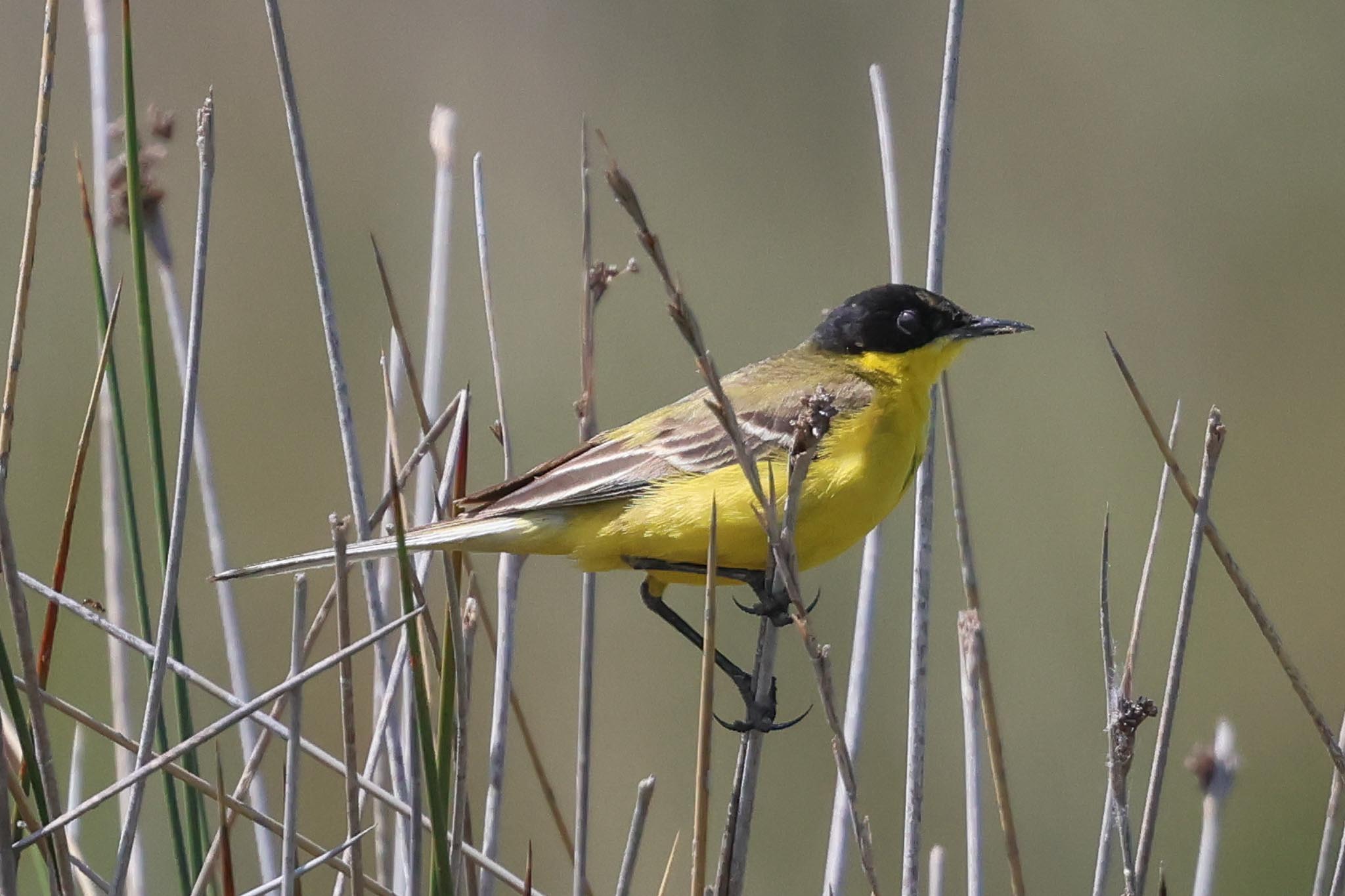
One of the birds we hope to see here is Paddyfield Warbler, which is at the very western extent of its range on the Black Sea coast. Unfortunately it was still very windy this afternoon, and nothing was perching up in the reeds singing today. We stopped and scanned and eventually one flew in from further back and landed in the reeds next to the road. It appeared to be collecting food and we had a couple of glimpses of it but it would not perch up in view and eventually flew back out into the reedbed away from us. A Bittern flew over the reeds and two Red-rumped Swallows flew past. There were lots of Red-footed Falcons hunting out over the reeds in the distance, and two flew overhead, a female followed by a male.
We walked a little further up the road and scanned the pools from up on the bridge. There were lots of waders here, the highlights being four Marsh Sandpipers, three Curlew Sandpipers in breeding plumage, at least four Little Stints and a Green Sandpiper. There was a nice selection of ducks too – a drake Northern Shoveler and a pair of Eurasian Teal were both new for trip list, a large flock of Red-crested Pochard was dozing on the edge of the water, several Ferruginous Ducks and a good number of Garganey were on the pool. A large gathering of Mute Swans was dozing too, with several White Pelicans preening and sleeping in with them; a lone Dalmatian Pelican flew over.
Driving on down to the beach, and there were lots of people here for the holiday weekend. A Crested Lark was running around in the car park, between the cars. We walked up onto the bank overlooking the Black Sea and looked out over the water.

The one benefit of the wind was that there were a few birds moving. The Cormorants were gathered on the net posts, drying their wings, and we could see a few Great Crested Grebes on sea. We picked up two Arctic Skuas flying north, presumably heading from the Indian Ocean overland to arctic Russia to breed. Lots of Common Terns were feeding offshore, along with several mostly distant Sandwich Terns, plus a single Caspian Tern flew south and a Little Tern came over our heads. There were a few gulls, with a nice adult Mediterranean Gull overhead, but the biggest surprise was a juvenile Kittiwake which flew south offshore. Common enough back home, but a rare bird here and ironically the rarest bird of the trip – the local birders were all very excited to hear about it!
It was a long drive to Tulcea from here, so we left Vadu and set off back. On the way, a Lesser Spotted Eagle over the fields by the road was pursued by a Marsh Harrier and a Long-legged Buzzard. We had a quick look in a nearby area for Stone Curlew, but the grass was very high and we couldn’t see them. Another Calandra Lark landed on the road ahead of us and a Hoopoe was feeding on the grass. We broke the journey with another stop at the service station where the Susliks were still on the grass.
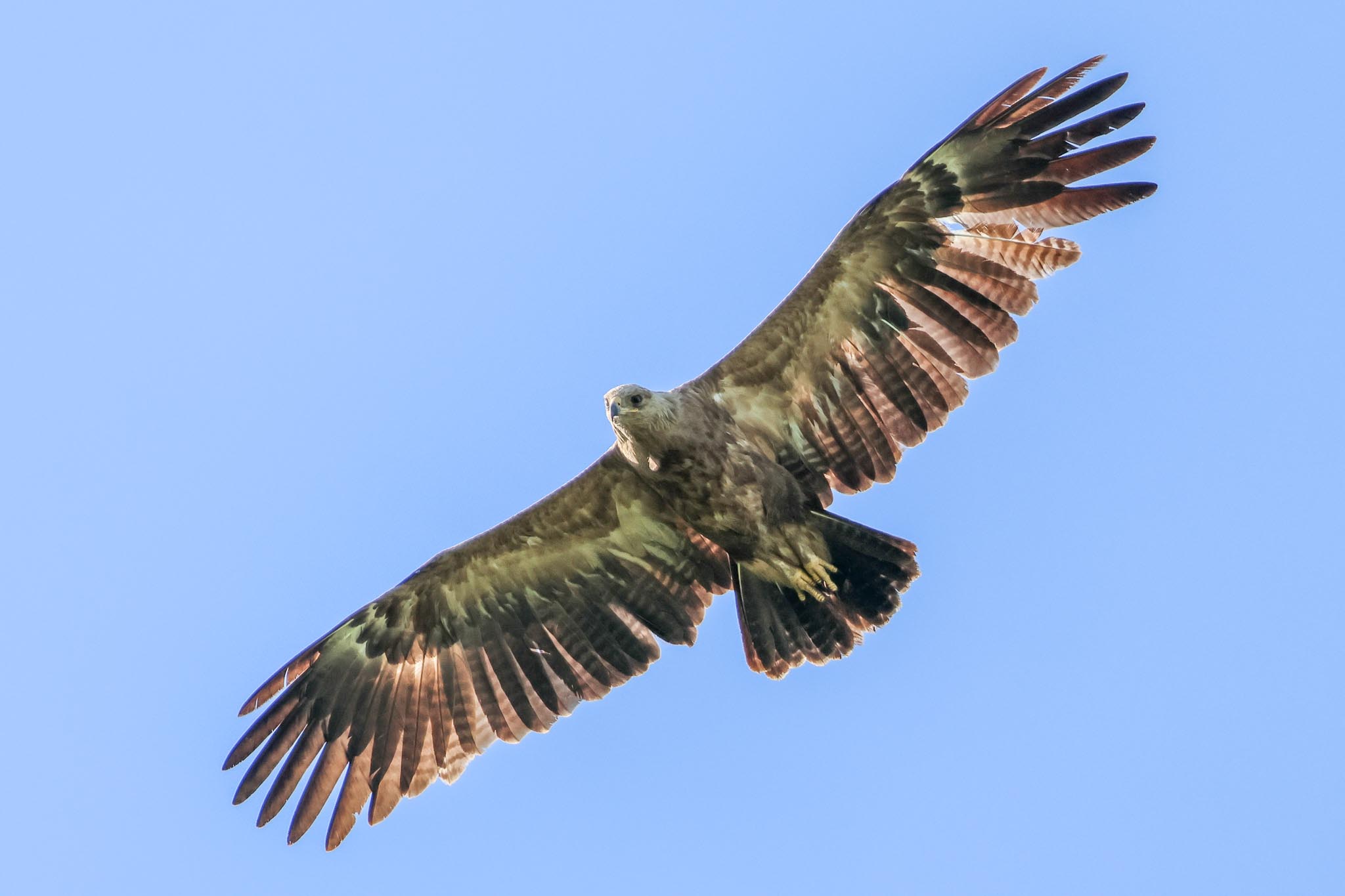
It was getting late by the time we got back, but our bags were waiting for us at the Hotel Select, our base for the next two nights, and the rooms were already allocated so we could go straight up. We met again in the restaurant for another lovely dinner of soup, grilled zander and local doughnuts.
Monday 5th June
A Syrian Woodpecker had been nesting in the willows in front of the hotel, but there was unfortunately no sign of it this morning for those who got up early to check. Starlings were singing outside the nest hole now and it appeared the young had fledged in the last few days. After breakfast, we boarded the minibus again and headed west out of Tulcea.
As we drove towards Somova, a Lesser Grey Shrike was perched on some bushes close to the road. We pulled up and got out to take photos – there were a pair of them. They seemed typically flighty at first and flew off back over the hill, but then chased each other back and one landed in a small tree right in front of us. Great views!
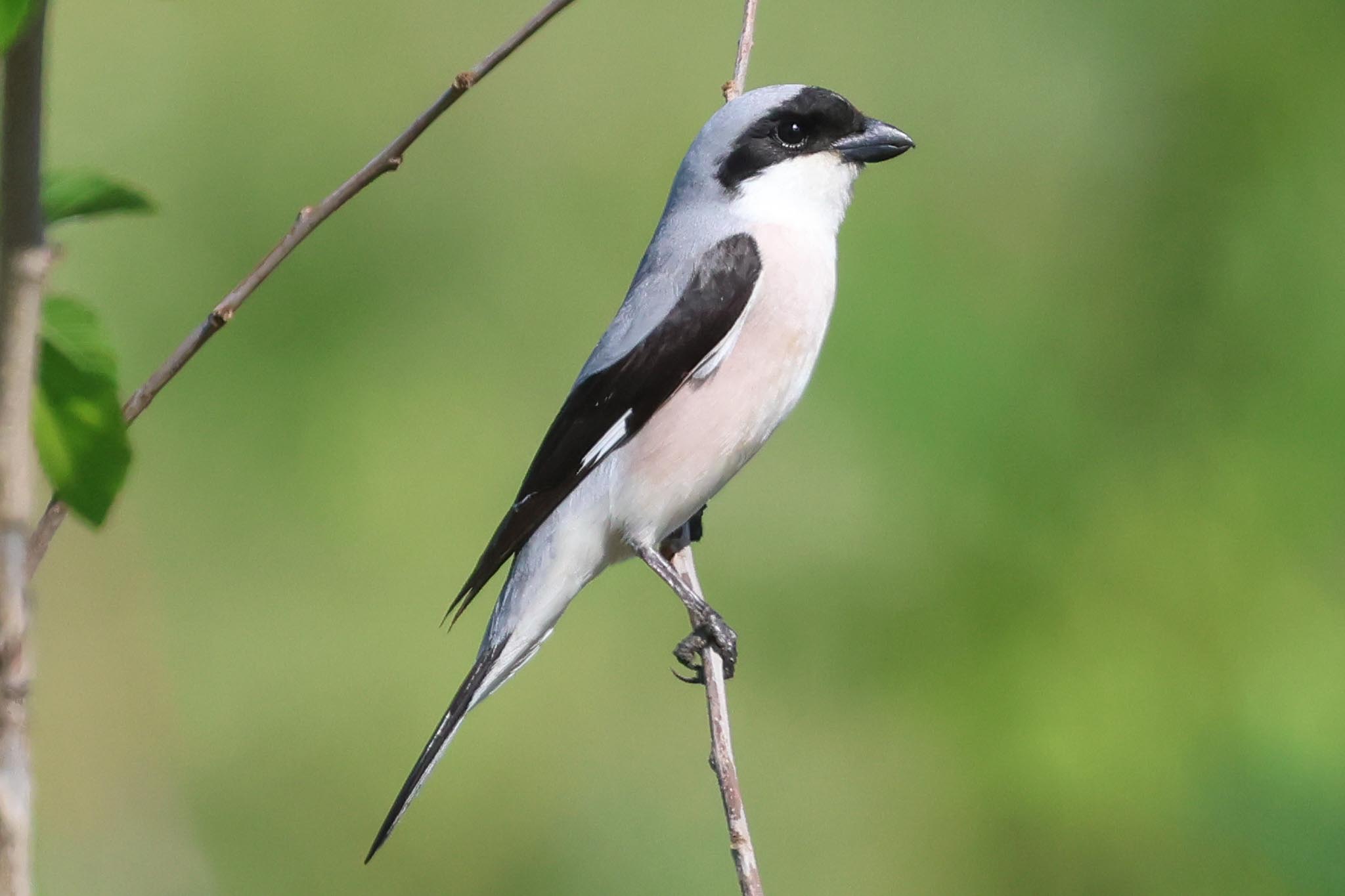
There were lots of other birds here too – Bee-eaters around the trees, Rollers and Corn Buntings on the wires, a Golden Oriole chased past by the local Starlings. A Black Kite circled above the ridge beyond but a male Montagu’s Harrier was harder to see, distantly flying low over the fields and quickly disappearing behind a hill.
We continued on to a nearby grassy hill. A Romanian couple were collecting wild herbs nearby when we arrived and as we got out we could smell the wonderful aroma underfoot. There were a couple of new butterflies for the trip, a Green-underside Blue and Small Heath in the grass, and as we walked up the hillside, a pair of Isabelline Wheatears started to alarm call and flew round ahead of us and a Hobby circled over.
There was a great view from here, looking over the very western part of the Danube Delta and across the river to Ukraine beyond. A young Black Stork circled over the slope away to our left, gained height quickly and drifted off west. There were lots of typical Delta birds distantly on the pools below us, Mute Swans and Greylags, a single Ferruginous Duck, Great Crested Grebes, Whiskered Terns, a Little Bittern in flight briefly dropping into the reeds, a Cuckoo calling in the distance.
Moving on, we were heading for Celic Dere, but we stopped by an old quarry on the way there. A Long-legged Buzzard nest was halfway up the face and so we got the scopes on it to see four juveniles. Two were sat down at first, but eventually all four stood up and started flapping, exercising their wings, and one made a foray down along the face.
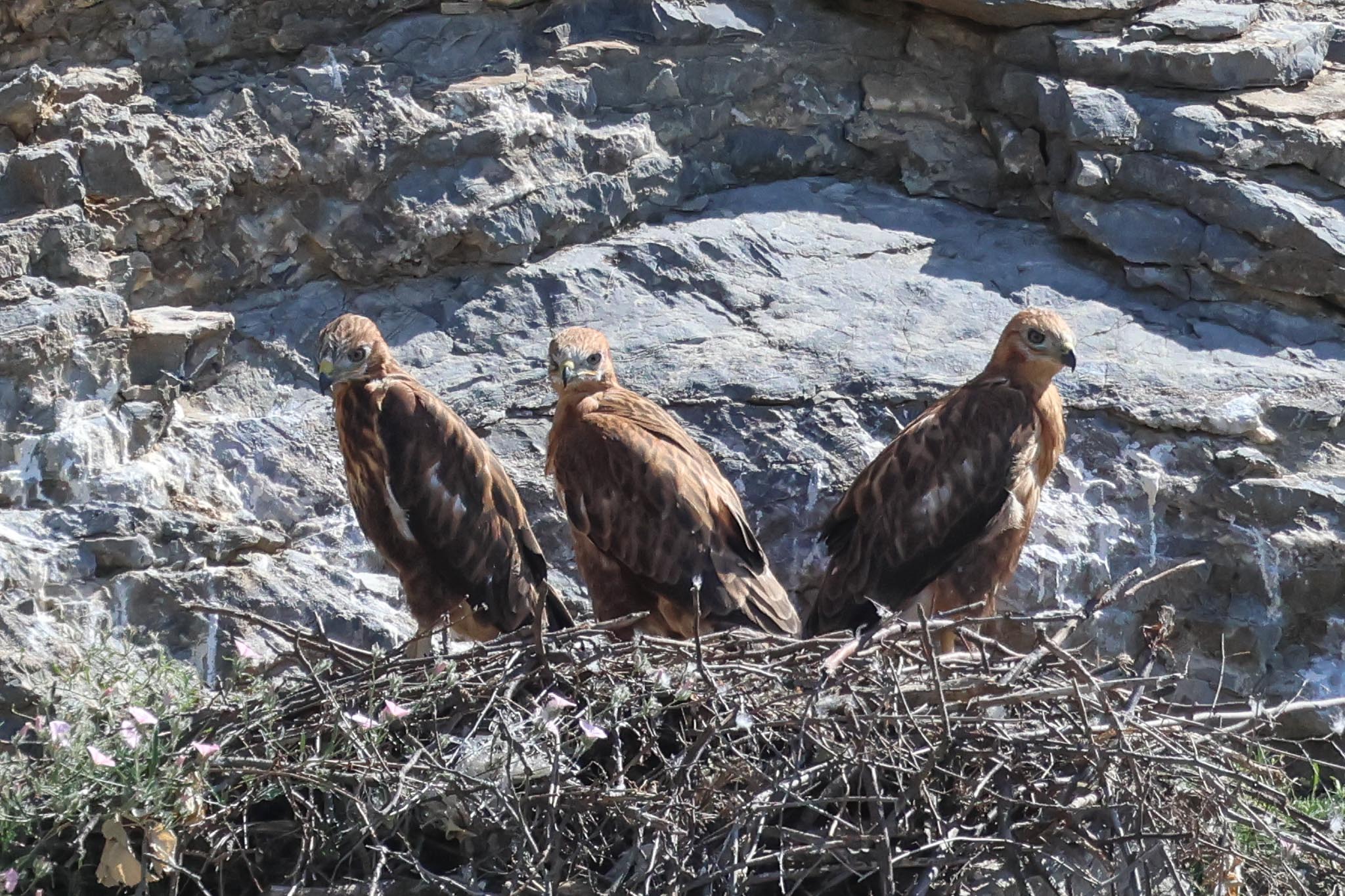
There were more Bee-eaters here and a smart male Red-backed Shrike in the bushes nearby. A couple of Corn Buntings were singing and we could hear an Ortolan Bunting higher up too. Two Northern Wheatears flicked around at the top of the quarry.
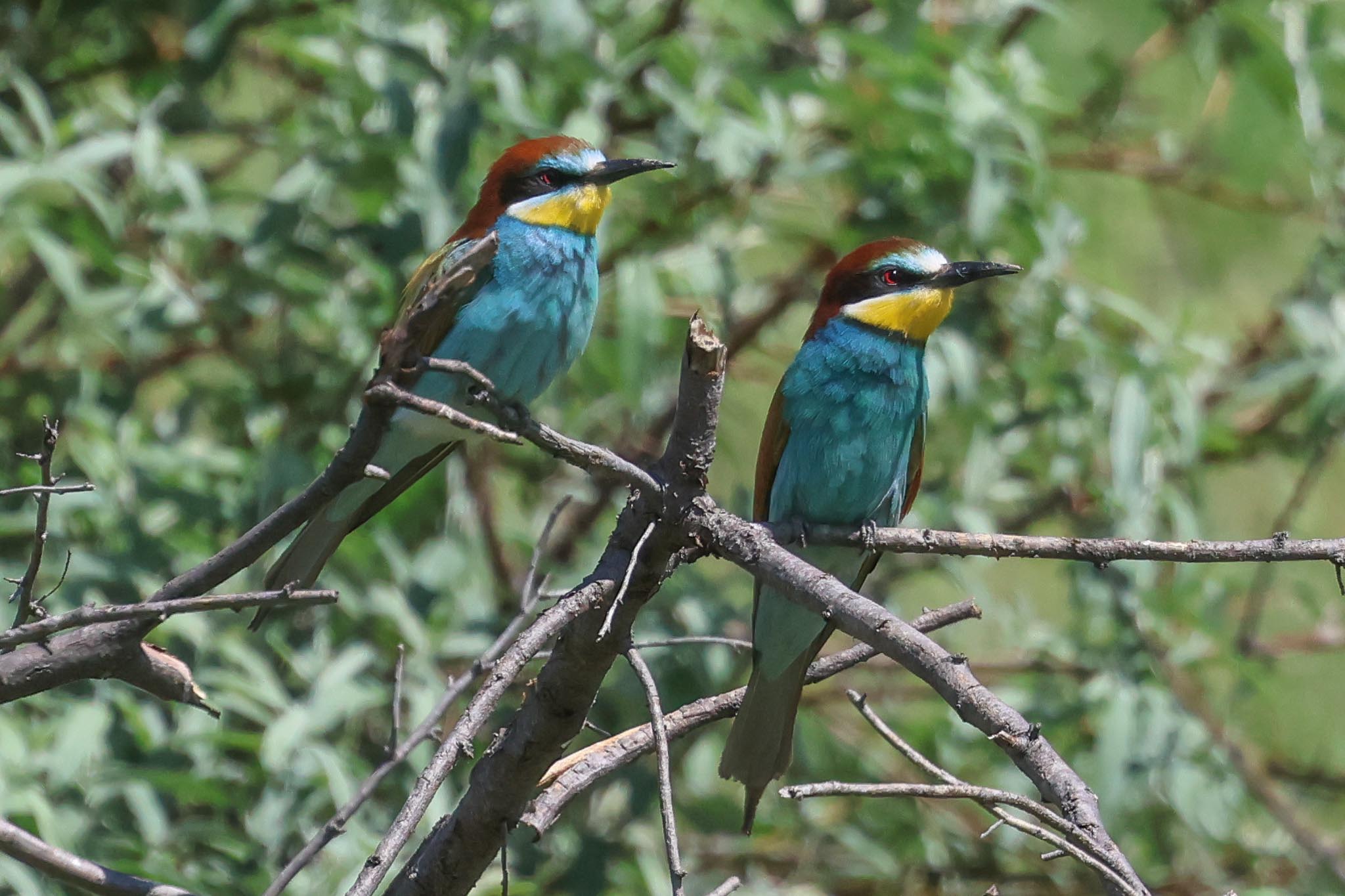
The car park and monastery at Celic Dere were surprisingly busy when we arrived (it was Monday but it turned out it was a local holiday), so we drove a short way along the track beyond and parked where it was quieter. As we walked on, a Middle Spotted Woodpecker was feeding in one of the trees by the track and we had great views of it above our heads. A Nuthatch flew in and out of the same tree and a Woodlark was singing and eventually flew in circled round above us.
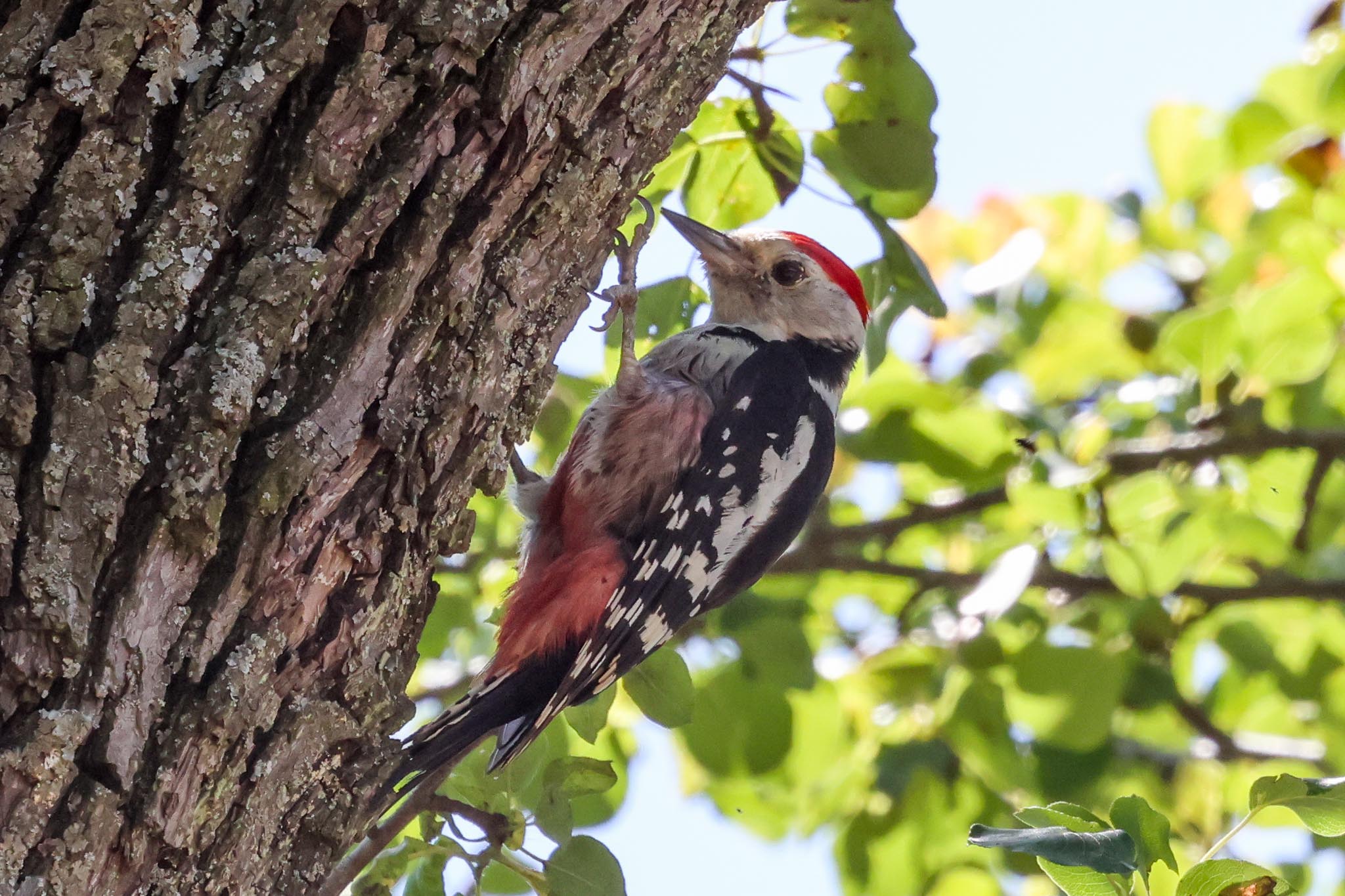
An Icterine Warbler flicked through the bushes down by the stream. We heard a Levant Sparrowhawk calling from somewhere up the hillside beyond but couldn’t see anything, until a short while later a female circled overhead. There were at least three Steppe Buzzards here too, displaying – the eastern race of Common Buzzard, we eventually got to see their tail patterns. There were lots of Golden Orioles fluting in the trees, and as we walked on, we had brief flashes of several as they flew in and out of the woods ahead of us. A Black Woodpecker flew across the valley and disappeared into the trees on the slope the other side.
We cut across the field and up onto the track through the wood. We could hear Wood Warbler and Icterine Warbler singing, but our attention was drawn immediately to a pair of Red-breasted Flycatchers flicking around in the trees by the path. We realised they were nestbuilding in a broken bough, so we trained the scope on them and had great views of the pair coming in and out and perching in the nearby trees.
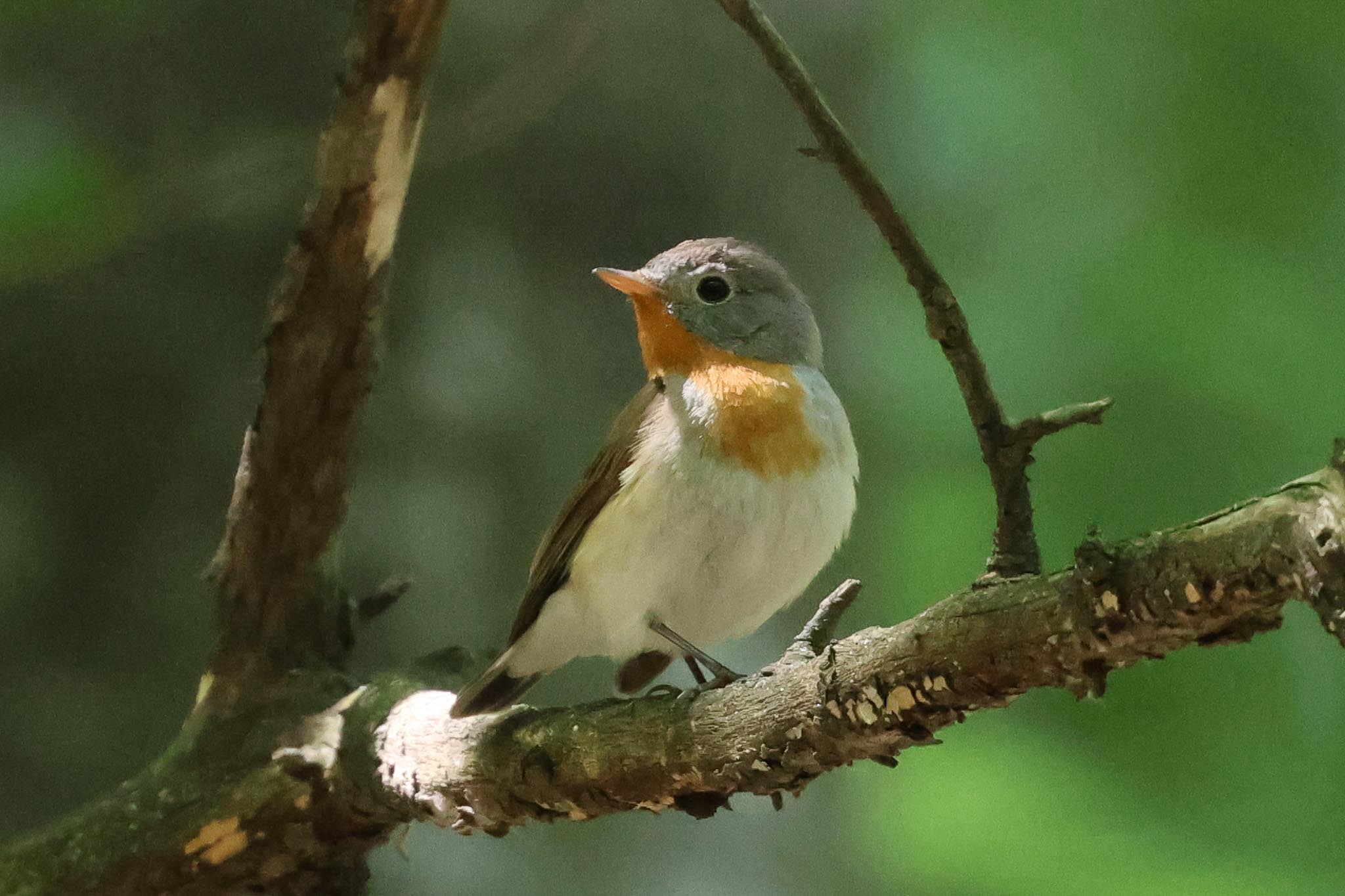
We then turned our attention to the Wood Warbler, but it was singing from the trees further up the slope and hard to see at first. We were distracted by a Black Woodpecker which was feeding in the trees beyond, knocking loudly, and eventually it flew down through the canopy overhead and disappeared off the other side. Then we realised the Wood Warbler was now singing much closer to us and we found it above a small gully just above the track before it disappeared off back up the slope. A Robin was singing on the edge of the trees here too.
There were a few mosquitoes in the shade of the woods, so we decided to head back. Walking along the track, another Icterine Warbler was singing in the trees so we stopped and watched it flicking around high above our heads. Out of the trees, we stopped for lunch in the open area where we had seen the Middle Spotted Woodpecker earlier – it was still calling from the same tree – another delicious picnic and our last chance to enjoy the zacusca. We were just finishing when a Honey Buzzard flew in low over the trees and started to circle up opposite us.
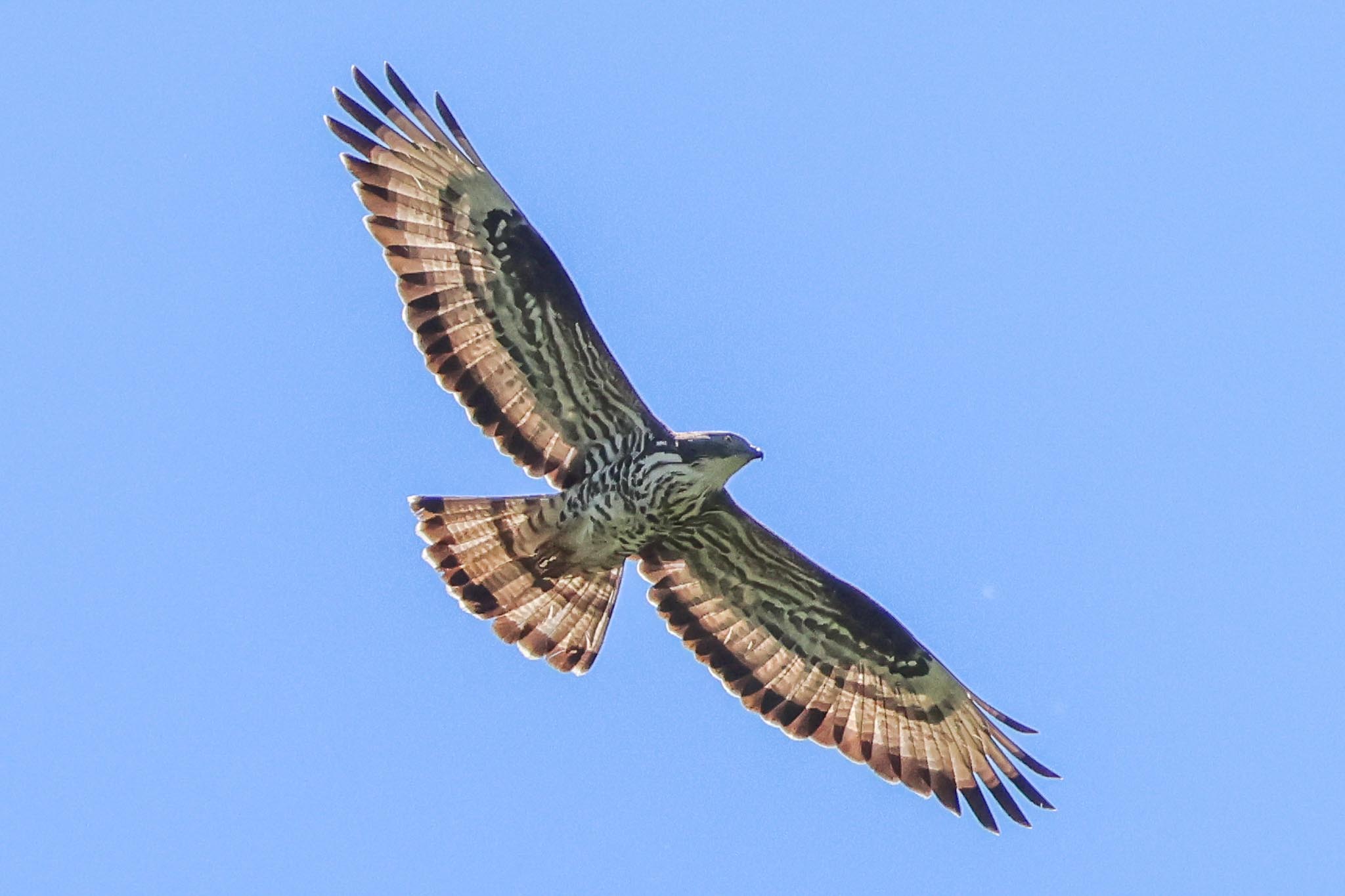
Our destination for the afternoon was Macin. We had a brief stop to scan the faces of a sandy quarry next to the road, which was full of Bee-eaters, and a Little Owl was perched at the entrance to one of the larger holes too. Then in Macin village, we stopped at the petrol station to fill up the minibus and a chance to use the facilities or buy an ice cream, and a pale morph Booted Eagle appeared briefly over the other side of the road, but disappeared behind some trees and didn’t reappear.
Turning off the road onto the bumpy track towards the mountains, a Brown Hare ran across in front of us, and there were several Corn Buntings and a Turtle Dove on the wires. We stopped and got out and a male Black-headed Bunting was singing from one of the concrete pylons further up, which we got in the scopes, our first target here. A Lesser Grey Shrike was feeding on the fence beside the track too and several Spanish Sparrows were nesting in the trees above.
Out onto the grassy lower slopes, there were a couple of Isabelline Wheatears. We parked and set off up a track towards the hills. It was mid afternoon and hot now, but as we got to the mouth of the valley, a Red-backed Shrike was in the trees and an Ortolan Bunting was singing from up on the rocks above. We stopped and scanned the rocks and found our first Pied Wheatears – always high above us, but nice views in the scope of some of the closer ones.
Continuing on, a Turtle Dove was purring from the bushes in the valley and a Common Nightingale was singing. Hearing the hirundines alarm calling, we looked up to see a smart male Levant Sparrowhawk circling up. Having shaken off its pursuers, it dropped back down to the bushes on the slopes and we saw it later flying round in and out of the rocks. Hopefully it wasn’t hunting the Pied Wheatears!
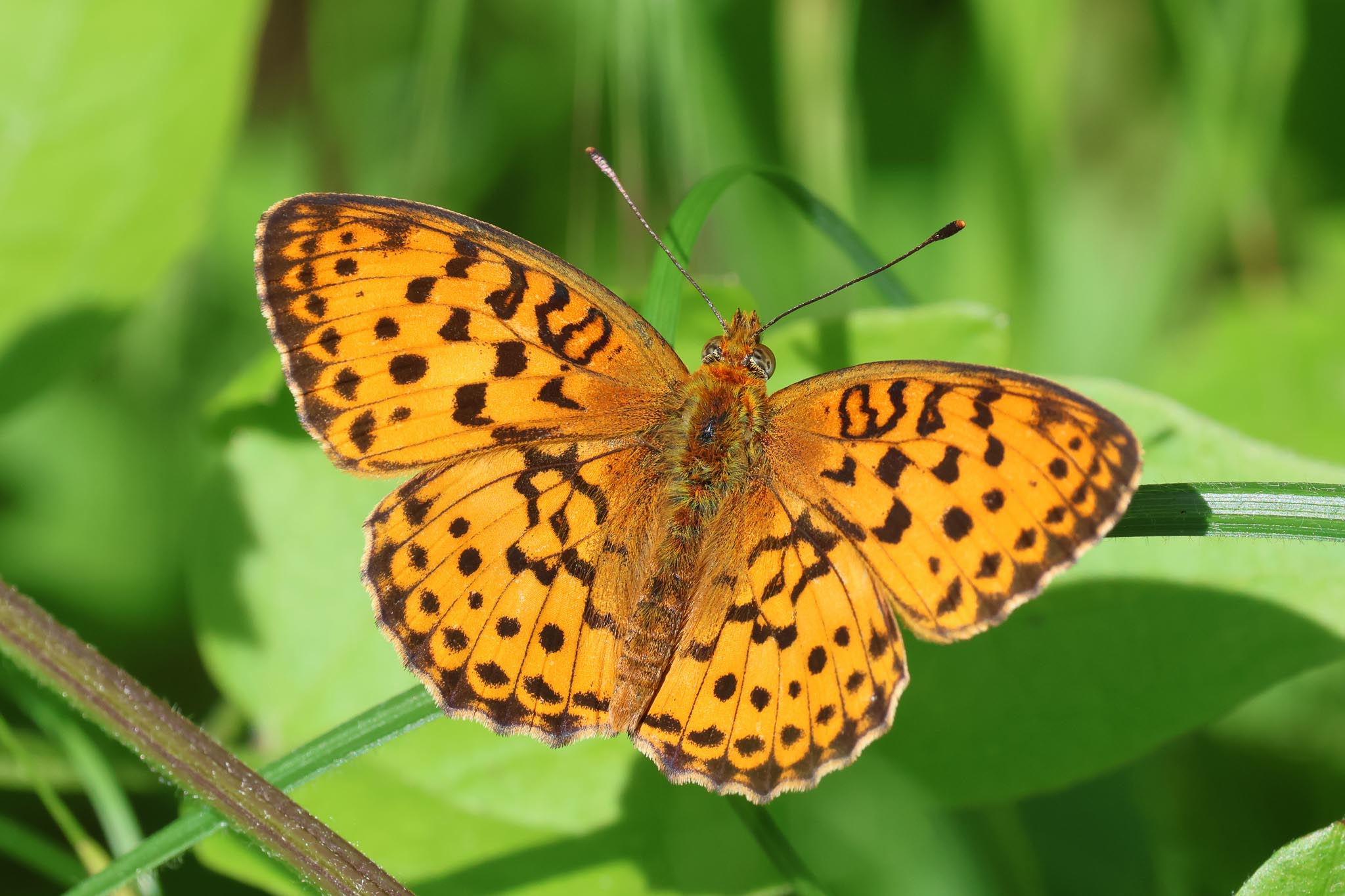
There is a little trickle of water along the valley here and some small pools and this area was alive with butterflies – Orbed Red Underwing and Mallow Skippers basking on the bare ground, Lesser Spotted, Niobe, Queen of Spain and Cardinal Fritillaries, Comma, Green-underside Blue, Brown Argus, Small Whites and Small Skippers on the wet patches. Looking at the ground, we were surprised to find a Dusky Clearwing moth in with the butterflies. A nice distraction in the heat of the day and there was a little shade here too, while we sorted through all the lepidoptera.
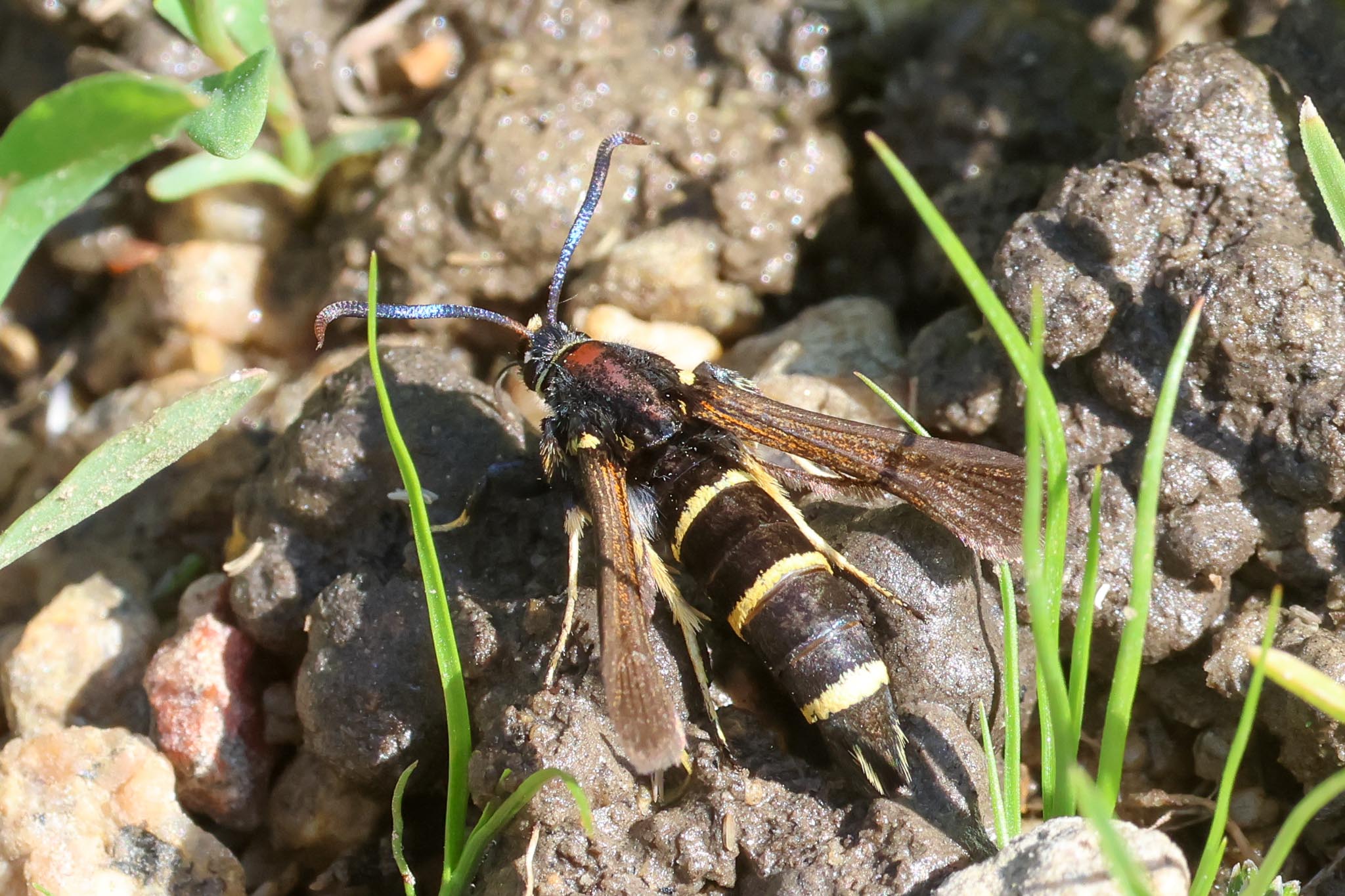
Scanning the crags high above, we found several more Pied Wheatears and a Woodlark on the rocks, and a Roe Deer in a grassy patch in between. We were hoping for a Rock Thrush – a distant bird looked like a possibility but was too far away in the heat haze to tell and by the time we had got high enough to see better it had disappeared. It was time to make our way back down. As we descended out of the valley, a Turtle Dove was displaying now above the trees and a Balkan Wall Lizard was on the path but the surprise of the afternoon was a European Nightjar which churred briefly from the bushes on the other side of the valley.
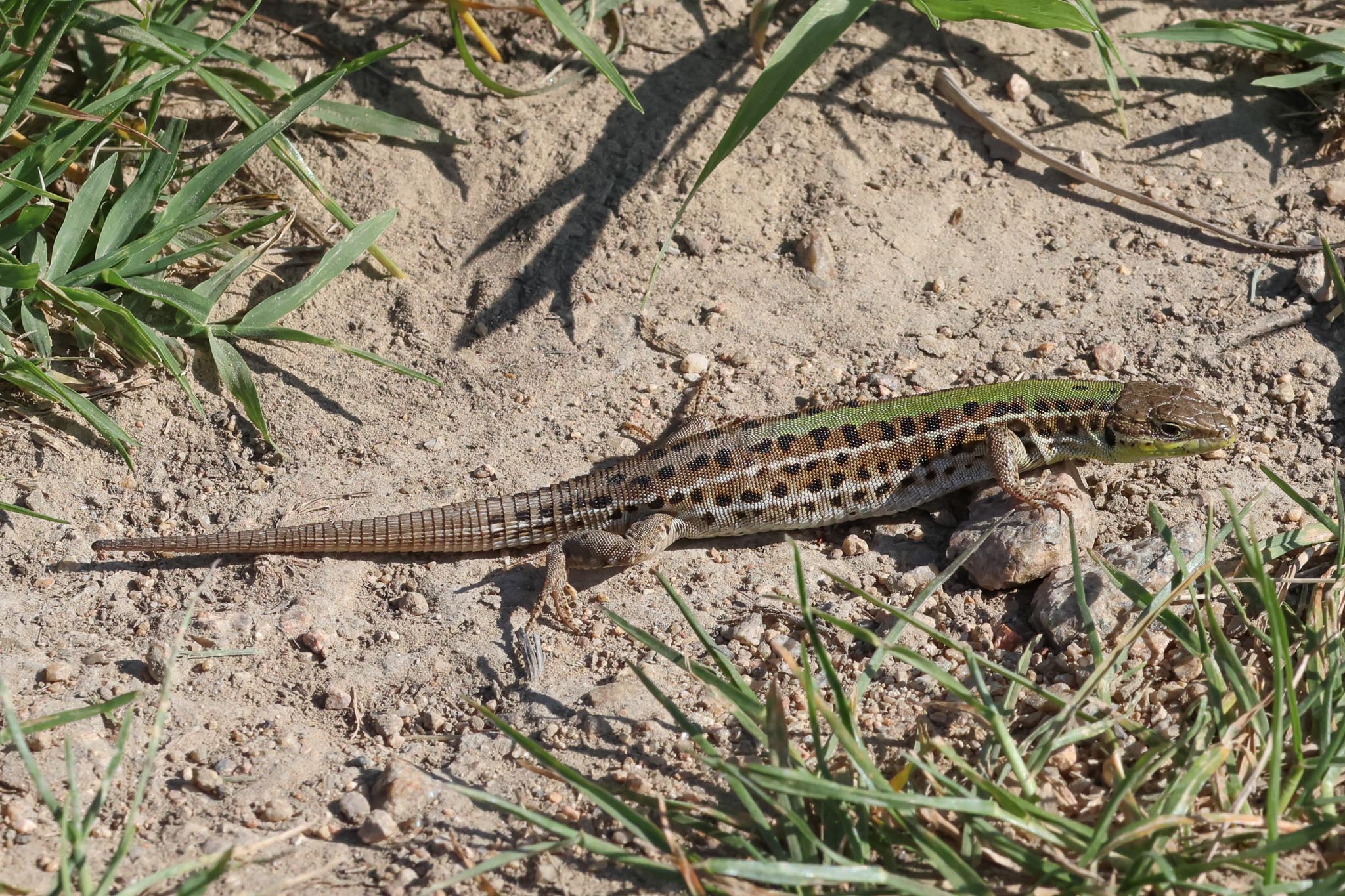
It was about an hour’s drive back to Tulcea and then time for a beer out in the sun on the terrace before our last dinner of the trip, fried breaded local cheese to start, then traditional tochitura followed by pancakes.
Tuesday 6th June
Our last day in Romania, and we had to travel back to Bucharest today to catch our afternoon flight back to Luton. After breakfast in the hotel, we checked out and met Florin outside with the minibus. We set off in good time, having allowed plenty of flexibility for some stops on the way. We hadn’t gone too far when we started to see several raptors already circling up over the fields either side of the road as we drove along – a Lesser Spotted Eagle, Marsh Harrier and a couple of Common Buzzards. They were up early today! A few Yellow Wagtails came up from the verges and a Northern Wheatear flew up from a patch of steppe by the road flashing its white rump.
We had seen plenty of Red-footed Falcons already, but only in flight or more distantly perched, so our first stop was at a rookery where some falcons were nesting. We pulled off the road into a grassy field and as we came to a halt a Suslik was staring at us from the ground just a couple of metres away. We got out and could immediately see a couple of Red-footed Falcons flying around over the trees, and a female drifted across and over our heads.
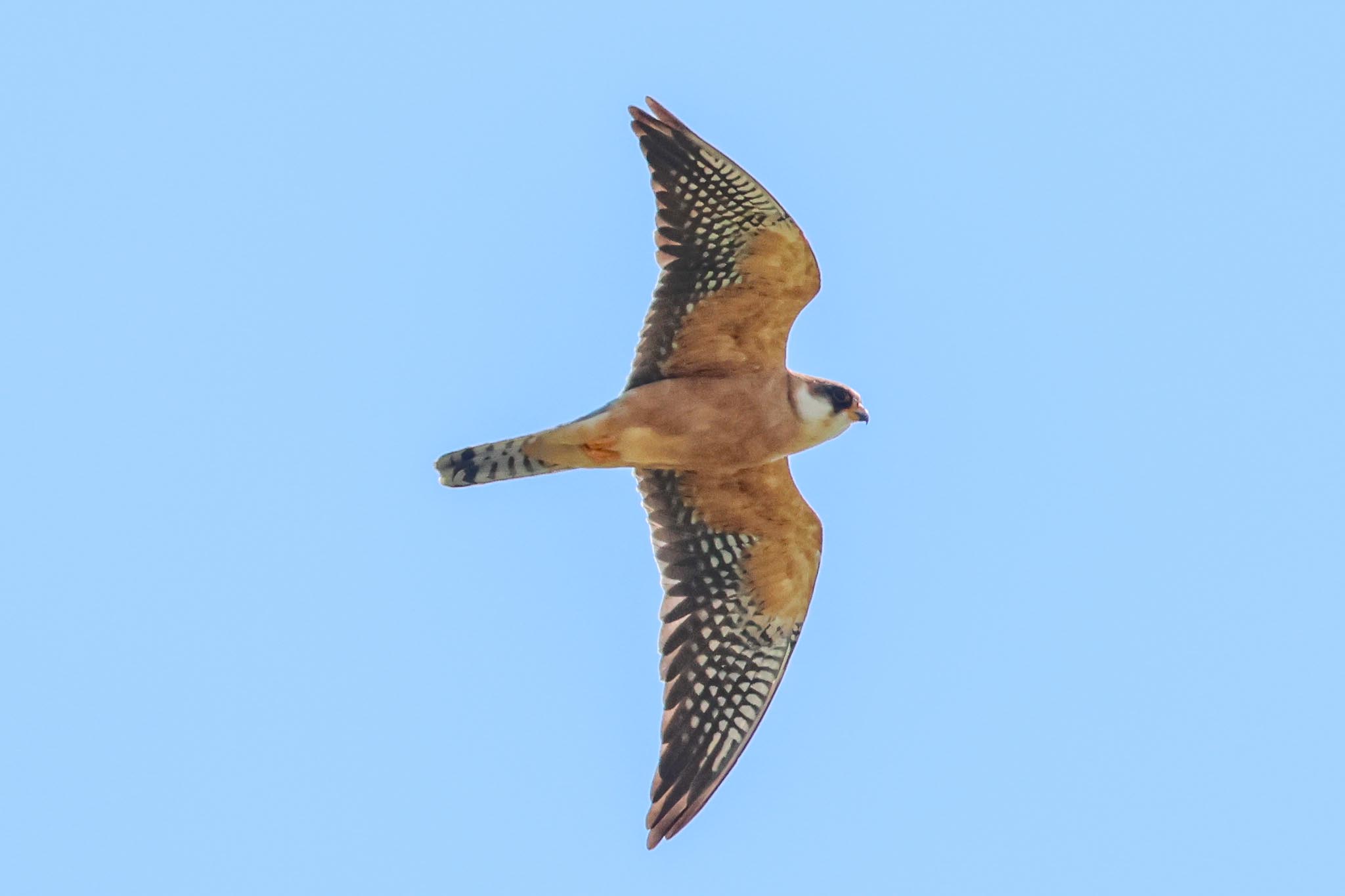
Scanning the trees we found a male Red-footed Falcon perched on a branch and got the scope on it – finally we could get a really good look at its red feet! A female was perched nearby too, so having seen the male we turned the scope on it next. There were a few Bee-eaters over the trees here too, a Corn Bunting was singing by the road and we could hear a Great Reed Warbler from a small marshy area across the other side and a Cetti’s Warbler shouting once or twice from there too.
It was not far from here to the lake where we had stopped on the journey out, so with plenty of time we decided to call in there again. We were hoping to get the scope on a perched Little Bittern and as we pulled up we saw one flying away over the water. It landed in a large clump of reeds so we got straight out and put the scope up, but it had disappeared in out of view. As we looked to see if we could find another one, we found lots of other things to look at. A Little Grebe was a nice late addition to the trip ‘seen’ list (we had only heard them up to now).
A single adult Ruddy Shelduck was chaperoning ten juveniles across the water – they were different sizes so obviously from two different broods. There was a nice selection of ducks, including a last couple of Ferruginous Ducks and a Garganey, plus lots of Mute Swans and Greylag Geese. A flock of eleven Spoonbills flew up from the long grass and circled round over the water. Four Pygmy Cormorants were perched low down on the reeds and a couple of Whiskered Terns flew past.
A Hobby attacked a Starling which was in the grass on the edge of the water and nearly caught it. The Starling just managed to escape and then flew out over the edge of the lake and dived straight into one of the clumps of reeds where the Hobby couldn’t get to it. A pair of Hoopoes were flying round the cattle pens behind us and when they landed on the roof of one of the low barns, we watched them mating. One or two ‘dombrowskii’ Yellow Wagtails were in the cattle pens too.
Time was ticking so we had to tear ourselves away from our last bit of Romanian birding and get back on the road. The long haul back to Bucharest was fairly uneventful – there were a few birds around the rice fields and floods either side of the Danube as we passed, herons, egrets and more Glossy Ibis. We managed to see our last Rollers of the trip on the wires, although there weren’t many along the road this time. We had a quick stop at a service station to use the facilities shortly after we set off, and another nearer Bucharest where we ate our packed lunches and had a chance to buy ice creams in the sunshine. We got to the airport pretty much bang on time at around 3pm and were quickly through check-in and security. The plane left pretty much on time and we arrived back at Luton early – we were not due to touch down until 6.55pm but we actually landed at 6.40pm. Even better, after a seamless transit through security our bags were already waiting for us going round on the carousel when we got there, so we said our goodbyes and headed for home earlier than we had thought. It was cold and grey outside – typical English summer. What would we give to be back in Romania? There’s always next year…
















